Автор:
05 декабря 2022 16:48
С началом бума мобильной связи появлялось столько разных, удивительных и необычных моделей телефонов, что невозможно было перепробовать их все. Давайте отправимся на воображаемой машине времени в не очень далекое прошлое и оценим полет дизайнерской мысли. Эти замечательные, крепкие и маленькие устройства выглядят так круто!

1. «Сегодня бабушка подарила мне наш старый телефон на новоселье. Он крякает, когда звонит. Я жутко боялся этого телефона в детстве»
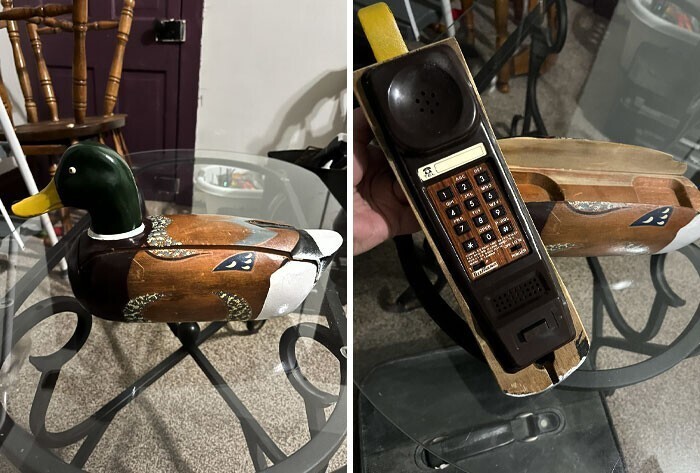
Источник:
2. «Нашел свой старый сотовый телефон с дополнительной клавиатурой, чтобы проще было писать смс»
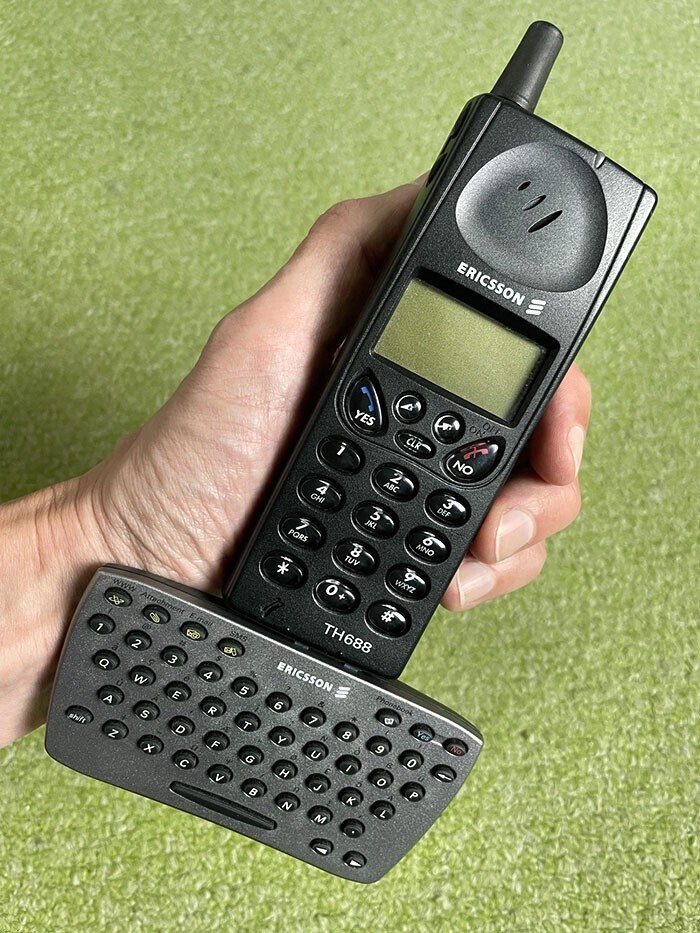
Источник:
3. Motorola StarTAC Rainbow
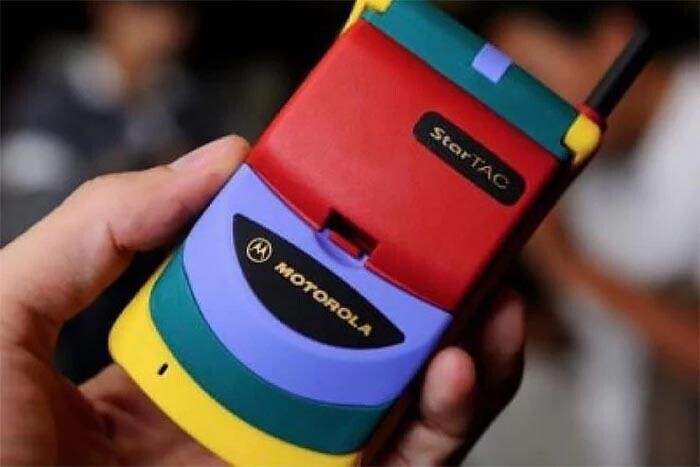
Источник:
4. Квадратный ротатор Motorola Flipout Mb511
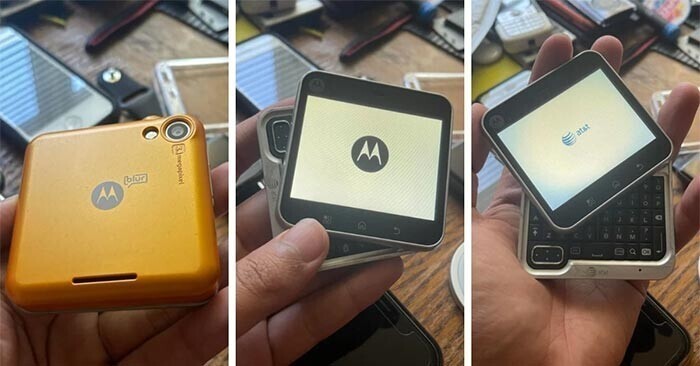
Источник:
5. Siemens Xelibri 8
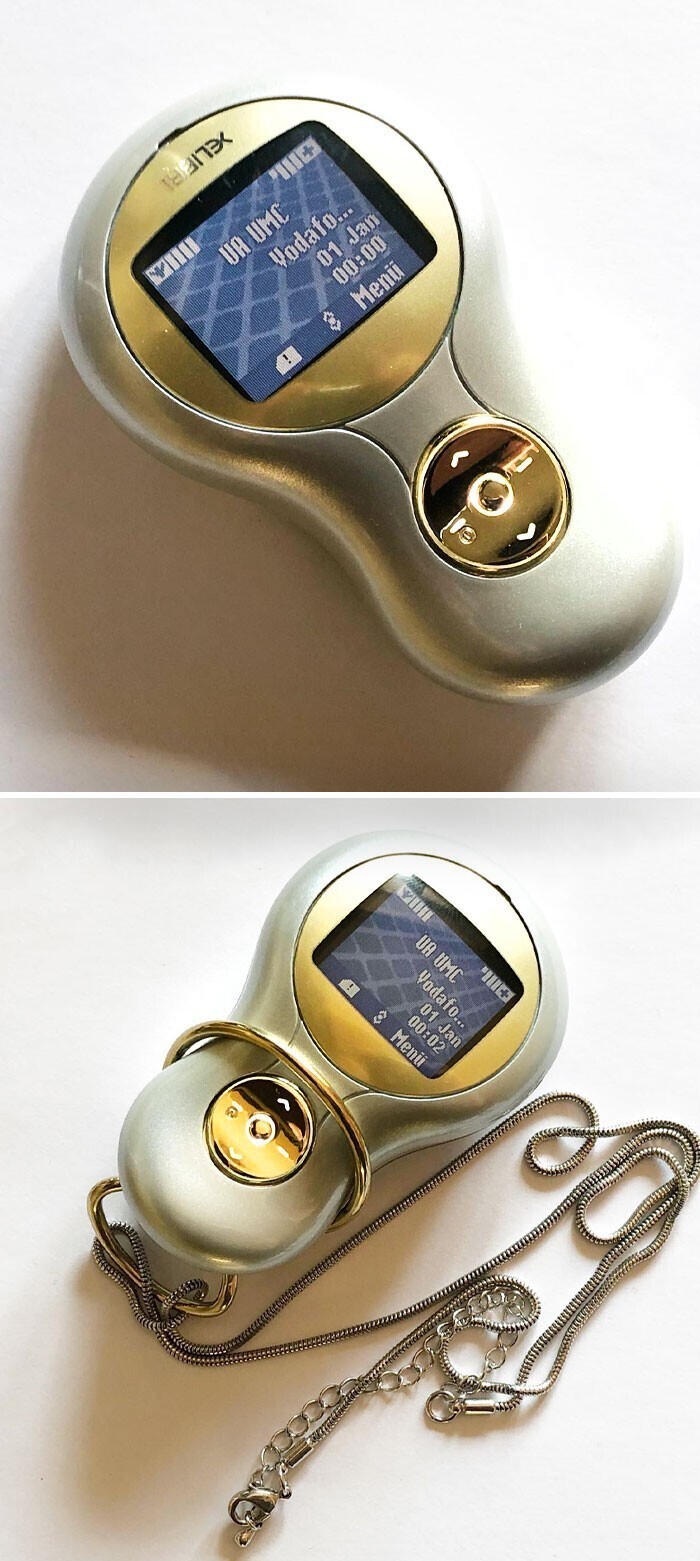
Источник:
6. Simens SK65
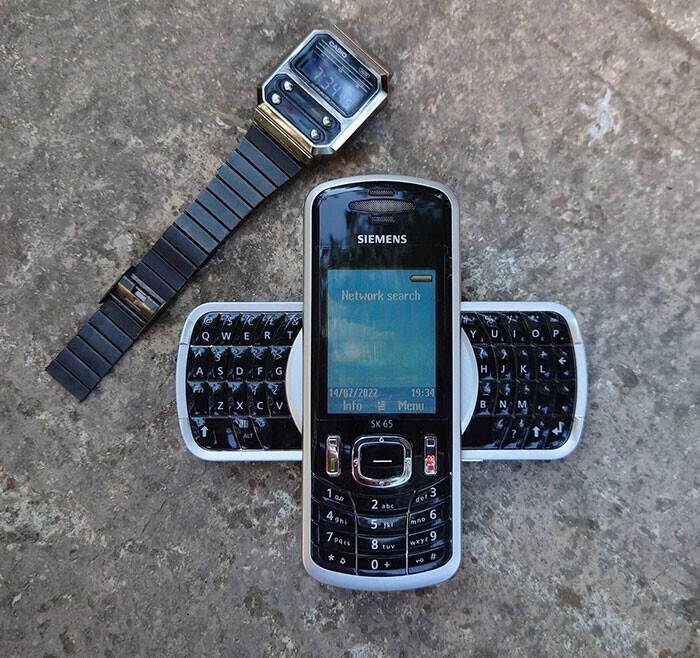
Источник:
7. Nokia 7600
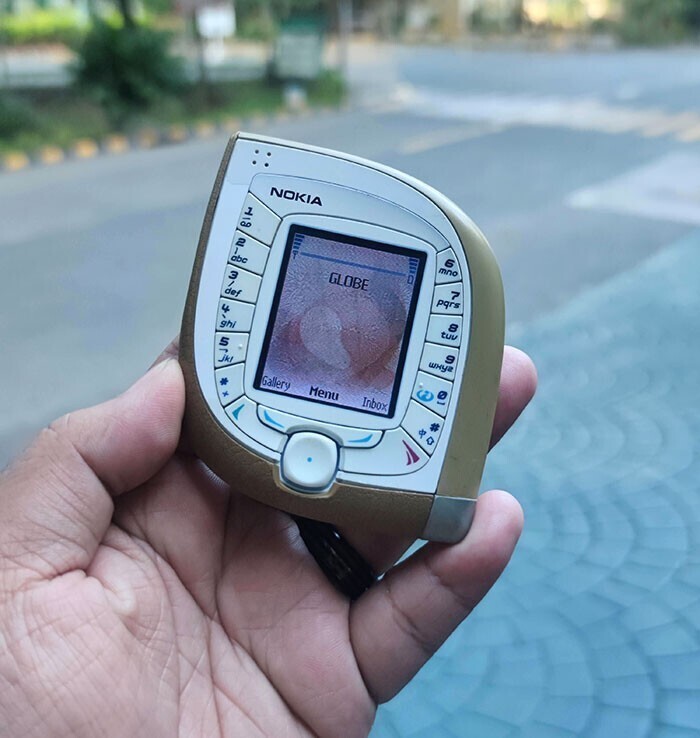
Источник:
8. Премиум-смартфон Motorola Aura
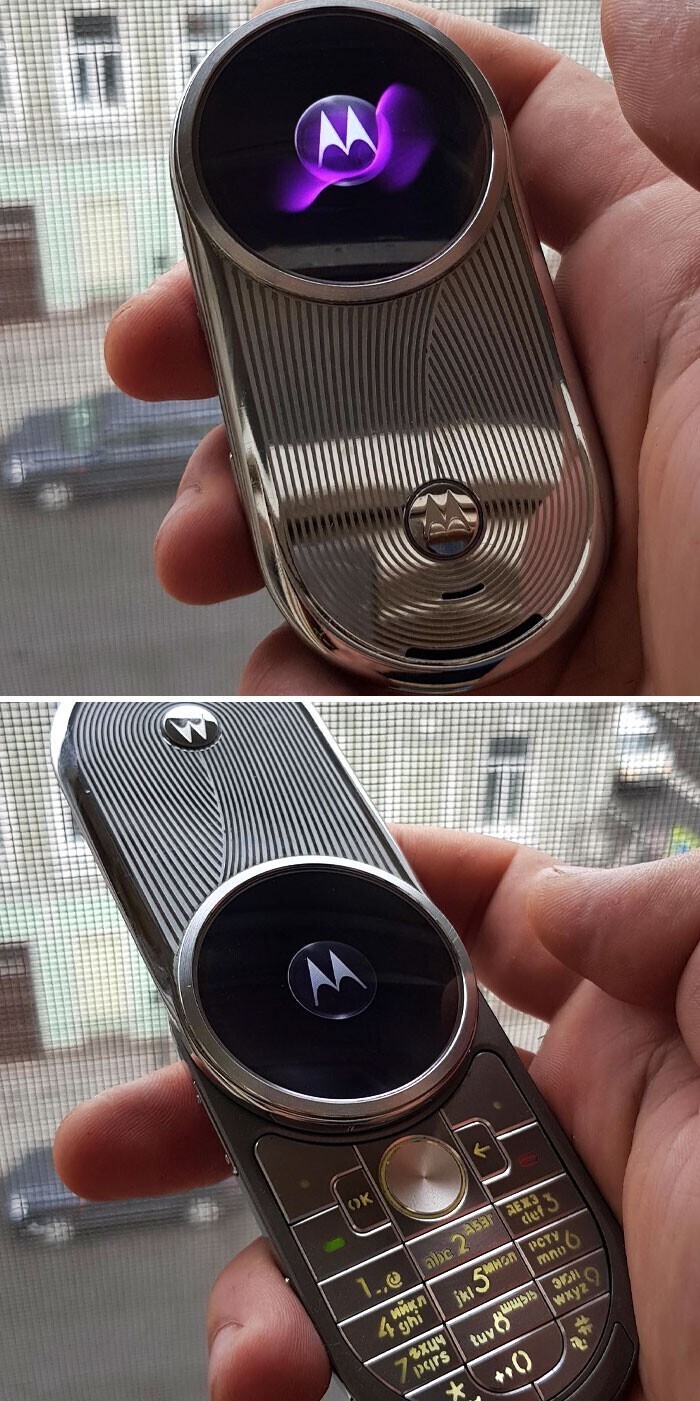
Источник:
9. Классный олдскул. Выбивается из общего списка, но очень уж красивый
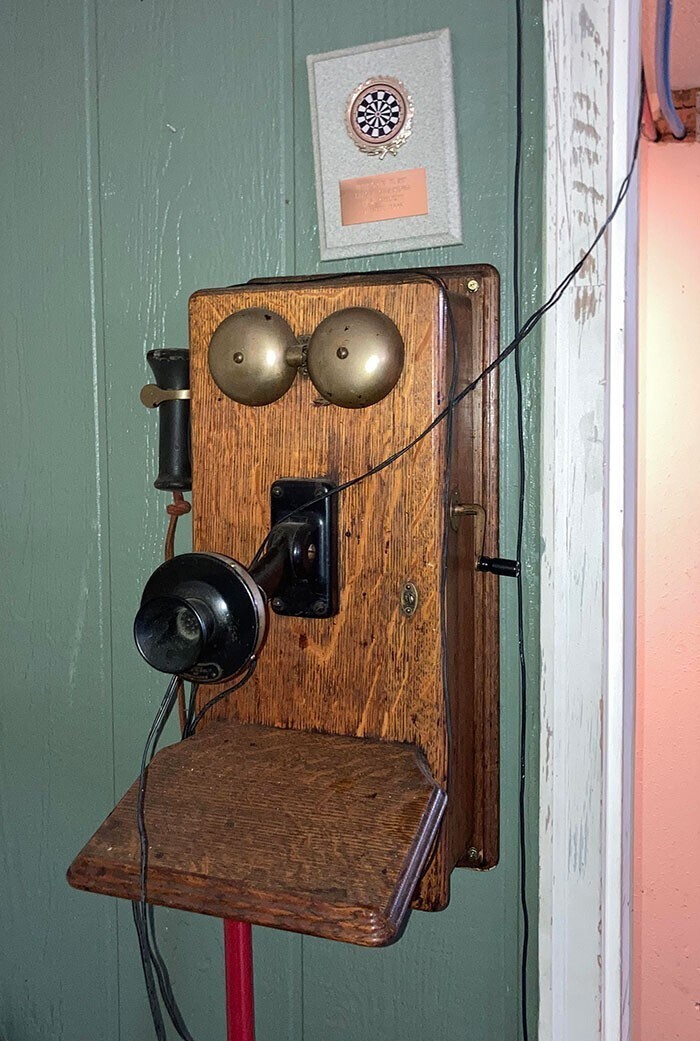
Источник:
10. Samsung Serenata
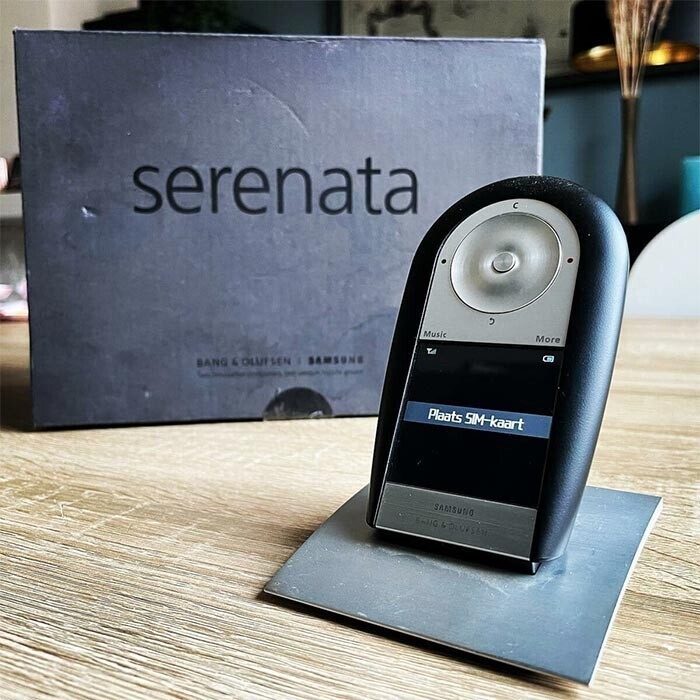
Источник:
11. Nokia N-Gage
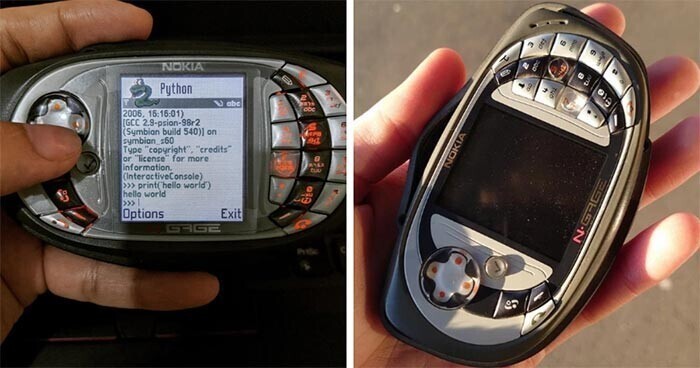
Источник:
12. Nokia 7380
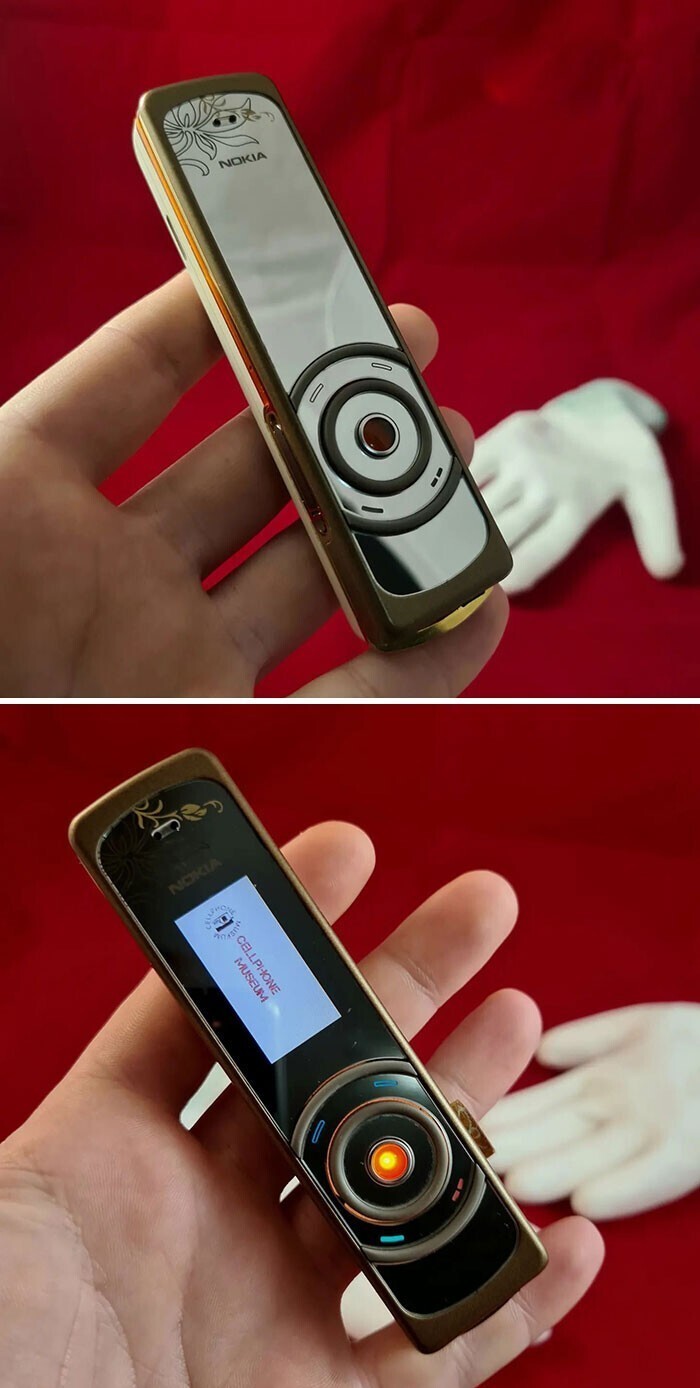
Источник:
13. Nokia 3650. Первый телефон с видеокамерой
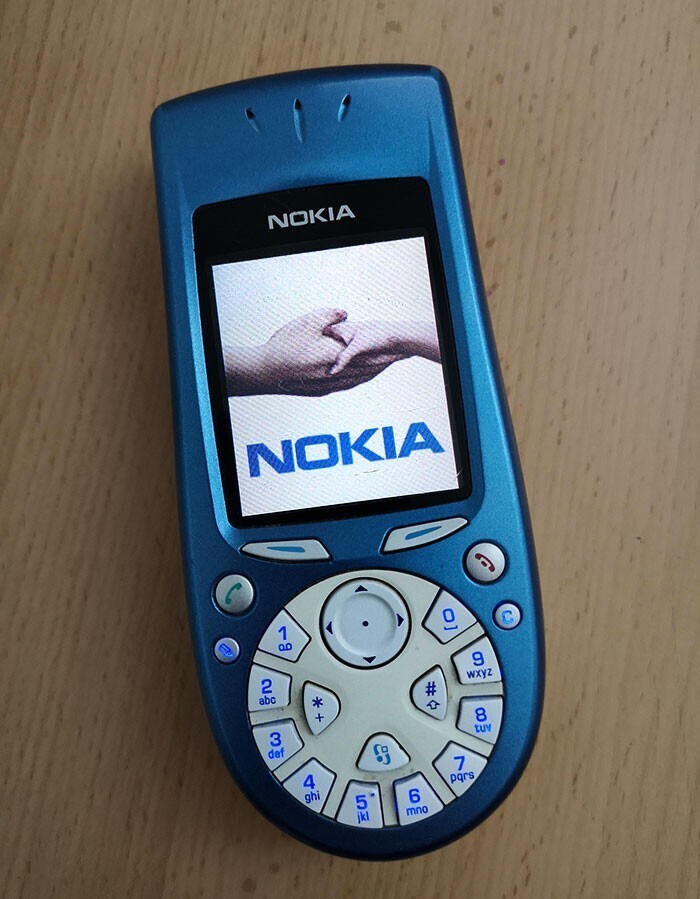
Источник:
14. Sony Ericsson XPERIA X5 Pureness
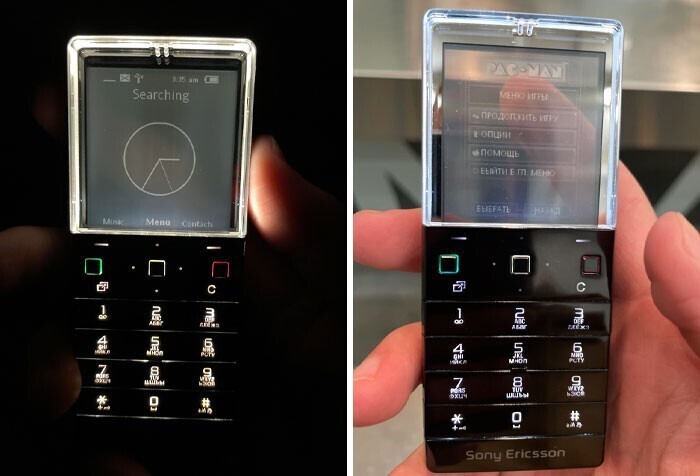
Источник:
15. «В этом старом «Ягуаре» до сих пор есть автомобильный телефон»
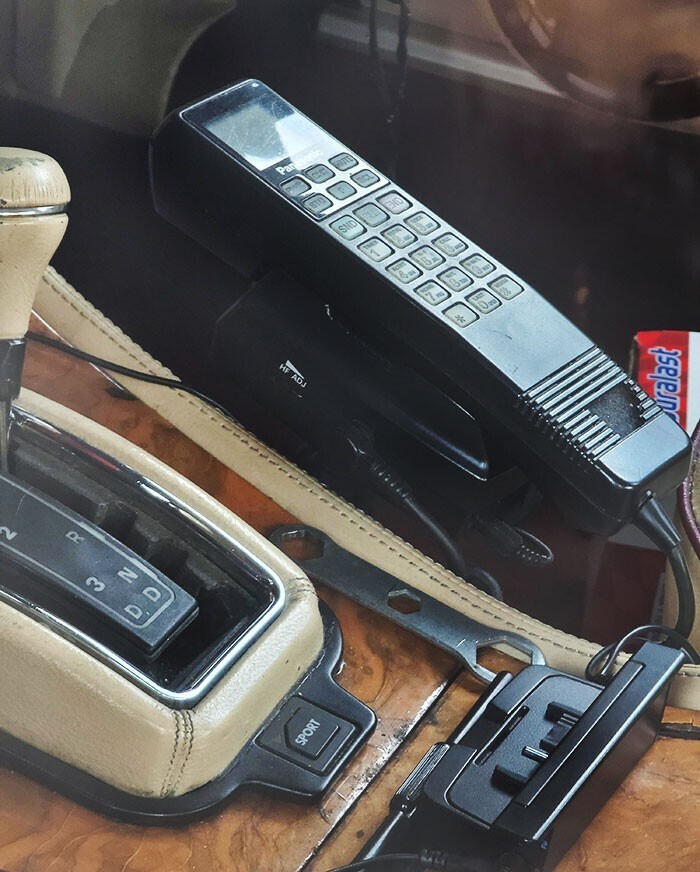
Источник:
16. Motorola V100
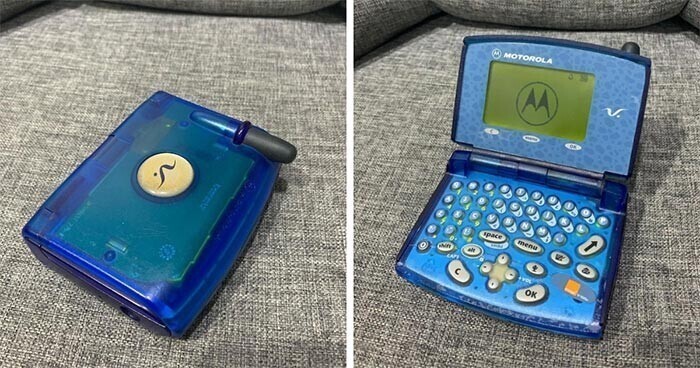
Источник:
17. Nokia 6810, модель 2003 года. 71 отдельная кнопка на телефоне такого размера!
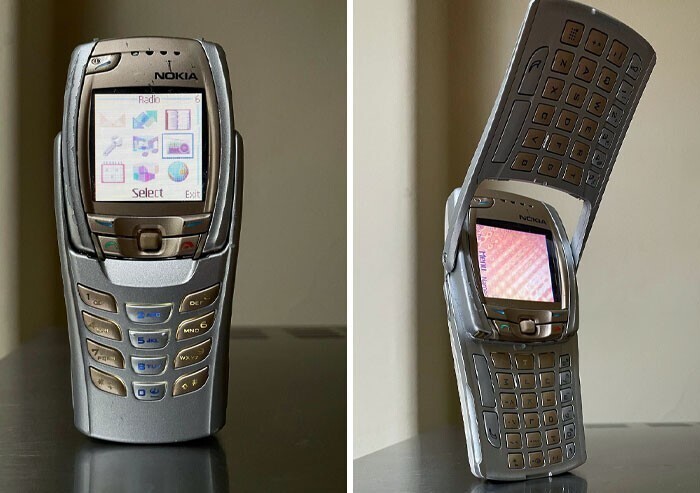
Источник:
18. «Моя красивая Motorola V50. В темно-сером цвете, который, на мой взгляд, выглядит лучше всего. Отличный телефон, очень маленький, компактный, с большим радиусом действия и работает в сетях 2G»
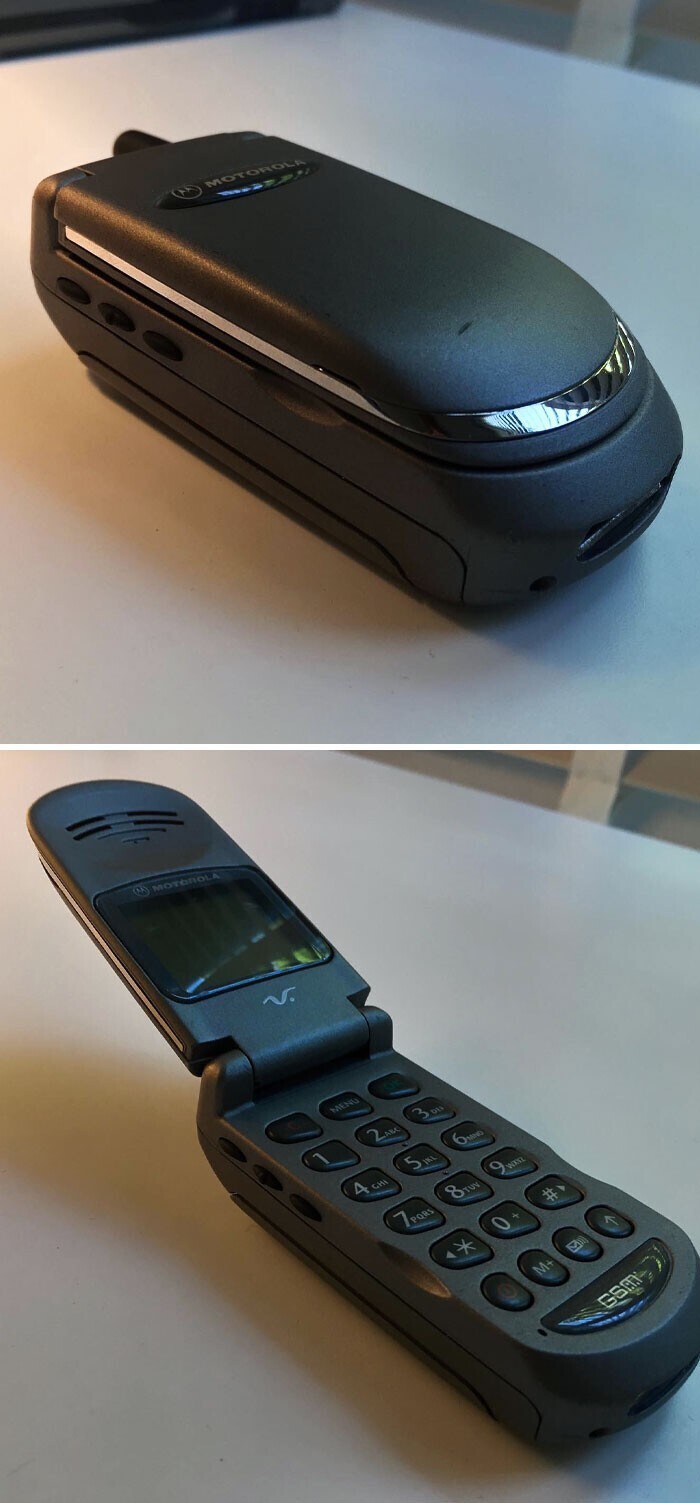
Источник:
19. Samsung Sph-N270
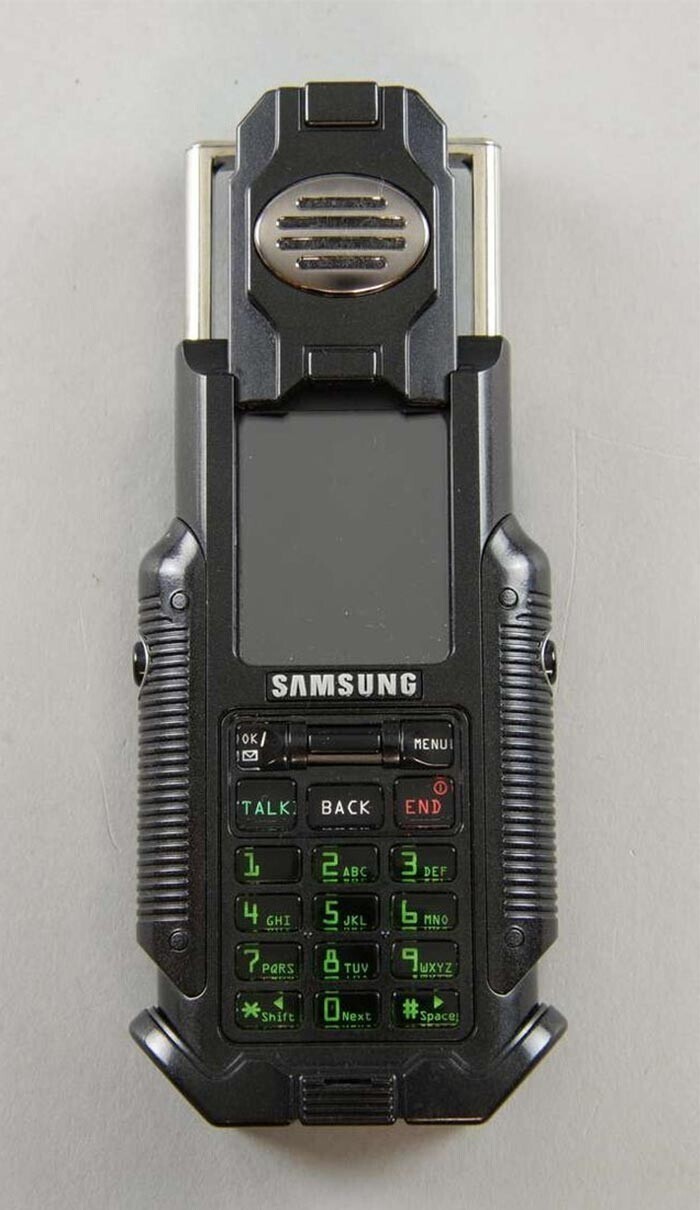
Источник:
20. «Все эти старые телефоны я нашел, разгребая кабинет дедушки»
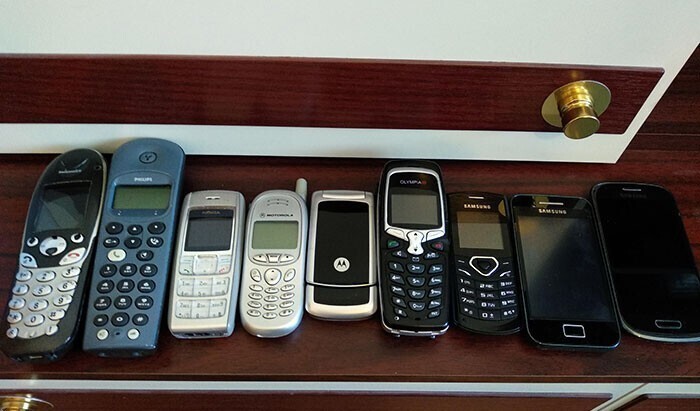
Источник:
21. Siemens Xelibri
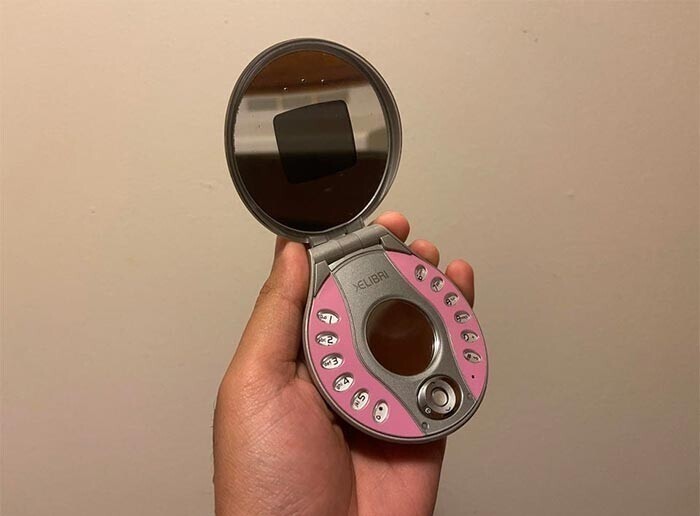
Источник:
22. Двухсторонний Samsung
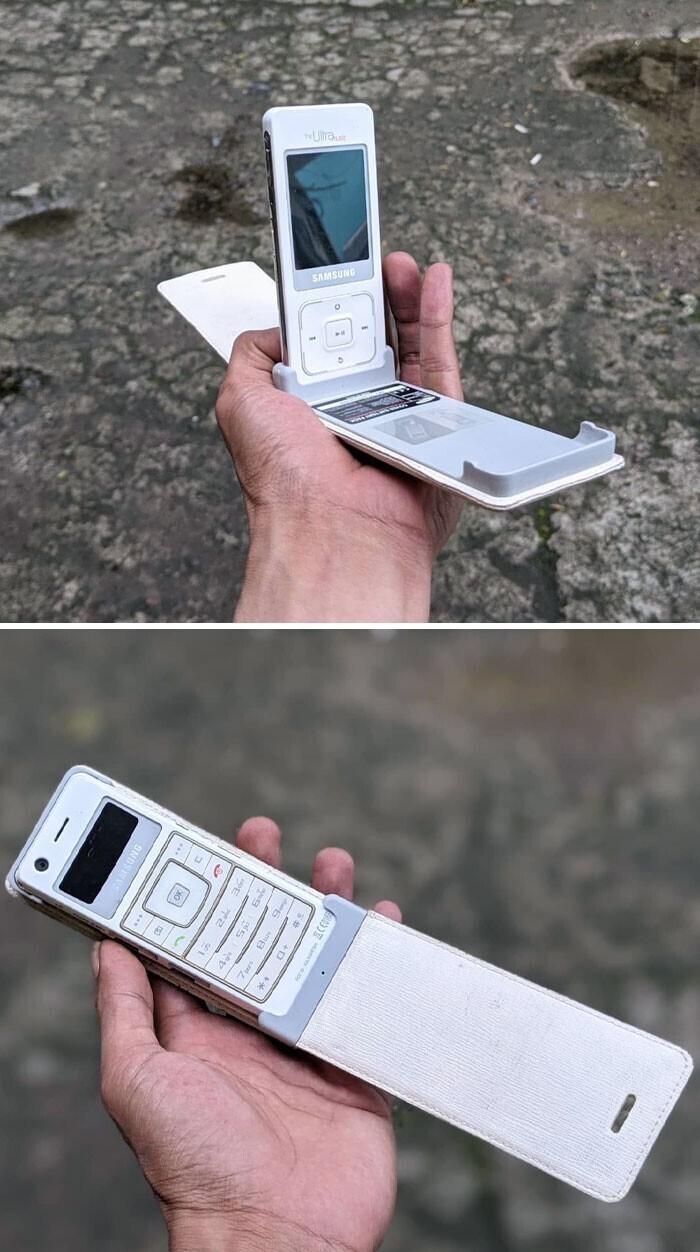
Источник:
23. Nokia N-Gage
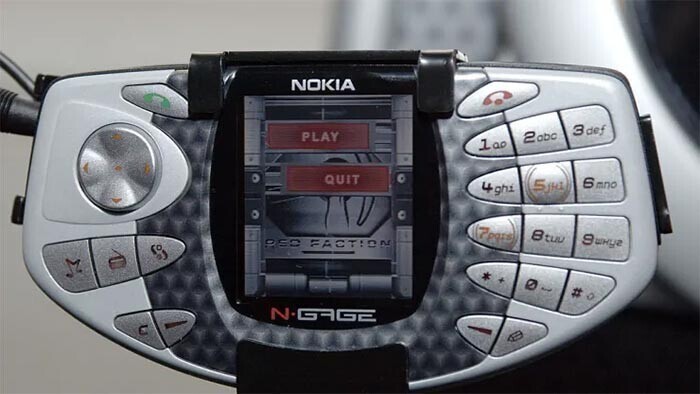
Источник:
24. Ericsson T60d Spider-Man, ограниченная версия
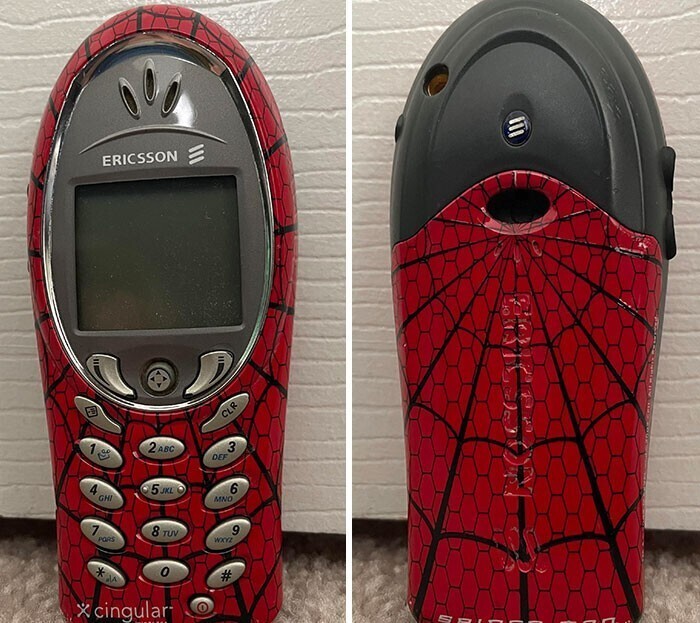
Источник:
25. Newgen C620
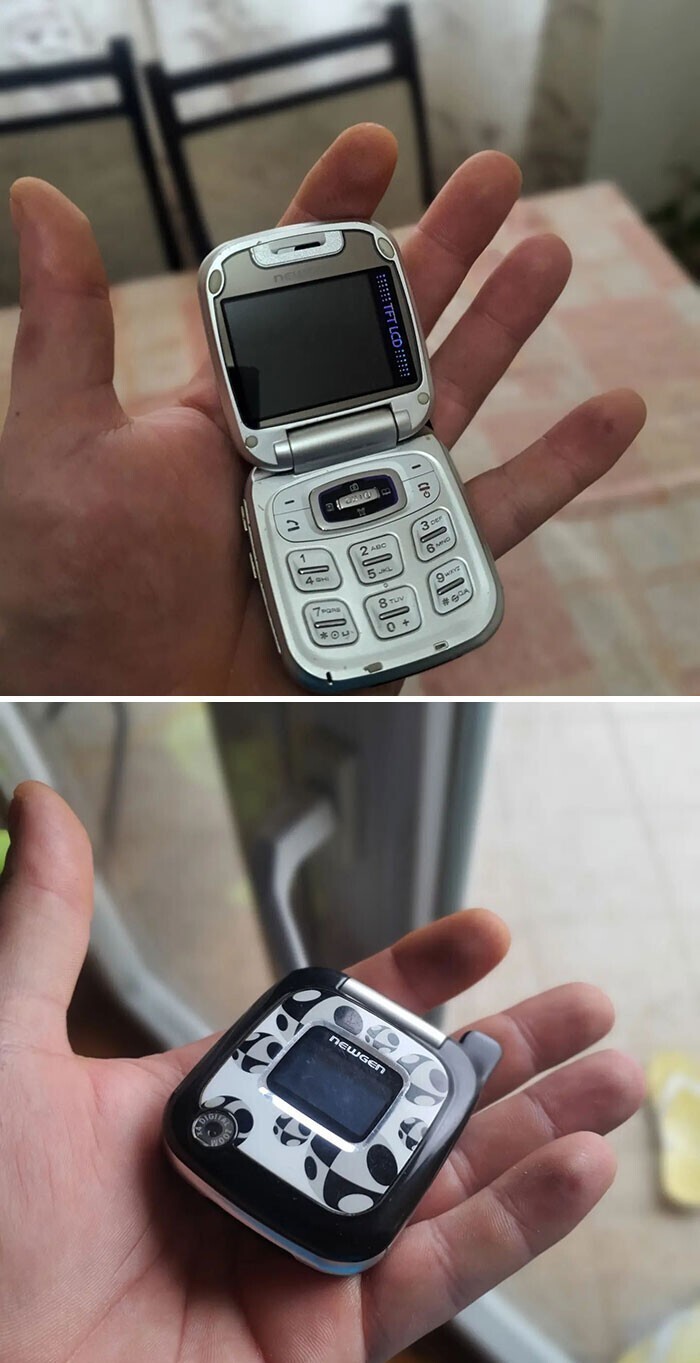
Источник:
26. Toshiba G450
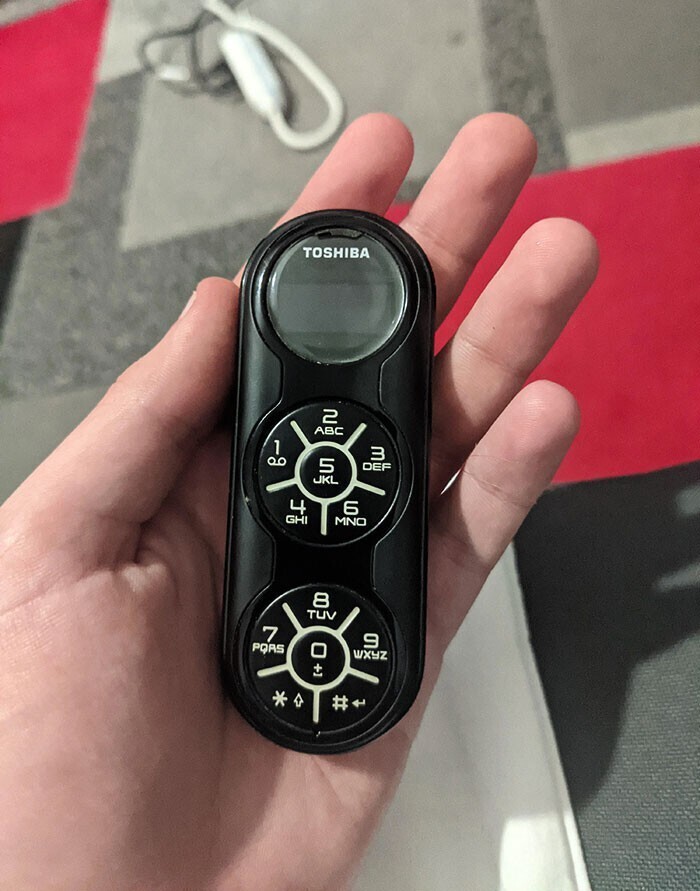
Источник:
27. Samsung Serene
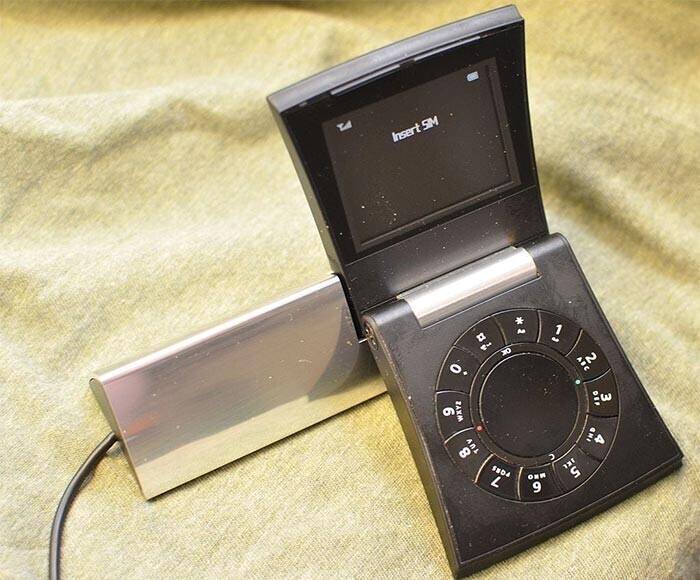
Источник:
28. Google Sooner, прототип первого телефона Android. Он работает на самой ранней версии Android
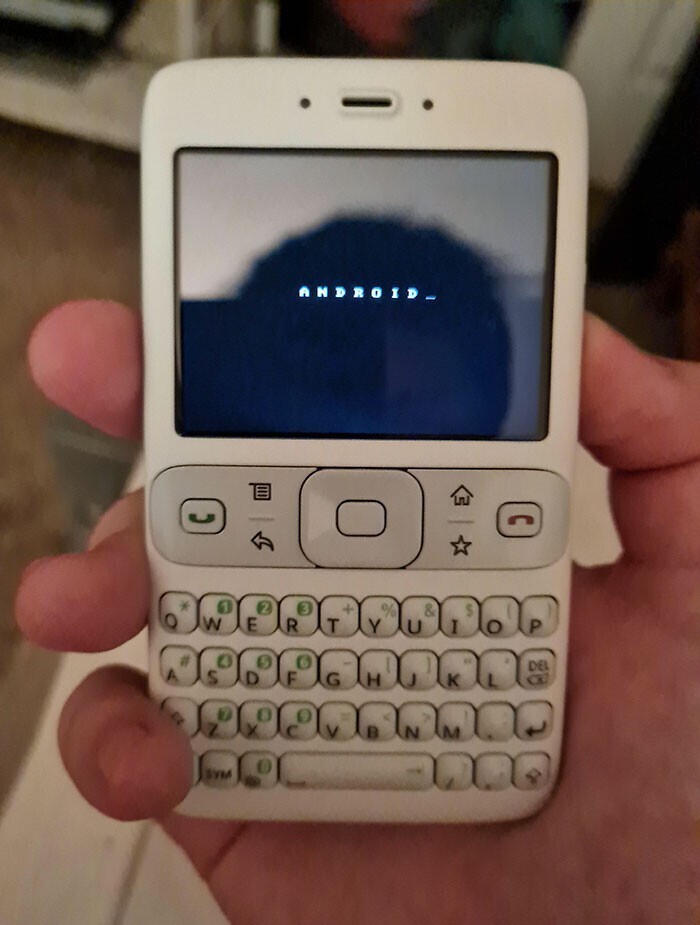
Источник:
29. Virgin Mobile Lobster 700tv
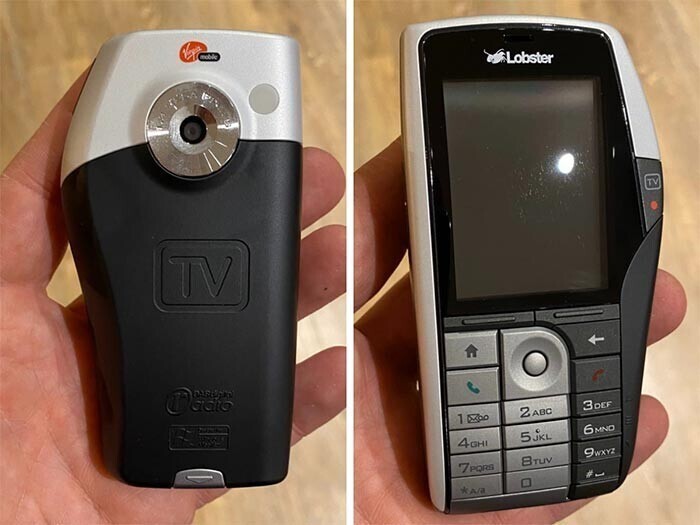
Источник:
30. Nokia 5510
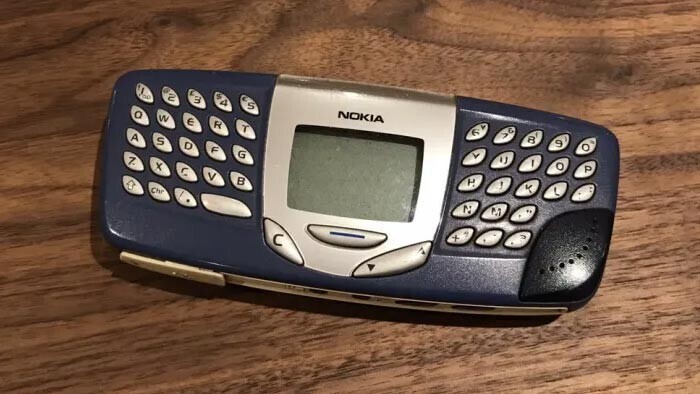
Источник:
Источник:
— переведено специально для fishki.net
Ссылки по теме:
Новости партнёров
реклама

За свои 150 лет истории (если вы принадлежите к поклонникам Меуччи, а не Грейама Белла, то назовёте другое число) телефон прожил огромное количество жизней. Его чрезвычайно долгая эволюция и история характеризуются множеством технологических революций. По сути, телефон стал носителем «вируса» глобализации, в основе современных коммуникаций лежит понятие «телефонного звонка», а идея возможности мгновенной связи с практически любым человеком в мире демонстрирует наше понимание параллельности индивидуального существования каждого. Всегда было и есть нечто невероятно новое и волшебное в возможности услышать далёкий голос, вести разговор между Лондоном и Нью-Йорком, иметь доступ к любой информации из другой части мира.
На протяжении всех этих лет сам телефон как объект претерпел множество трансформаций, это один из тех современных нам предметов, которые так нравится переосмыслять, анализировать и модифицировать художникам и дизайнерам, пытающимся интерпретировать дух времени, а иногда и предугадать его. Мы попробуем отследить его развитие от телетрофона Меуччи до iPhone, представив дизайн наиболее выдающихся телефонов и рассказав историю объекта, внёсшего такой существенный вклад в формирование нашей собственной истории.
1. Телетрофон, 1871 год
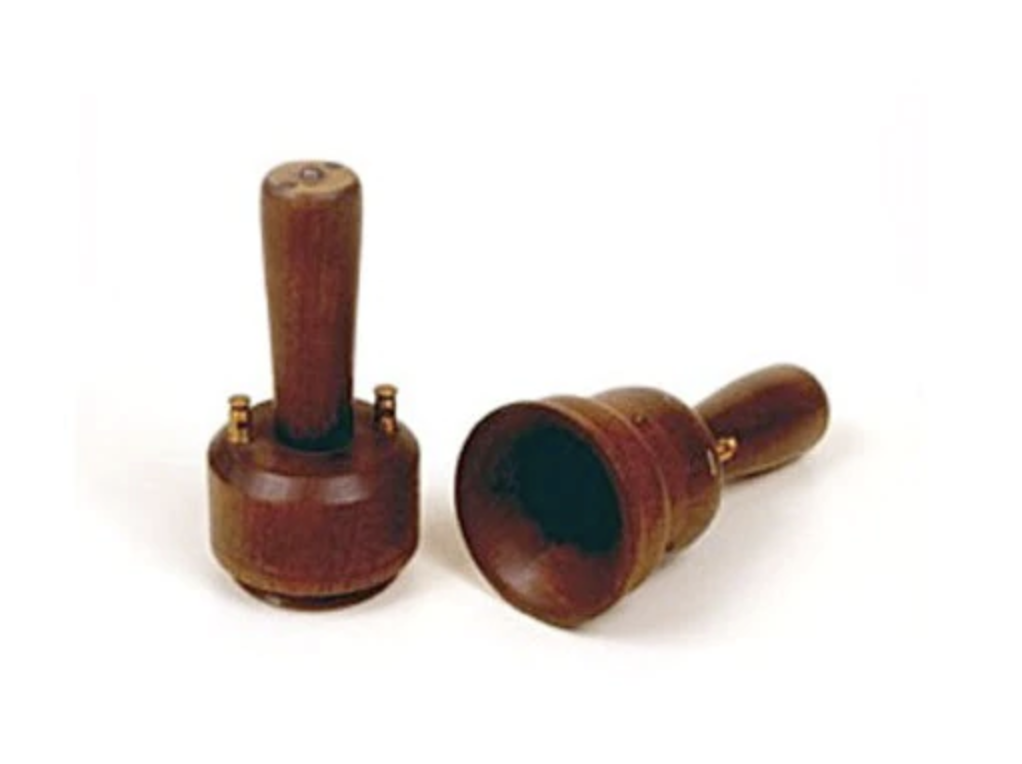
Кто был истинным изобретателем телефона? Если спросить американцев, то они обязательно ответят, что Александр Грейам Белл. Однако по мнению итальянцев, им был итальянский иммигрант Антонио Меуччи, основавший в 1871 году Telettrofono Company и создавший прототип того, что можно назвать первым аппаратом для голосовой связи — телефоном. Тем не менее, все мы знаем, что произошло: Меуччи не смог должным образом запатентовать своё устройство, потеряв возможность стать изобретателем телефона. Несколько лет спустя изобретение запатентовал Александр Грейам Белл, и дальнейшее развитие событий нам известно.
2. Телефон Грейама Белла, 1876 год

Летом 1876 года Александр Грейам Белл поразил посетителей международной выставки в Филадельфии «своим» изобретением, запатентованным в марте прошлого года: телеграфом для «передачи голоса», благодаря электромагнитной технологии позволявшим вести беседы на дальних расстояниях.
3. «Пузатый подсвечник» Строуджера, 1905 год

Последующие 20 лет стали свидетелями зарождения телефонии и роста её важности. Новое великое изобретение появилось в конце 19-го века, когда был придуман способ автоматического выбора телефонного номера вызываемого аппарата. Его изобретателем стал владелец погребальной конторы в Канзас-сити Элмон Строуджер. Таким образом ему удалось решить серьёзную проблему: работавшая телефонным оператором леди переадресовывала звонки его клиентов в компанию своего мужа, который был главным конкурентом Строуджера. Первый телефон с автоматическим коммутатором — Candlestick Potbelly — появился в 1905 году, но Строуджер также изобрёл и его «вертикальный» дизайн: телефоны с отделёнными от приёмника микрофоном были чрезвычайно популярными вплоть до 1930-х.
4. Ericsson 1001, 1931 год

Первый телефон с современным дизайном появился только в 1931 году, когда инженер Йохан Кристиан Бьёркнес вместе с художником и дизайнером Жаном Гейбергом создали Ericsson 1001. Их продукт стал результатом совместного проекта Elektrisk Bureau (Осло), Televerket (Швеция) и Ларса Магнуса Эрикссона. Ericsson 1001 стал первым бакелитовым телефоном со встроенным в корпус рычагом трубки, пальцевым номеронабирателем и звонком, уведомлявшим о входящих вызовах. Дизайн телефона считался для своего времени чрезвычайно инновационным, а позже распространился по Европе и вдохновил Генри Дрейфуса на создание знаменитой модели 500 Western Electric.
5. Ericofon, 1949 год
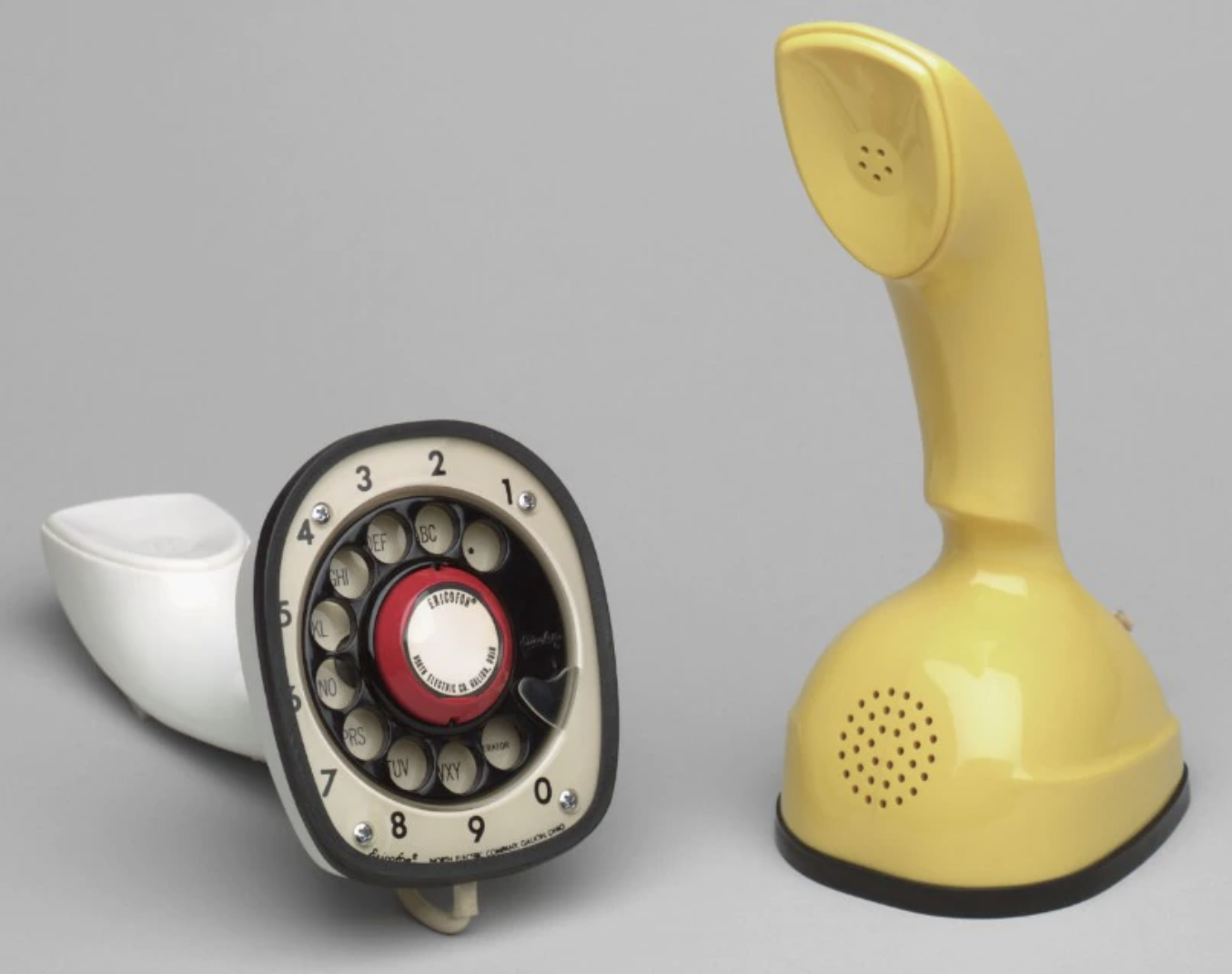
После Второй мировой войны шведские дизайнеры Ericsson снова занялись переосмыслением дизайна телефона. Ericofon стал первым телефоном, объединившим в один блок номеронабиратель и трубку. Сегодня он является частью коллекции Музея современного искусства Нью-Йорка и известен под прозвищем «телефон-кобра», потому что напоминает свернувшуюся кольцами змею, голова которой поднята и готова… ответить на звонок.
6. Princess, 1959 год

В годы экономического процветания дизайн телефонов продолжал эволюционировать, но только 1950-х дизайнеры начали по-настоящему экспериментировать с формами и цветами, предвосхищая поп-арт и модернистский стиль 1960-х. Символом дизайна в тот период стал телефон Princess, разработанный Генри Дрейфусом. Этот компактный телефон был спроектирован так, чтобы идеально подходить к «женскому прикроватному столику» как улучшенная и более изящная альтернатива громоздкой и тяжёлой Model 500.
7. Bigrigio, 1962 год
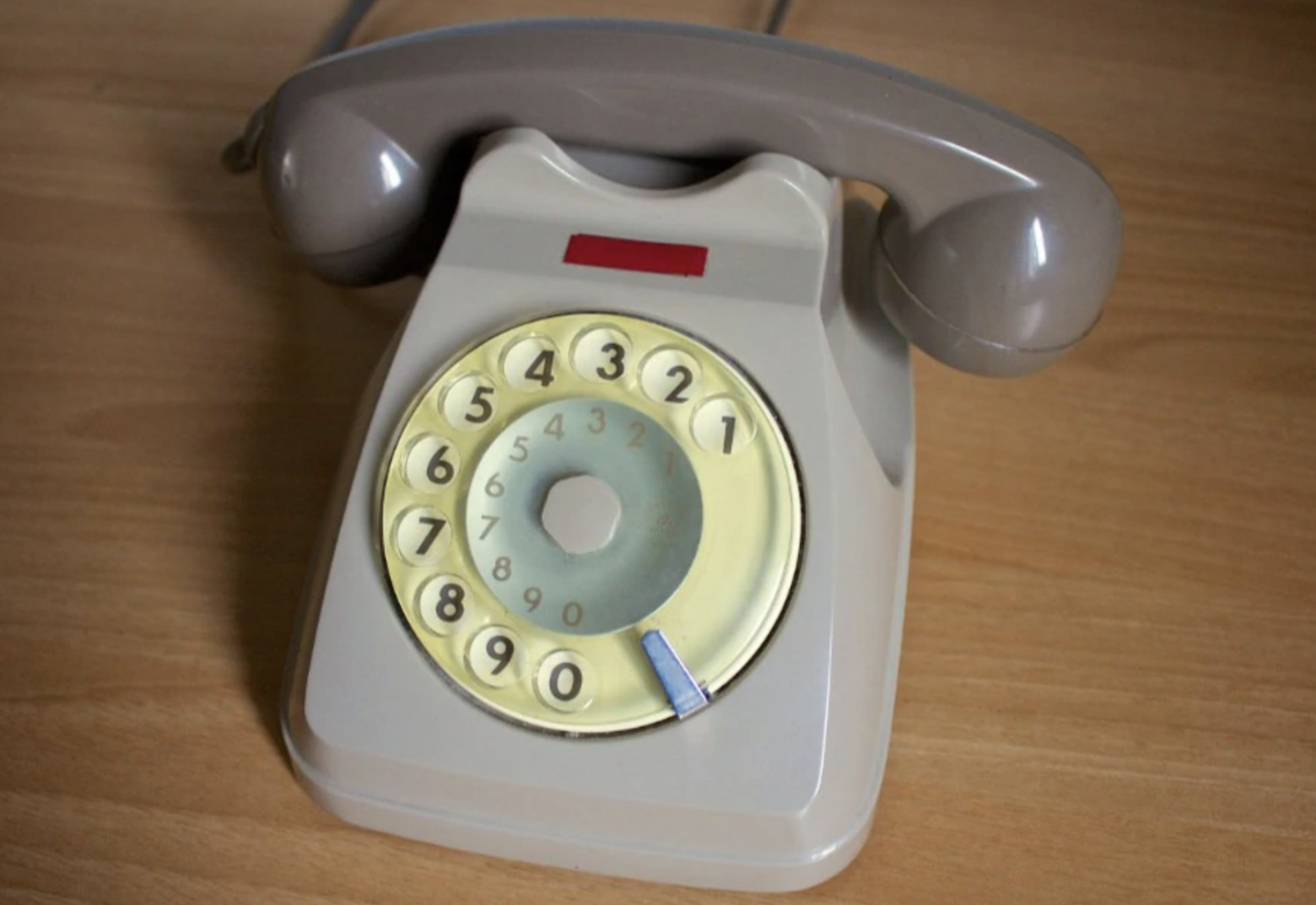
Итальянским аналогом американской Model 500 компании Western Electric и скандинавского Ericsson 1001 стал Siemens S62 — телефон с поворотным номеронабирателем, сильно полюбившийся трём поколениям итальянцев. Проект телефона для компании Siemens был создан Лино Салтини. Однако в последующие годы различные модели Bigrigio начали также производить FATME, Italtel и Face Standard. Телефон в шутку называли «bigrigio» («два серых цвета») из-за отличающихся оттенков серого пластмассовой трубки и аппарата.
8. Grillo, 1966 год

В то же десятилетие, когда Sit Siemens выпустила на рынок знаменитый Bigrigio, компания попросила Марко Занусо и Ричарда Сэппера создать телефон с революционным дизайном: Grillo («сверчок»). Это было инновационное устройство, отринувшее наиболее типичные характеристики телефона: из-за своей раскладной конструкции он не напоминал телефон ничем, кроме провода. В 1967 году Grillo заслуженно получил дизайнерскую премию «Золотой циркуль» (Compasso d’Oro).
9. Motorola DynaTac 8000X, 1983-1989 годы
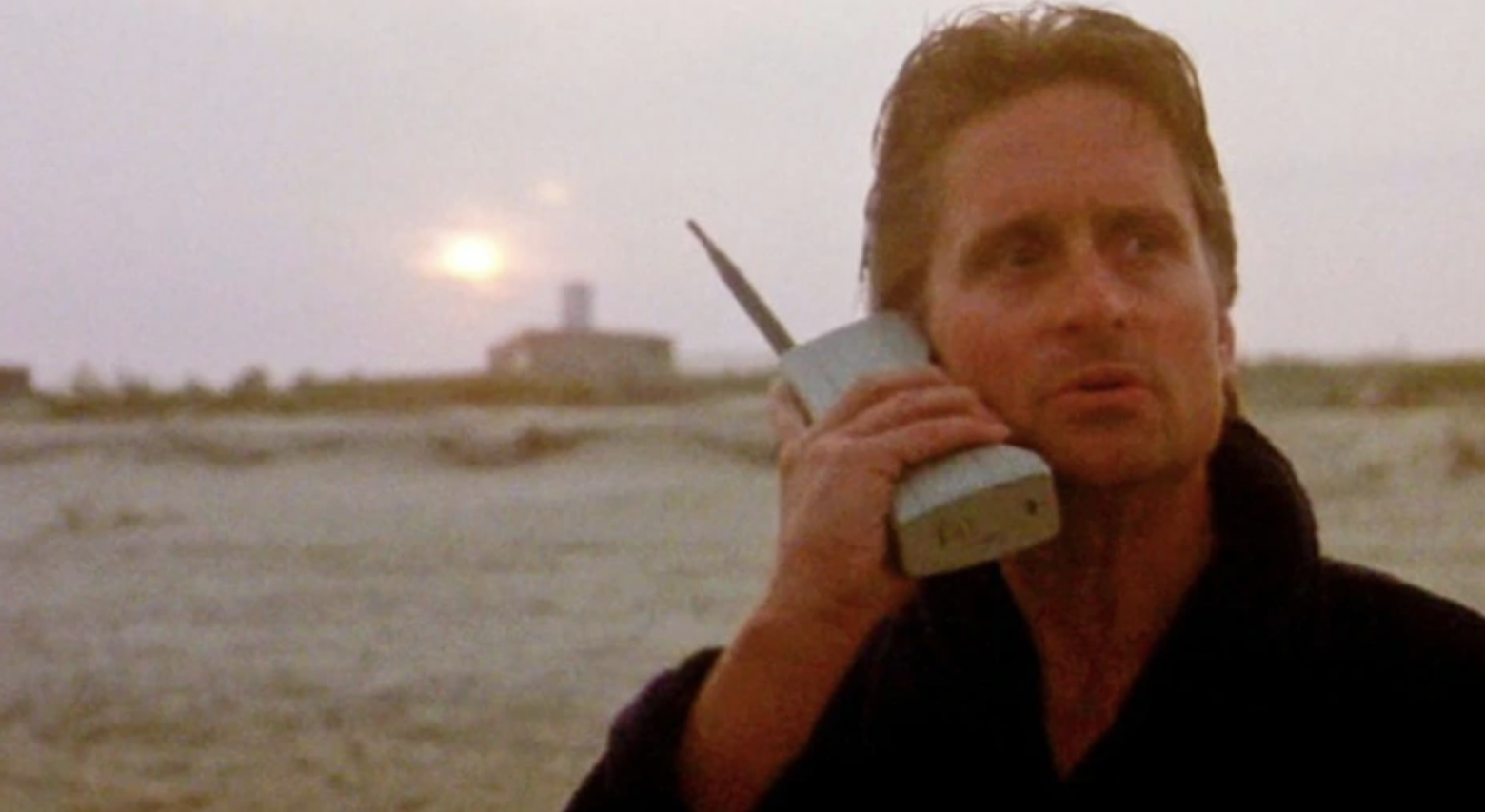
Хотя некоторые из перечисленных выше стационарных телефонов и так служили показателями социального положения (не каждый мог поставить на свой стол Grillo), по-настоящему телефон превратился в символ статуса только с появлением мобильных устройств. Идея о том, что вне зависимости от времени и места можно в любой момент совершать и принимать телефонные вызовы, абсолютно соответствовала стилю яппи 80-х, наряду с кокаином и спекуляциями на фондовой бирже. Огромный мобильный телефон DynaTac, которым пользовался Гордон Гекко в фильме 1987 года «Уолл-стрит», стал идеальным символом того времени. Несмотря на свою заоблачную цену (на момент начала продаж в 1983 году он стоил 4000 долларов), он имел полный успех. За несколько последующих лет более 300 тысяч американцев решили купить сотовый телефон, и единственным возможным выбором был «кирпич» Motorola.
10. Pulsar, 1985 год
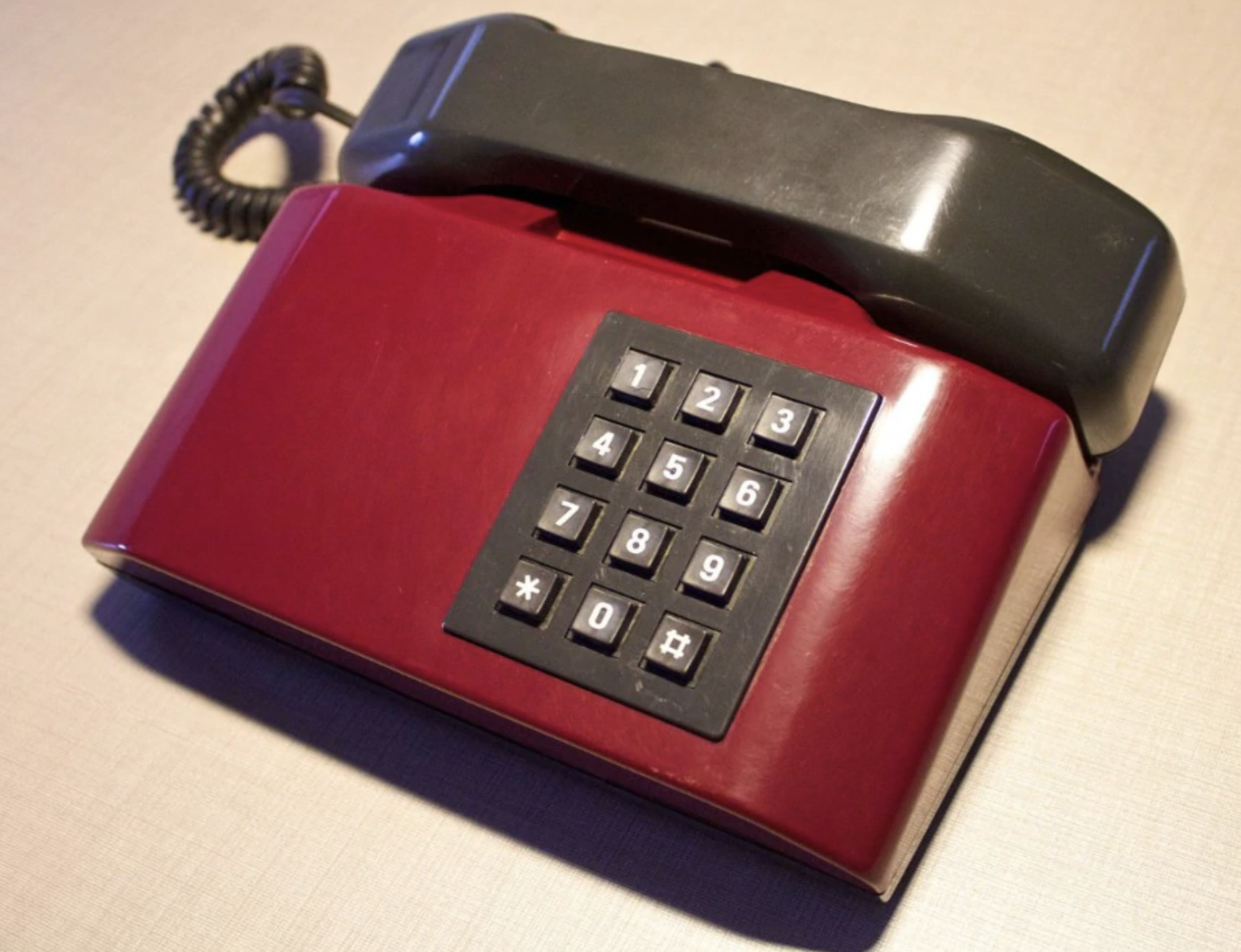
Итальянская молодёжь 80-х училась совершать первые телефонные звонки на двух разных телефонах: Bigrigio, стоявшем в доме у бабушки, и на более современно выглядящем Pulsar их родителей. Дизайн этого телефона напоминал всем автомобили 80-х годов, особенно ярко-бордовая версия, которую невозможно было вписать ни в один интерьер. Однако причиной, по которой он считался лучше Bigrigio, была цифровая клавиатура, гораздо более удобная и быстрая, чем дисковый номеронабиратель S62.
11. Autotelefono SIP, 1989 год

Бо́льшим, чем носимые телефоны и DynaTac, истинным итальянским показателем статуса конца 80-х был автомобильный телефон. «Мобильный радиопередатчик для общения», позже названный «autotelefono» идеально соответствовал полюбившейся всей Италии эстетике времени «до операции „Чистые руки“»: образу менеджера, ездящего на Lancia Thelma и одетого в Armani. Модели конца 80-х и начала 90-х были главными героями нескольких реклам, которые сегодня можно найти на YouTube. Наиболее продвинутые автомобильные телефоны работали благодаря Radio Telephone Mobile System, основанной на микроволновом радио и сотах, позволявших продолжать телефонный разговор даже во время переноса вызова с одного канала на другой.
12. Sirio, 1987 год (начал выпускаться с 1990 года)
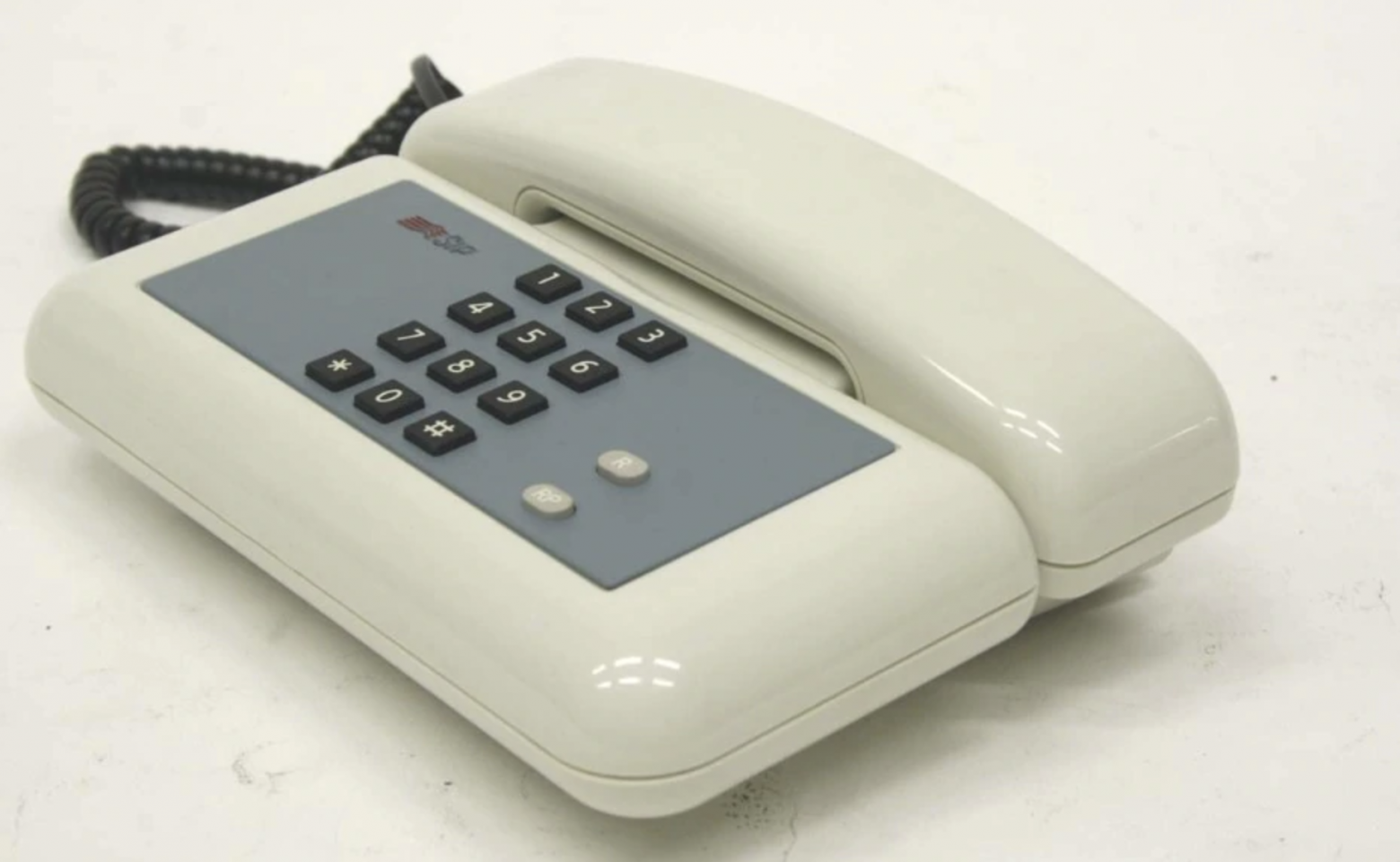
Всего спустя пару лет после Pulsar был изобретён ещё один вдохновлённый космосом телефон Sirio. Вероятно, это одна из наиболее известных конструкций среди телефонов, продававшихся SIP («Итальянским обществом телефонных операций»). Этот телефон и сегодня достаточно часто встречается (хоть и в более современных версиях) во многих итальянских домах. Линии Sirio стали более плавными, они предсказали стиль, который будет нравиться людям в 90-х, и предугадали серьёзные изменения в итальянских телефонных технологиях, произошедшие в течение этого десятка лет: тональная сигнальная система DTMF, direct distance dialing и, что самое важное, первые эксперименты с опросами общественного мнения, использованные в шоу-бизнесе — телеголосование.
13. Motorola StarTAC, 1996 год
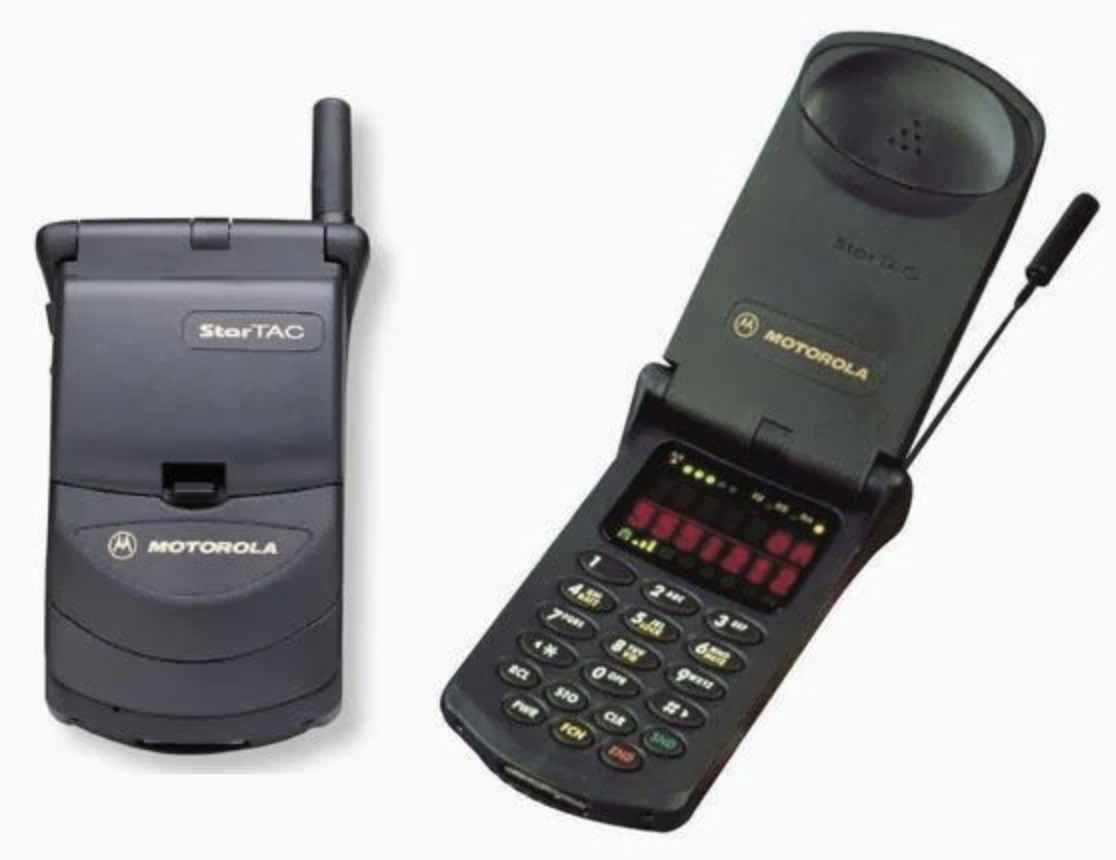
В 90-х постоянно усиливалась миниатюризация мобильных телефонов. Флагманом этой тенденции стал ещё один телефон Motorola, тоже вскоре превратившийся в дорогой символ статуса — StarTAC. Выпущенный в январе 1996 года, он стал первым мобильным телефоном-«раскладушкой». Он олицетворял собой доселе невиданную революцию в дизайне и проектировании мобильных телефонов. StarTAC стал потомком MicroTAC — частично раскладывавшегося мобильного телефона, выпущенного в 1989 году. Устройство стало одним из наиболее успешных телефонов того периода и продалось тиражом 60 миллионов моделей.
14. Nokia 8110, 1996 год

Пока Motorola находилась на волне успеха, создавая множество новых сотовых телефонов, невероятно успешной готовилась стать финская компания Nokia. В 1996 году Nokia выпустила 8110, за свою причудливую форму прозванный «бананофоном». Аналогично ситуации с «Уолл-стрит» и DynaTAC, превращению этой модели в икону стиля поспособствовал кинематограф: в знаменитой сцене из фильма «Матрица» Морфеус звонит Нео на его 8110. Несколько секунд спустя камера демонстрирует, как тот же мобильный телефон падает с небоскрёба — с этой сценой не сравнится никакой «продакт-плейсмент» на Netflix. В 2018 году Nokia представила более современную версию модели с цветным экраном и поддержкой 4G.
15. B&O BeoCom 6000, 1999 год
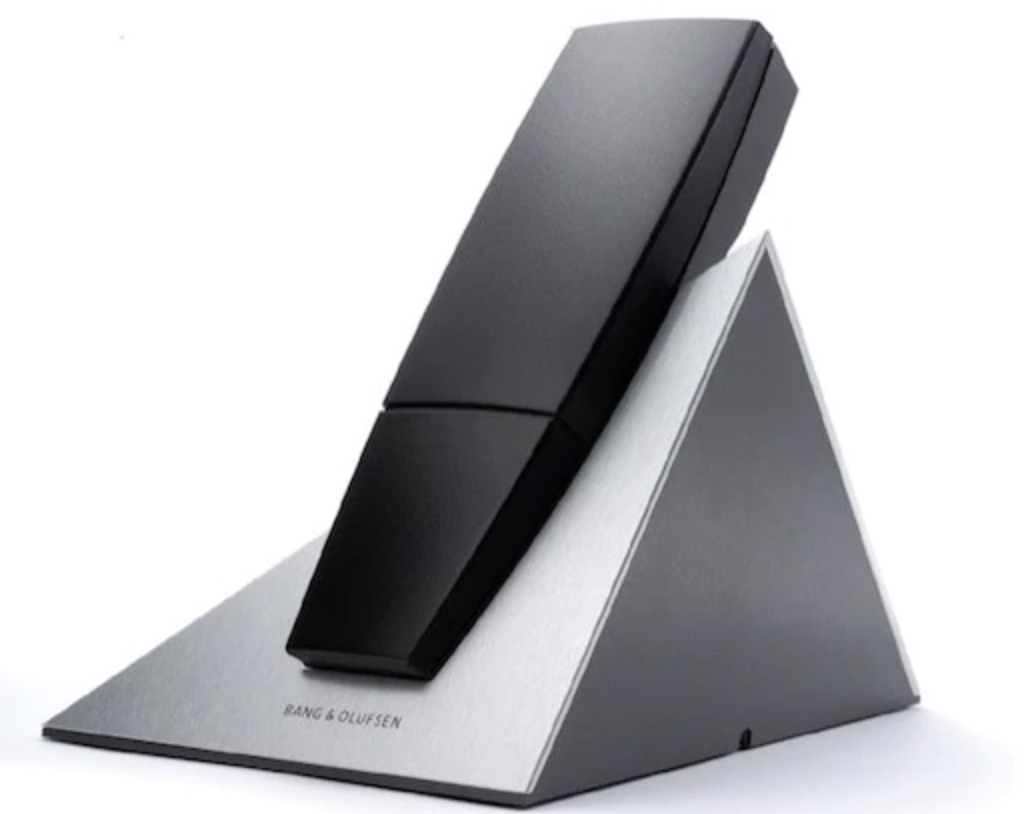
В конце 90-х мобильные телефоны совершили революцию в общении, но домашние стационарные аппараты по-прежнему отстаивали свои позиции, а их пользователи щеголяли самыми изощрёнными примерами дизайна. Однако предметом всеобщего вожделения был беспроводной телефон — по-сути, мобильник, который стоит в доме. Одним из наиболее интересных беспроводных устройств того времени является Bang & Olufsen BeoCom 6000. В нём первом полноценно был реализован DECT — стандарт, который обычно используется (даже сегодня) для создания беспроводных телефонных систем. Полюбившийся многим дизайн выглядел немного устаревшим: линии и стиль были типичными для конца 90-х. Он запросто мог бы сочетаться с Twentieth Anniversary Macintosh — одним из немногих спроектированных Джонатаном Айвом устройств, которые не оставили значительного следа в истории дизайна.
16. Nokia 3310, 2000 год
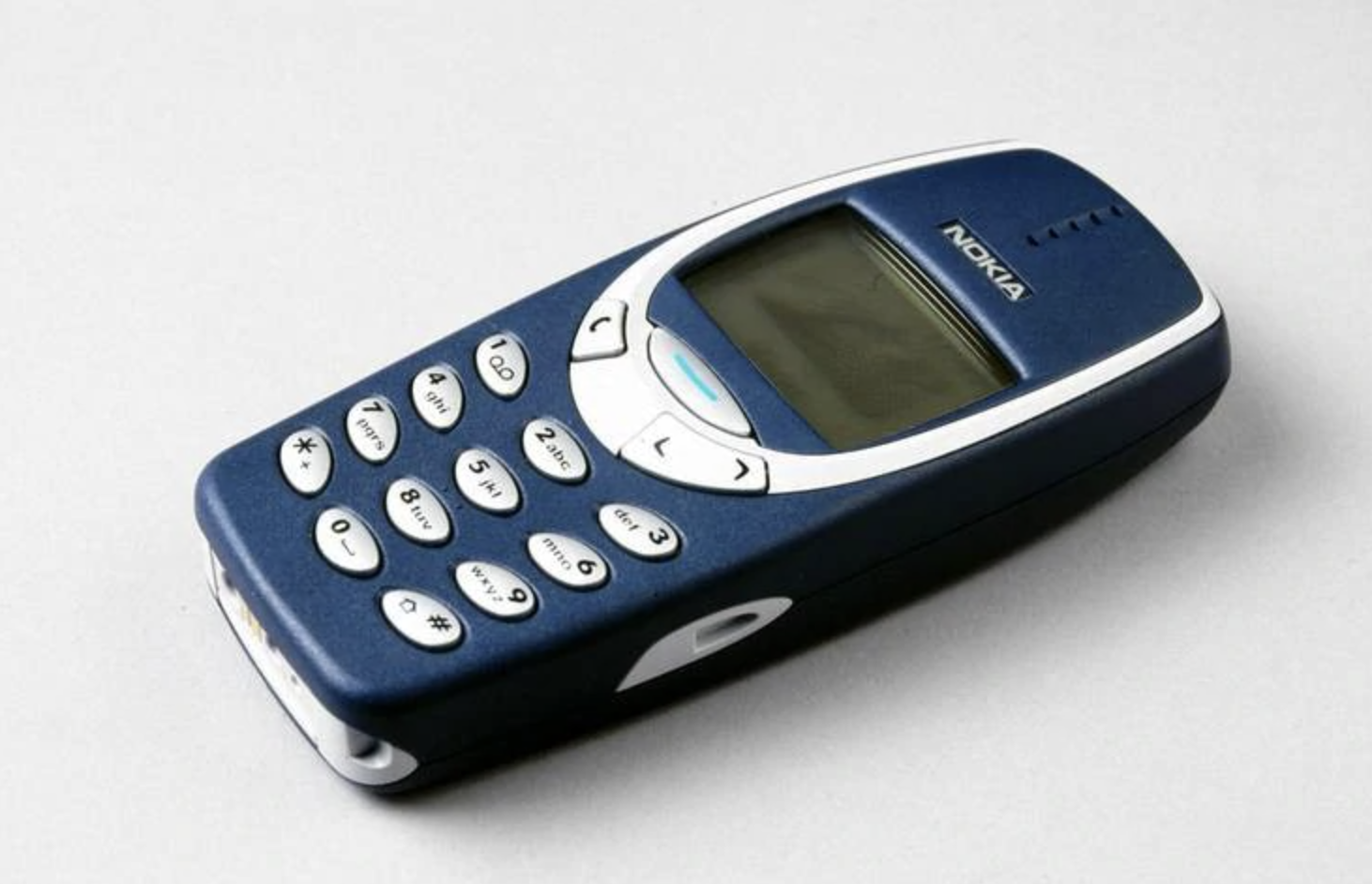
С приближением нового тысячелетия и крахом доткомов производство мобильных телефонов испытывало экспоненциальный рост. Важнейшим годом стал двухтысячный, когда был выпущен Nokia 3310. Разумеется, существует множество знаковых сотовых телефонов, но именно 3310 стал символом демократизации мобильного телефона. Несмотря на свою относительно небольшую стоимость, Nokia 3310 обладал высоким техническим качеством и приобрёл репутацию неубиваемого. Обычно при падении на землю он «разваливался» на три части: сам телефон, заднюю крышку и аккумулятор. Достаточно было собрать части вместе, и телефон снова начинал работать, как будто ничего не случилось.
17. RIM 957, первый Blackberry, 2000 год

В 2000 году на рынок был выпущен и первый Blackberry. Телефон Blackberry, имевший в то такое же название, что и канадская компания, которая его изобрела и выпустила (RIM), обрёл всемирный успех и проложил дорогу КПК (personal digital assistants, PDA). Это был первый мобильный телефон, предназначенный для использования в качестве компьютера — одними из главных его задач были отправка и получение электронной почты. Blackberry также стал первым мобильным телефоном, вызвавшим споры о проблеме зависимости от современных коммуникационных устройств: в Америке ему дали прозвище CrackBerry. Это прозвище связано с популярным уличным наркотиком крэком, потому что возможность заниматься рабочими задачами в любом месте позволяла типичному американскому трудоголику раз и навсегда избавиться от здорового баланса работы и жизни. К сожалению, мобильные телефоны Blackberry вскоре были замещены смартфонами и iPhone. Это было вызвано стратегической ошибкой компании RIM, сделавшей ставку на использование физических клавиатур.
18. Nokia 9210 Communicator, 2000 год

В 2000 году Nokia выпустила свой первый PDA с дизайном столь же абсурдным, сколь и образцовым. Он идеально соответствовал новаторским изобретениям финской компании того периода. В закрытом состоянии 9210 Communicator выглядел как обычный телефон. Но при повороте на 90 градусов он открывался как миниатюрный ноутбук с клавиатурой и дисплеем, позволяющими с комфортом проверять и отправлять электронную почту. Для этого телефона важную роль тоже сыграл кинематографический продакт-плейсмент: 9210 стал специальным сотовым телефоном Джеймса Бонда в «Завтра не умрёт никогда» [прим. пер.: на самом деле это был модель телефона Ericsson, выпущенная специально для фильма и не имевшая собственного названия].
19. Motorola Razr, 2004 год

Последним настоящим «сотовым телефоном» с имиджевым дизайном до революции смартфонов стал Motorola Razr, выпущенный этой американской компанией в 2004 году. Тонкий и стильный, начиная с «остроты» названия модели (razor — «бритва»), Razr позиционировался как модный телефон, предназначенный для богатой элиты (он был чрезвычайно дорогим — 500 долларов). Однако на последующие модели Motorola понизила цены. К июлю 2016 года компании удалось продать более 50 миллионов сотовых телефонов. В 2019 году Motorola Razr вернулся в виде складной версии смартфона, это стало ностальгическим и в то же время инновационным ходом.
20. iPhone, 2007 год
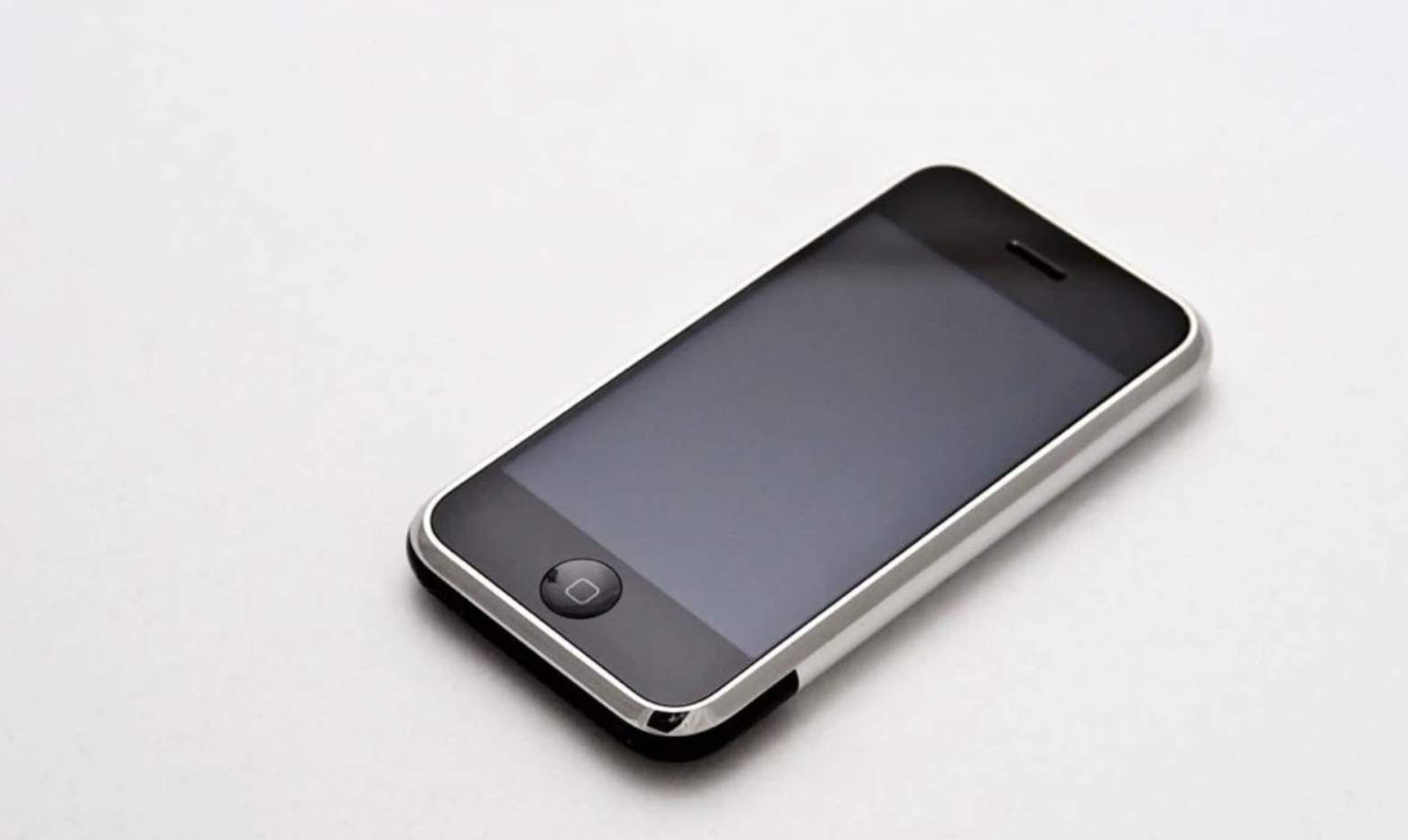
Презентация iPhone в январе 2007 года и его выпуск в июне того же года сделали первую половину 2007 года одним из наиболее важных моментов истории мобильных телефонов. Можно написать сотни страниц об iPhone, его дизайне и технологической, культурной и социальной революции, которую он принёс. Невозможно подвести итог десятку лет технологических инноваций в рамках короткой статьи. Поэтому мы только процитируем то, что сказал в 2007 году Стив Джобс на презентации iPhone: «Сегодня мы объявляем о трёх революционных продуктах. Первый — это широкоэкранный iPod с сенсорным управлением. Второй — это революционный мобильный телефон. А третий — это качественно новое устройство для Интернет-коммуникаций. Итак, три устройства — широкоэкранный iPod с сенсорным управлением, революционный мобильный телефон и качественно новое устройство для Интернет-коммуникаций. iPod, телефон и Интернет-коммуникатор. iPod, телефон… Вы уже понимаете, к чему я клоню? Это не три отдельных устройства, а одно, и мы назвали его iPhone. Сегодня Apple заново изобретёт телефон. А вот и он».
21. HTC Dream, 2008 год

Что касается Android, то можно было бы перечислить тысячу продуктов, но мы решили поговорить только о HTC Dream — первом смартфоне, в котором использовалась эта операционная система Google. После выпуска первого iPhone разработчики Android быстро изменили подход и начали использовать сенсорные экраны. Даже несмотря на то, что первая модель по-прежнему выглядит как мобильный телефон досмартфонной эпохи с физической клавиатурой, она стала исторически важным смартфоном с культовым дизайном, предвосхитившим некоторые элементы (например, клавиши навигации), которые в дальнейшем характеризовали «язык» общения с пользователем Android. HTC Dream очень важен, особенно своей демонстрацией того, что, в отличие от многих компаний наподобие RIM и Microsoft, Google мгновенно поняла огромную важность и своевременность iPhone. Именно благодаря этому истинными главными героями рынка мобильных телефонов остаются iOS и Android.
Только зарегистрированные пользователи могут участвовать в опросе. Войдите, пожалуйста.
У вас было что-нибудь из списка?
6.92%
Nokia 8110, хотел бы сейчас такую
24
23.92%
Motorola Razr, отличная была штука
83
40.63%
Nokia 3310, до сих пор работает
141
10.95%
Не было, но теперь хочется
38
31.12%
Не было и не хочется
108
Проголосовали 347 пользователей.
Воздержались 66 пользователей.
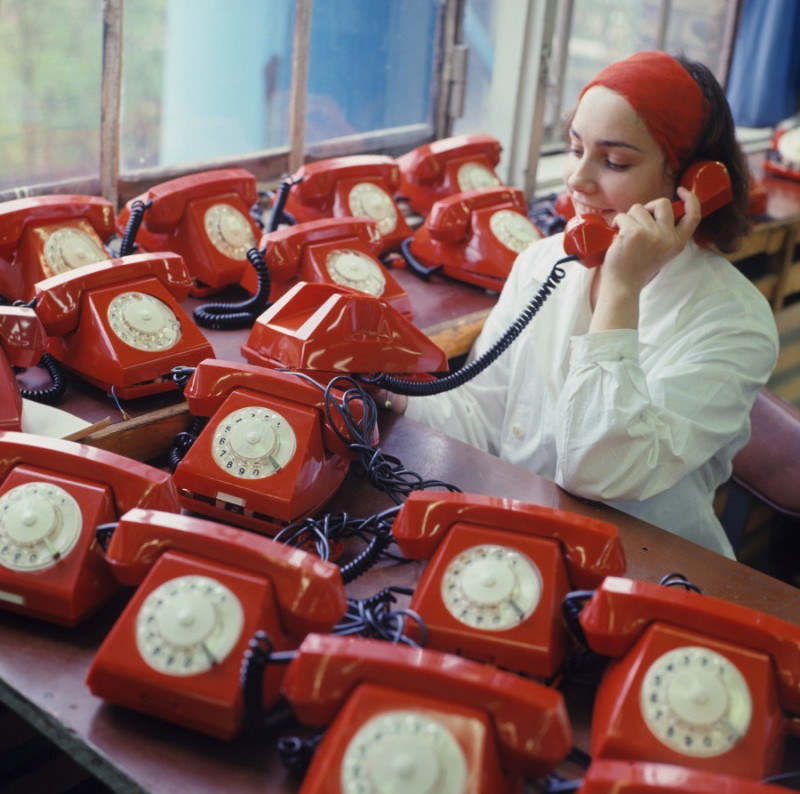
Для советского человека телефон имел особое значение: даже в середине 80-х в столице хватало квартир без проведенных в них линий. В коммуналках стоял один аппарат на всех, в поселках в 20 км от Москвы телефоны были редкостью, что уж говорить про остальную страну.
И даже при наличии телефона всегда велики были шансы не дозвониться: не застать человека дома или нарваться на наглухо занятую линию, потому что кто-то на том конце заболтался или плохо положил трубку. А уж междугородные звонки и вовсе были приключением.
Межгород надо было заказывать к определенному времени, а телефонистки имели возможность слушать разговор и часто не стеснялись это делать. Впрочем, отсутствие конфиденциальности разговоров подразумевалось всегда. То, что вашу линию может прослушивать товарищ майор, причем без всякого на то ордера, советский человек принимал как данность.
А путаница, когда к беседе внезапно подключалась другая линия («Ой, кто это? Повесьте немедленно трубку!» — «Сами повесьте!»), вообще была обычным делом.
Словом, телефонный аппарат в СССР был окутан ореолом мистики, романтики и непредсказуемости. К тому же вид этих устройств почти всегда был неплох — как и все остальные, советские дизайнеры тоже питали к телефонам теплые чувства. А из какого материала делали аппараты в 30-х — 50-х годах!
Бакелит, он же карболит, был тяжелым, ударопрочным и твердым, то есть устойчивым к царапинам. Трубкой такого телефона запросто можно было оглушить оппонента. В общем, нам немного не хватает этих старых советских телефонов.
Хотя есть умельцы, которые подключают к старым аппаратам GSM-модуль, что позволяет снова ими пользоваться без подключения проводных линий. Хотя носить их с собой, пожалуй, было бы немного неудобно.
Вернёмся к теме статьи:
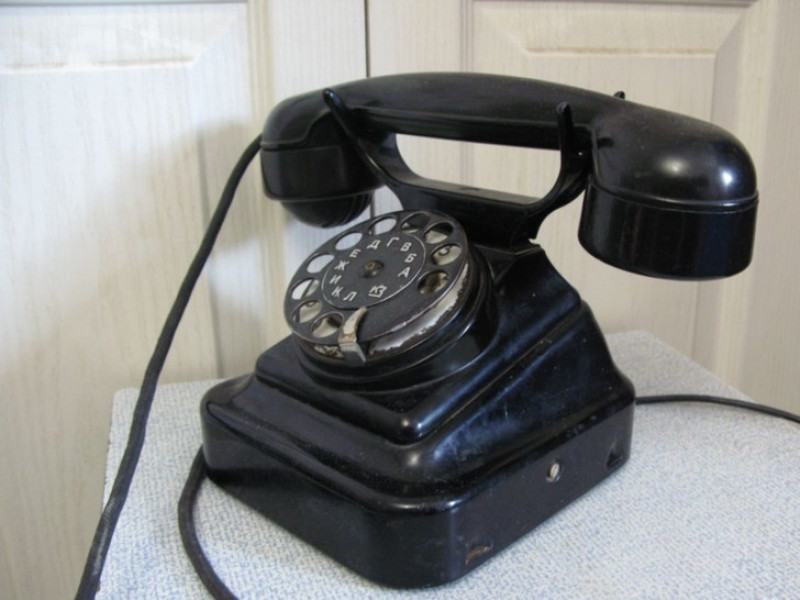
Телефон ленинградской фабрики «Красная заря», 1930-е годы. Вещь одновременно массивная и изящная.
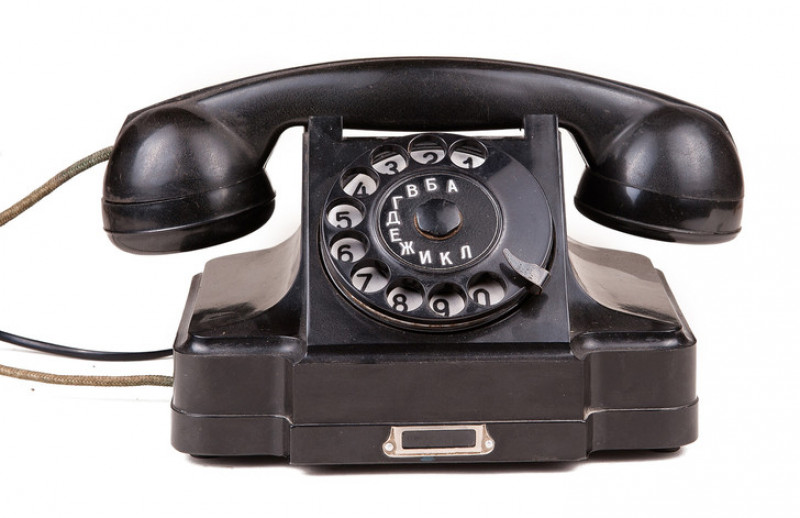
Аппарат ТАН-6м производства Пермского телефонного завода. Конец 1950-х. Буквы на внутренней части диска нанесены светящейся краской.
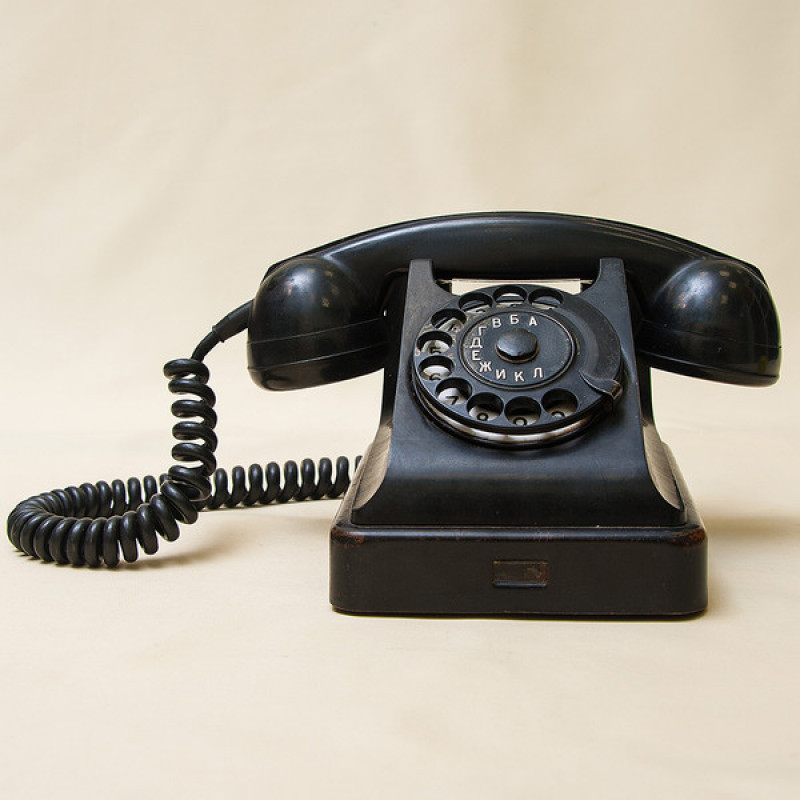
VEF БАГТА-50 выпускали на Рижском государственном электротехническом заводе «ВЭФ» в Латвийской ССР с 1950 по 1965 год. Это был, наверное, самый массовый аппарат в стране в те годы.
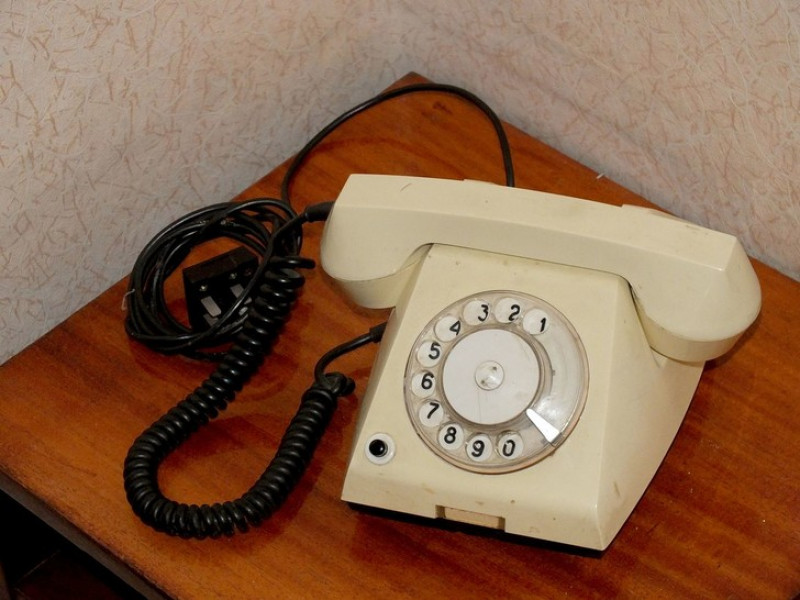
VEF ТА-68, самый распространенный в СССР аппарат в 1970-е — 1980-е годы.
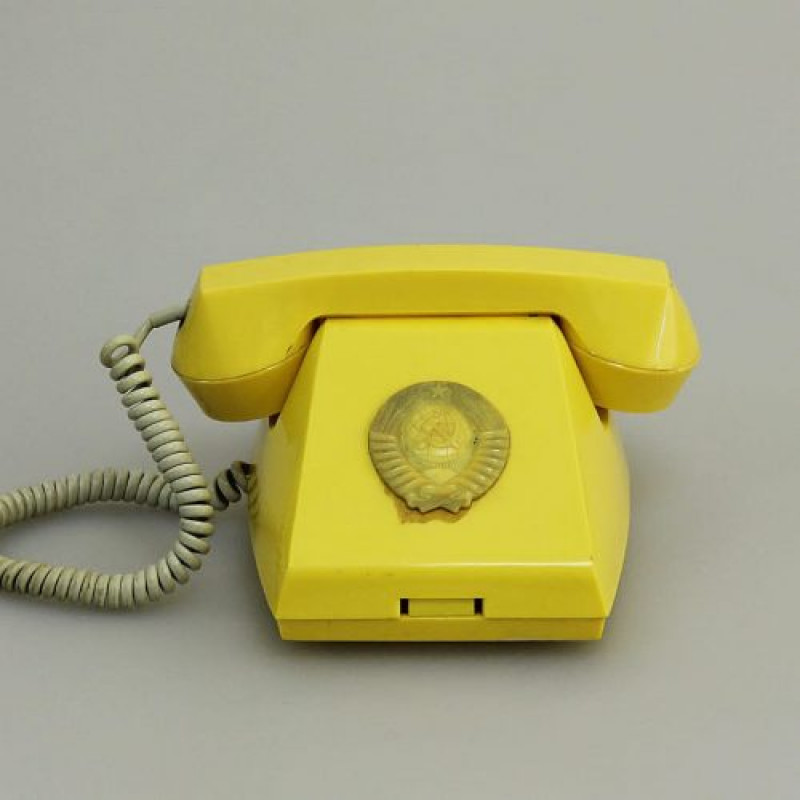
VEF ТА-68 без номеронабирателя. Такой использовали в заоблачно высоких кабинетах. При снятии трубки происходило соединение с телефонисткой, которой можно было просто сказать: «С директором главка меня соедините, пожалуйста», не напрягая мозг запоминанием номеров и обходясь без записных книжек.
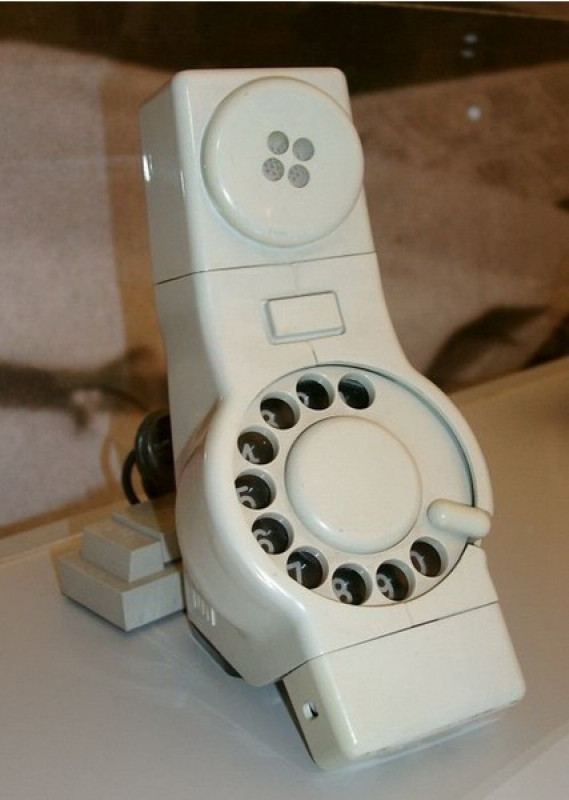
ТА-1158 «Тон» Пермского телефонного завода, 1980-е годы. Одна из последних разработок предприятия, сувенирно-подарочная вещь. Не очень изящная, но оригинальная.
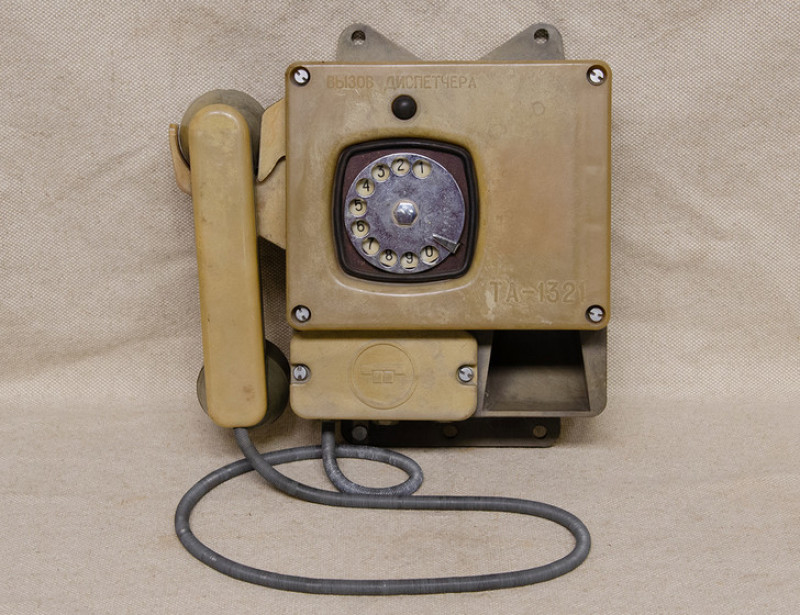
Индустриальный телефон ТА-1321 (Пермский телефонный завод). Был рекомендован к применению в металлургических цехах и на горнодобывающих предприятиях, в том числе на шахтах, невзрывоопасных по пыли и газу.
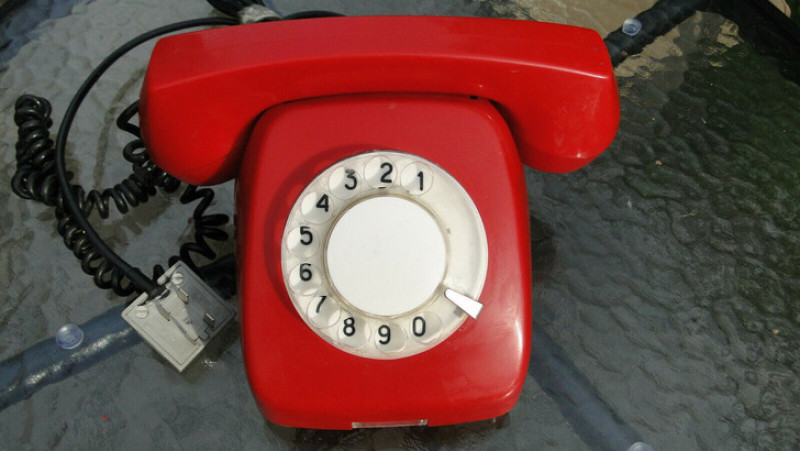
Продукция Польской социалистической республики: Jaskier-74.

«Спектр» ТА-1128, Пермский телефонный завод, 1980-е. Вроде бы только компоновка изменена, а вид совсем другой, заграничный.
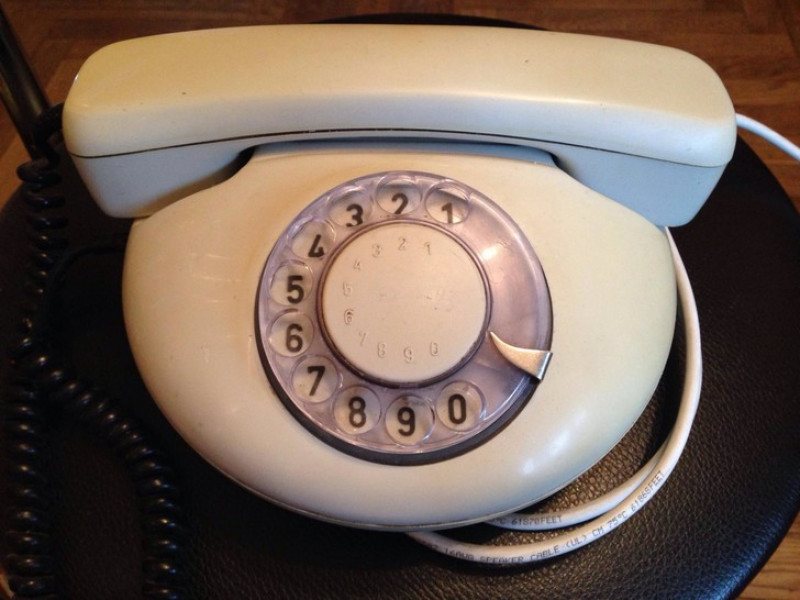
Чешское изделие с космическим дизайном — Tesla Stropkov DS2300. Редкая и модная вещь.
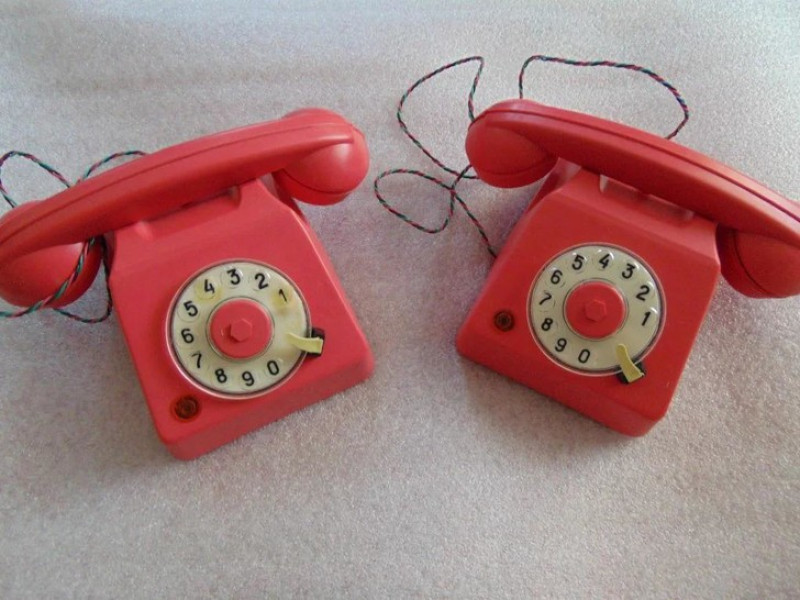
Детский телефон был чудом техники и заветной мечтой многих. Помните рассказ Николая Носова «Телефон»? А нынешние дети, скорее всего, уже не поймут, о чем там вообще речь.
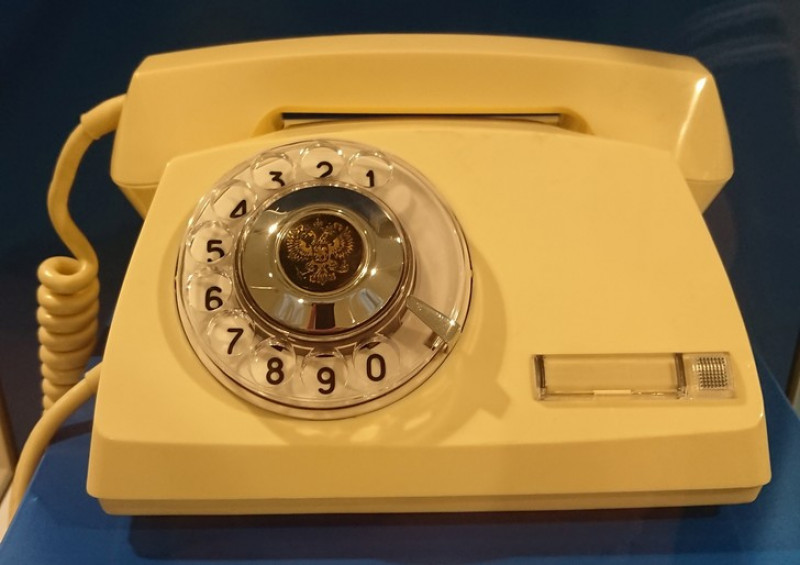
VEF СТА-2, «вертушка» — аппарат для правительственной секретной связи. Устанавливали их только специально обученные офицеры. А название «вертушка» прижилось, когда в Кремле появились первые в стране телефоны с дисковым набором.
См.также:
Музей Истории Телефона
Винтажные девушки и… телефон!
Как появилось слово «Алло», и что говорят, принимая телефонный звонок в других странах
Гробовщик-телефонист Элмон Строуджер
Мобильная система «Алтай»
В Телеграм!
Ностальгия по «долопатной» эпохе.
В 2007 году Apple удалось изменить общепринятое представление о смартфонах с релизом iPhone — из громоздких и не слишком интуитивных гаджетов карманные компьютеры превратились в удобные устройства на каждый день.
iPhone задал направление, в котором индустрия развивалась последующие десять лет, и именно он помог Apple обрести титул одной из самых дорогостоящих компаний в истории.
Кнопочные телефоны остались в прошлом — будущее оказалось в руках сенсорных устройств. А с этим завершилась и эпоха больших мобильных экспериментов — почти все телефоны в течение нескольких лет превратились в банальные «лопаты».
Но похоже, что в 2020 году это может измениться — мобильные гиганты вдруг вспомнили свои корни и снова начали экспериментировать. Правда, пока что «новый» тренд всего один — раскладушки.
Уже сейчас можно купить тот же Motorola Razr или Samsung Galaxy Z Flip и попасть в волну «бета-тестеров» (устройства отнюдь не совершенны) или подождать развития сиутации. А там, может, и TCL доведёт концепт телефона со скручивающимся экраном до реализации.
О ренессансе мобильных экспериментов из нулевых говорить пока рано, однако мы всё же решили вспомнить самые необычные устройства из прошлого, авторы которых не боялись пробовать новое.
Nokia 9000 (1996)
В 1995 году Hewlett-Packard и Nokia объявили о своём сотрудничестве — результатом этого необычного партнёрства стал персональный карманный компьютер HP OmniGo 700LX, который вышел уже в марте 1996. Он был не принципиально новым продуктом, а всего лишь ревизией HP 200LX, к которой сверху был прикреплён телефон Nokia 2110.
Nokia 9000 стал своеобразным ответом HP OmniGo 700LX и вышел в том же году. Компьютер Hewlett-Packard с большой натяжкой можно было отнести к категории «2 в 1», хоть речь и шла о двух отдельных устройствах. А вот Nokia 9000 уже был «цельным» девайсом, который часто называют первым смартфоном.
Alcatel OT Com (1998)
Alcatel OT Com — ещё один представитель ранних смартфонов. По возможностям и мощностям ему, конечно, было далеко до Nokia 9000, но зато он мог похвастаться сенсорным экраном.
Речь, конечно же, не о сенсорном экране в современном его понимании — управлять Alcatel OT Com приходилось с помощью стилуса, который крепился к корпусу телефона. Но на этом сложности не заканчивались.
У экрана OT Com отсутствовало защитное стекло и он легко подвергался царапинам. Отсюда и несколько чудаковатый дизайн телефона, с вынесенными на верхний безель кнопками «Вызов» и «Завершить вызов». От случайных же повреждений экран защищала прозрачная пластиковая крышка.
Ericsson R310s (2000)
Обязательным атрибутом большинства ранних мобильных телефонов была небольшая антенна. Независимо от того, складывалась она или нет, ломалась она чуть ли ни в первую очередь.
Ericsson в своём R310s попыталась решить эту проблему — в этом телефоне антенна была защищена специальным колпаком, который напоминал рыбий плавник. Да и в целом «трубка» позиционировалась как идеальный девайс для тех, кто любит активный отдых — корпус должен был пережить удар или падение, а также защитить «начинку» от пыли и воды.
Sagem 939 WAP и Sagem 959 (2000)
Sagem хочется похвалить как минимум за упорство — компания годами шла против устоявшихся норм. И речь не только о странноватых устройствах. Дело в том, что кнопки «Вызов» и «Завершить вызов» на их телефонах годами находились не слева и справа от крестовины, а справа и слева соответственно.
Исключением не стали Sagem 939 WAP и Sagem 959. Но всё же особенностью этих «трубок» была защитная крышка, которую можно было использовать как и подставку. Может показаться, что Sagem смотрели в будущее с его многофункциональными док-станциями. Вот только и у 939 WAP и 959 гнездо зарядки находилось на нижней грани, что делало подзарядку в вертикальном положении попросту невозможной.
Nokia 5510 (2001)
В начале нулевых популярность текстинга лишь росла. Но если с клавиатуры компьютера набирать электронные письма (или же переписываться в ICQ) было более чем удобно, то владельцы мобильных вытянули короткую соломинку.
Большинство мобильных телефонов выпускалось с традиционным цифровым блоком, который существенно замедлял набор текста. Поэтому в Nokia решили пойти на компромисс и создали Nokia 5510 — модель телефона, которая идеально подходила людям, не представляющим свою жизнь без переписки.
Финские инженеры по сути переделали Nokia 3310, добавив полноценную qwerty-клавиатуру. Ну а возможность прослушивать MP3-файлы явно не помешала популярности Nokia 5510.
Danger Hiptop (2002)
Danger Hiptop — по-настоящему уникальный для своего времени девайс. Устройство совмещало в себе функционал коммуникатора и мобильного телефона — по сути оно было полноценным смартфоном. Но всё же выделялся телефон не за счёт своего функционала.
Дисплей Danger Hiptop не перемещался как на обычном телефоне-слайдере. Для того, чтобы раскрыть устройство нужно было легко нажать на уголок экрана и тот, совершая поворот на 180 градусов, открывал qwerty-клавиатуру. И на это лучше всего просто посмотреть.
Но на этом причуды не заканчиваются — на телефоне было очень удобное колёсико навигации, которое ещё и выполняло функции индикатора. Дело в том, что оно было прозрачным и в зависимости от контекста светилось тем или иным цветом.
Telit G80 (2003)
Telit G80 — ещё один телефон, дизайн которого говорит сам за себя. Его странности вполне можно было бы списать на эпоху. Или же на желание производителя выделиться — Telit были хорошо известны своими необычными устройствами.
Тем не менее за всеми этими странностями прячется имя Джорджетто Джуджаро — легендарного автомобильного дизайнера. Именно он отвечал за дизайн DMC DeLorean, хорошо всем известной по трилогии «Назад в будущее». Также Джуджаро проектировал прототипы компьютеров для Apple, занимался внешним видом фотоаппаратов Nikon, а на старости лет — даже дизайном тракторов.
Panasonic G70 (2003)
В 2020 году очень сложно назвать пример современного «женского» или «мужского» телефона — подобное разделение осталось в прошлом. Но вот как раз в этом прошлом (а точнее в нулевых) оно помогало производителям завоёвывать новых пользователей.
К концу 2003 года у Panasonic уже был опыт в создании «женских» телефонов, но с G70 они зашли ещё дальше — устройство было выполнено в виде пудреницы. На этом необычные решения не заканчивались — разъем для зарядки был совмещен с разъемом для гарнитуры, а для замены аккумулятора нужно было лишь приподнять клавиатуру.
Haier P5 (2003)
Не сложно догадаться, что от «современников» Haier P5 отличался именно своим необычным форм-фактором — продолговатый телефон легко выделялся на фоне десятков различных моноблоков, слайдеров и раскладушек. В длину он достигал внушительных на то время 13,5 см. Сейчас же, в эпоху смартфонов с шестидюймовыми экранами, этим мало кого удивишь. Да и габариты телефона были вполне сопоставимы с размерами авторучки.
Подобное сравнение было слишком любопытным, чтобы пройти мимо — Haier активно использовали эту схожесть в своих в промо-материалах. Ну а зажим на задней крышке, прямо как на большинстве ручек, и встроенная лазерная указка явно не мешали. За устройством закрепилось имя, по которому его многие помнят и до сих пор — pen phone или «телефон-ручка».
Этот телефон продавался и в России. В какой-то мере успех этой модели повлиял на решение китайской компании полноценно выйти на европейский рынок. Точных данных о продажах телефона нет, однако после него вышла ещё пара «старших» моделей, в которых сохранили основу дизайна, но добавили лоска.
Nokia 6800 (2003)
Именно благодаря своей qwerty-клавиатуре Nokia 5510 пользовался популярностью среди любителей текстинга. Но если для этой цели он подходил практически идеально, то другие ежедневные задачи выполнять на нём было не совсем удобно. А вот к Nokia 6800 эту претензию предъявить было трудно.
Эта модель продолжала идеи, заложенные в Nokia 5510 и даже серии Nokia Communicator, совмещая в одном корпусе «обычную» клавиатуру и qwerty-клавиатуру. К тому же теперь «трубка» умела не только принимать и отправлять короткие текстовые сообщения, но и электронные письма.
Nokia 7600 (2003)
Nokia 7600 — это попросту один из самых странных мобильных телефонов. В своё время профильные сайты даже не знали с чем сравнивать его форму — то ли с листиком, то ли с каплей воды.
Функционал Nokia 7600 уж точно не мог расстроить его потенциального владельца, а вот цена в 400-500 долларов вполне могла. При этом на звание флагмана модель не тянула.
На практике оказалось, что телефон довольно неудобен в использовании. Он хоть и помещался в одной ладони, но пользоваться им нужно было именно держа его в двух руках. Ну а необычное расположение клавиш ставило крест на интуитивности набора текста.
Siemens Xelibri Series (2003)
В 2003 году Siemens Mobile в качестве эксперимента запустила целую линейку странных телефонов, которая получила название Xelibri. Каждый представитель этой серии мог похвастаться уникальным дизайном. Но, к сожалению, внешний вид этих устройств был их единственной сильной стороной.
Телефоны были неудобны в использовании, а их «железо» было позаимствовано из бюджетных аппаратов Siemens. При этом цены кусались — на старте продаж самая дешевая модель стоила более 1690 долларов.
Эксперимент провалился — не помогла даже дорогостоящая рекламная кампания. Модельный ряд, который пользовался популярностью на раннем периоде своей жизни, не показал выдержки. Всего-лишь спустя год после анонса Siemens Mobile свернула линейку Xelibri.
Nokia N-Gage (2003)
В начале нулевых большой популярностью у геймеров пользовался Game Boy Advance — портативная игровая консоль от Nintendo. Благодаря небольшой цене и каталогу игр, который постоянно пополнялся новыми хитами, она превратилась не просто в одну из самых популярных «портативок», а в одну из самых продаваемых консолей в истории.
Именно на фоне популярности Game Boy Advance в Nokia решили, что устройство, которое совместит в себе функционал консоли и телефона, может достигнуть невероятного успеха. Не трудно догадаться, что этим устройством стал Nokia N-Gage.
Аппарат был анонсирован в ноябре 2002 года, а в октябре 2003 он уже попал на прилавки магазинов. К тому моменту N-Gage был не просто каким-то гибридным телефоном, а самой мощной портативной приставкой. Поэтому и цена у него была соответствующая — 299 долларов против 100 долларов за Game Boy Advance.
N-Gage мог похвастаться вполне убедительным набором игр (к 2006 году вышло более полусотни тайтлов): как эксклюзивами вроде Ashen, Pathway to Glory, The Elder Scrolls Travels: Shadowkey и WWE Aftershock, так и своими версиями известных игр, вроде Call of Duty, Spider-Man 2 и Splinter Cell: Chaos Theory.
К сожалению, Nokia N-Gage не оправдал возложенные на него ожидания и был окрещён провалом. В Nokia рассчитывали, что смогут продать шесть миллионов устройств к концу 2004 года, а смогли реализовать всего три миллиона до конца 2007.
NEC N900 (2004)
Само существование этого телефона — уже целое достижение. В этом устройстве попросту не было микрофона, не было навигационной крестовины, а его клавиатура почему-то находилась справа от дисплея.
Позвонить же кому-то с NEC N900 можно было лишь с использованием гарнитуры, а листать меню нужно было цифровыми клавишами, которые было очень и очень неудобно использовать.
Более того, в комплекте с телефоном шла док-станция со своим встроенным аккумулятором.
Panasonic X300 (2004)
Внешний вид Panasonic X300 довольно обманчив. Невнимательному человеку может показаться, что это просто типичная для своего времени «трубка». А на самом же деле это целый камерафон-трансформер.
Если у большинства камерафонов того времени объектив находился на задней крышке, то у X300 он был на левой грани и прятался за специальной шторкой. А для перехода в фоторежим нужно было буквально повернуть дисплей, превратив телефон в некое подобие видеокамеры.
Nokia 3220 (2004)
Может показаться, что в сравнении с другими телефонами из этого списка, Nokia 3220 выглядит «нормальнее» всего. Но это лишь по той простой причине, что на него нужно смотреть не на фотографиях, а в действии.
На боковинах телефона находились специальные прорезиненные вставки, скрывавшие под собой светодиоды. Если владельцу телефона кто-то звонил или же он просто решил послушать музыку через динамик, то всё это превращалось в целое световое шоу.
Более того, этому телефону, как и некоторым другим моделям Nokia, в народе приписывали возможность «танцевать», которая вместе с подсветкой выглядела ещё убедительней.
Nokia 7280 (2004)
Nokia 7280 — легендарный «телефон-помада» и, пожалуй, одно из самых узнаваемых мобильных устройств своего времени.
Так как красота требовала жертв, данная модель полностью лишилась цифровой клавиатуры, а отвечать на звонки приходилось раздвигая защитную шторку камеры. Управлять же телефоном приходилось с помощью специального навигационного колёсика.
Жертвы себя вполне оправдали — профильные издания в унисон хвалили дизайн телефона. Да, добавлять новые номера в «Контакты» или же ответить на SMS с Nokia 7280 было неудобно, но и покупался он не для этого. Nokia 7280 был показателем статуса и вкуса.
Motorola MPx (2004)
Необычный дизайн Motorola MPx говорит сам себя — устройство было двойной «раскладушкой. В стандартном положении телефон выглядел как обычный представитель этого форм-фактора, но стоило нажать на специальную кнопку, и уже через пару секунд он превращался в полноценный коммуникатор.
Windows 2003 for Pocket PC Second Edition позволял устройству практически мгновенно переключаться между режимом телефона и режимом коммуникатора. Хотя именно как телефон-раскладушку MPx было несколько неудобно использовать из-за его габаритов.
Среди коммуникаторов своего времени Motorola MPx не мог похвастаться какими-то особенными характеристиками, но своим дизайном однозначно привлекал.
Nokia N90 (2005)
В отличие от других телефонов Nokia из этого списка, N90 — не просто странный телефон с интересным дизайном, а ещё и самый настоящий флагман.
N90 всё ещё был «раскладушкой», но при надобности, как и Panasonic X300, превращался в девайс, напоминающий цифровую видеокамеру. Вот только телефон Nokia предлагал лучшую на тот момент мобильную камеру с оптикой от Carl Zeiss, а также один из самых ярких и чётких мобильных дисплеев.
На фоне того же Nokia 7280 дизайн N90 не выглядел таким уж радикальным. Хоть это всё ещё и был дорогой статусный телефон, но он привлекал внимание и обычных пользователей. В какой-то мере Nokia N90 можно даже сравнить с современными iPhone — это был дорогой, престижный флагман, о котором мечтали многие.
Asus P505 (2005)
Хоть Asus P505 и относился к коммуникатором, но при этом имел модуль сотовой связи и (почти что) полноценную цифровую клавиатуру, присущую мобильным.
При надобности крышечку с цифровым блоком нужно было открыть, таким образом получив доступ к сенсорному дисплею. Именно в «раскрытом» состоянии телефоном можно было воспользоваться на всю. Ну а стоило его закрыть, как гаджет сразу же переходил в «телефонный» режим, под который даже был создан альтернативный интерфейс.
На месте Asus P505 в этом списке вполне мог быть Kyocera 6035, на который он так похож. Но если Kyocera 6035 была устройством-аномалией (совмещал в себе функционал КПК и телефон), то Asus P505 уже был симбиозом этих технологий и по сути связующим звеном между КПК и смартфонами.
Nokia 3250 (2006)
Nokia 3250 — уникальное в своём роде устройство. Блок цифровой клавиатуры этого телефона использовал специальный поворотный механизм. На его левой грани находилась камера, а сзади — клавиши управления музыкой.
Если повернуть телефон должным образом, то сразу же включался режим фотосъемки. Более того, поворотный механизм даже позволял делать самые настоящие селфи. Ну а стоило повернуть клавиатуру на 180 градусов, и мобильный телефон превращался в полноценный музыкальный плеер.
Да и сама Nokia продвигала этот аппарат именно как музыкальный. Что, правда, не помешало потом выпустить новую ревизию телефона с припиской XpressMusic.
Samsung Serene (2005) и Samsung Serenata (2007)
В 2005 году Samsung объединилась с датской компанией Bang & Olufsen, которая известна своей стильной техникой, чтобы создать телефон премиум-класса. В теории это устройство должно было конкурировать с телефонами Nokia в этом же сегменте. Но что-то пошло не так.
В погоне за минимализмом инженеры вырезали из Serene как ненужные элементы, так и нужные — у необычной «раскладушки» не было уже привычного внешнего мини-дисплея, а его камера безнадёжно устарела. Также у Serene отсутствовала поддержка Java-приложений, что не так уж и странно для телефона 2005 года, но странно для устройства, которое продавали за 1000 евро.
Serenata же хоть и ушла в сторону музыкального телефона, но продолжала идеи Serene — как хорошие, так и плохие. На смену цифровой клавиатуре пришло колёсико навигации и сенсорный экран, камера пропала вообще, а поддержка Java-приложений так и не появилась.
BenQ-Siemens EF51 (2006)
Если Nokia 3250 был телефоном, который можно было превратить в музыкальный плеер, то BenQ-Siemens EF51 выглядел как музыкальный плеер, который можно было превратить в телефон.
Шутки шутками, а EF51 действительно принадлежал именно категории «музыкальных» телефонов. Специфический дизайн должен был привлечь именно меломанов.
Музыкальные клавиши EF51 находились на специальной откидной крышке, под которой был спрятан цифровой блок. Работали же они только в прямом контакте с основной клавиатурой, то есть если откидная крышка была закрыта.
LG V9000 (2006)
Телефон, представленный ещё в 2005 году, легко выделялся даже на фоне флагманов того времени. А всё благодаря специальному поворотному механизму дисплея. Такой необычный дизайн был продиктован тем, что устройство поддерживало функцию трансляции телевизионных каналов в мобильном формате.
Хотя для LG это был первый мобильный подобного форм-фактора, но он навсегда остался в тени своего именитого брата — LG VX9400. Тому удалось попасть в историю в качестве телефона самого Тони Старка в фильме «Железный человек».
Toshiba G450 (2008)
Как бы парадоксально это ни звучало, но Toshiba G450 был телефоном, который лучше было не использовать как телефон вообще. Его внешний вид хвалили с той же страстью, с которой ругали саму модель за неудобство в пользовании.
Управлять телефоном приходилось с помощью двух клавиш-качелек, которые были размещены на левой и правой грани телефона. Кроме того функции качелек менялись в зависимости от того, какое именно меню просматривает пользователей. Ну а дисплей был слишком маленьким, чтобы делать это хотя бы с минимальным комфортом.
На самом же деле Toshiba G450 не был телефоном в привычном его понимании — это был хороший для своего времени 3G-модем для ПК, которому навязали урезанный функционал мобильного телефона.
Motorola AURA (2008)
Корпус из нержавеющей стали, сапфировое стекло, механизм от швейцарских часовщиков и куча предустановленных циферблатов. Нет, это не описание новой модели Apple Watch — это описание Motorola AURA.
Внешне телефон напоминал Motorola V70, но если у того был прямоугольный дисплей, вписанный в круг, то AURA мог похвастаться полноценным круглым дисплеем. Но с подобным дизайном были связаны и свои недостатки — многие элементы интерфейса выходили за рамки экрана или же приходилось мириться с прямоугольными окнами, вписанными в круг.
Подобных шероховатостей было много, но всё же это был телефон класса «люкс» с соответствующей ценой, который должен был выполнять две функции — звонить и красиво выглядеть.
Microsoft Kin ONE и Microsoft Kin TWO (2010)
Под конец нулевых в Microsoft начали понимать, что бум смартфонов проходит мимо них — своих устройств компания не выпускала, а их мобильная операционная система Microsoft Mobile безнадёжно устарела.
Чтобы наверстать упущенное в Microsoft решили выступить сразу на двух фронтах — выпустить смартфон под своим брендом и сразу же на новой системе. Результатом этого стали устройства серии Kin, которые даже не были смартфонами (на них нельзя было устанавливать сторонние приложения) и работали не на принципиально новой оси, а на Microsoft CE.
Kin ONE и Kin TWO позиционировались как телефоны для молодежи, которая много времени уделяет социальным сетям. Под эти цели была создана целая эксклюзивная экосистема приложений во главе с Loop — гибридным агрегатором новостей и постов из Twitter, Facebook и MySpace. Вот только работал Loop с задержкой в пятнадцать минут, а прямо из него нельзя было что-то ретвитнуть или же ответить на сообщение.
Долгие годы разработки, смена платформы на полпути, внутренние разборки, неудачная рекламная кампания и потраченный миллиард долларов, а как результат — менее десяти тысяч проданных устройств. Не помогли и скорый перезапуск с мягким ребрендингом — выпуск устройств был прекращён, а к 2011 году были закрыты все связанные с ними сервисы.
Но у всего этого была одна светлая сторона — Kin всё же удалось опередить своих конкурентов. Дело в том, что на этих телефонах все фото, видео и текстовые сообщения незаметно сохранялись в облаке. Ни Apple, ни Google тогда ещё не могли похвастаться такой простотой этих процессов.
Kyocera Echo (2011)
Kyocera Echo — это в каком-то смысле прадедушка складных смартфонов. А компания Sprint, которая занималась его распространением на территории США, и вовсе позиционировала Echo как первый в мире телефон с двойным сенсорным экраном.
Возможно, что в 2011 году массовый потребитель ещё не был готов к подобному типу устройству. Но пример Kyochera Echo доказал, что смартфон, который при надобности можно превратить в планшет, обладает огромным потенциалом. Устройство поддерживало мультитаскинг — на каждом дисплее можно было запустить по отдельной программе. Обычные же приложения начинали играть новыми красками при запуске в двухэкранном режиме.
Но Echo напоролся на несколько подводных камней — два экрана невероятно быстро садили аккумулятор, большинство приложений попросту не поддерживали развёртку, а огромная чёрная полоса между экранами действовала на нервы.
Asus PadFone (2012)
В первой половине прошлого десятилетия произошел так называемый «планшетный бум» — с 2010 по 2015 год объёмы продаж планшетных компьютеров лишь росли. Свою лепту в него внесла и компания Asus. Ей даже удалось войти в историю, выпустив Eee Pad Transformer Prime — первый в мире планшет с четырёхъядерным процессором. Не менее интересным устройством был и PadFone.
PadFone — полноценный смартфон-флагман от Asus. Возможно, что издалека его можно было и спутать с iPhone 4, но язык не поворачивался назвать его странным. Удивляло разве только наличие разъема micro-HMDI, а также то, что он располагался на боку устройства.
Вместе с PadFone можно было купить PadFone Station (устройство, напоминающее толстоватый планшет) и PadFone Station Dock (док-станция/клавиатура). На задней стороне PadFone Station находился специальный кармашек, в который можно было поместить PadFone — после этого устройство начинало функционировать как планшетный компьютер. А если поместить PadFone Station в док-станцию, то и в полноценный нетбук.
YotaPhone (2013)
Производители мобильных устройств долгое время игрались с идеей создания устройства с двумя полноценными дисплеями, но в формате телефона-моноблока. К счастью или к сожалению, но подобные аппараты зачастую оставались на стадии концептов и прототипов. Ну а просто второй дисплей можно было встреть и в обычных массовых «раскладушках».
Дальше всех в этом направлении зашла Yota Devices с её YotaPhone — смартфоном, на задней стороне которого находился второй экран, выполненный по технологии электронной бумаги. Из-за низкого энергопотребление второй дисплей всегда оставался включенным, а на него можно было выводить кучу полезной информации.
Дизайн YotaPhone хвалили как российские издания, так и зарубежные. А его уникальность помогла телефону завоевать несколько профильных наград. Но из-за того, что устройство слишком долго находилось в разработке, к моменту релиза его железо было несколько устаревшим, а цена казалась завышенной.
YotaPhone был далёк от звания идеального телефона — слишком неудобное расположение камеры, под второй дисплей катастрофически не хватало приложений, а сам девайс мог вылетать без очевидной на то причины. Тем не менее такой уникальный дизайн позволял закрыть глаза даже на существенные недостатки аппарата.
Samsung SCH-W2013 (2013)
Не смотря на то, что на улице уже 2020 год многие производители мобильных устройств продолжают выпускать телефоны-раскладушки. Исключением не стала и Samsung. А это вовсе и не странно — этот форм-фактор до сих пор очень популярен в Китае и Южной Корее.
Но всё же современным «раскладушкам» от Samsung удаётся выделиться на фоне соперников — они оснащены двумя полноценными сенсорными дисплеями. А последний представитель этой серии (Samsung W2020) и вовсе может похвастаться флагманскими характеристиками.
Пожалуй самый интересный представитель этой линейки — Samsung SCH-W2013. Этот смартфон был представлен во время специального благотворительного концерта. Характеристики этого аппарата вполне соответствовали своему времени, а вот цена удивляла — 3000 долларов.
Телефон явно был нацелен на состоятельных людей, а в его продвижении участвовал Джеки Чан, которому W2013 и вовсе достался бесплатно.
Palm PVG-100 (2018)
Телефонов с экспериментальным дизайном в наше время всё меньше и меньше, поэтому иногда чтобы выделиться на фоне остальных, достаточно лишь выпустить устройство небольшого размера.
Palm PVG-100 — милый смартфон с диагональю экрана в 3,3 дюйма. Это, правда, уже не тот самый Palm, выпускавший КПК — устройство было создано китайской TCL, которая сейчас владеет правами на бренд.
Но быть милым мало. PVG-100, как и большинство странных телефонов, оказался попросту неудобным в использовании. А всё из-за его главной отличительной черты — малого размера.
Видимо, что в TCL это всё прекрасно понимали и позиционировали его как замену умным часам или же как второй телефон. А людям, которые все же решились полностью перейти на PVG-100, пророчили то, что они будут проводить в социальных сетях в два, а то и три раза меньше времени.
Так складываемые смартфоны это просто кратковременный тренд или за ними будущее? Сейчас на этот вопрос лучше не отвечать вообще. Когда-то будущее было за Danger Hiptop, когда-то за Nokia N90 и даже за Asus PadFone.
Что-то кратковременно, а что-то не очень, но ясно одно — всем этим телефонам всегда найдётся место в наших воспоминаниях. А какие необычные телефоны из прошлого помните вы? Делитесь в комментариях.
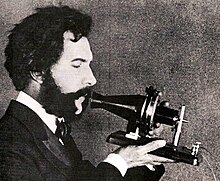
Actor portraying Alexander Graham Bell in a 1926 silent film. Shows Bell’s first telephone transmitter (microphone), invented 1876 and first displayed at the Centennial Exposition, Philadelphia.
This history of the telephone chronicles the development of the electrical telephone, and includes a brief overview of its predecessors. The first telephone patent was granted to Alexander Graham Bell in 1876.
Mechanical and acoustic devices[edit]

A 19th century acoustic tin can or «lovers’ telephone»
Before the invention of electromagnetic telephones, mechanical acoustic devices existed for transmitting speech and music over a greater distance. This distance was greater than that of normal direct speech. The earliest mechanical telephones were based on sound transmission through pipes or other physical media.[1] The acoustic tin can telephone, or «lovers’ phone», has been known for centuries.[1] It connects two diaphragms with a taut string or wire, which transmits sound by mechanical vibrations from one to the other along the wire (and not by a modulated electric current). The classic example is the children’s toy made by connecting the bottoms of two paper cups, metal cans, or plastic bottles with tautly held string.[1][2]
Some of the earliest known experiments were conducted by the British physicist and polymath, Robert Hooke, from 1664 to 1685.[1][3] An acoustic string phone made in 1667 has been attributed to him.[4] An early version was also found in use by the Chimu in Peru. The gourd and stretched-hide version resides in the Smithsonian Museum collection and dates back to around the 7th century AD.[5]
For a few years in the late 1800s, acoustic telephones were marketed commercially as a competitor to the electrical telephone. When the Bell telephone patents expired and many new telephone manufacturers began competing, acoustic telephone makers quickly went out of business. Their maximum range was very limited.[2] An example of one such company was the Pulsion Telephone Supply Company created by Lemuel Mellett in Massachusetts, which designed its version in 1888 and deployed it on railroad right-of-ways.
Additionally, speaking tubes have long been common, especially within buildings and aboard ships, and they are still in use today.[6]
Electrical devices[edit]
The telephone emerged from the making and successive improvements of the electrical telegraph. In 1804, Spanish polymath and scientist Francisco Salva Campillo constructed an electrochemical telegraph.[7] The first working telegraph was built by the English inventor Francis Ronalds in 1816 and used static electricity.[8] An electromagnetic telegraph was created by Baron Schilling in 1832. Carl Friedrich Gauss and Wilhelm Weber built another electromagnetic telegraph in 1833 in Göttingen. At the University of Gottingen, the two had been working together in the field of magnetism. They built the first telegraph to connect the observatory and the Institute of physics, which was able to send eight words per minute.[9]

Bell prototype telephone stamp
Centennial Issue of 1976
The electrical telegraph was first commercialized by Sir William Fothergill Cooke and entered use on the Great Western Railway in England. It ran for 13 mi (21 km) from Paddington station to West Drayton and came into operation on April 9, 1839.
Another electrical telegraph was independently developed and patented in the United States in 1837 by Samuel Morse. His assistant, Alfred Vail, developed the Morse code signaling alphabet with Morse. America’s first telegraph was sent by Morse on January 6, 1838, across 2 miles (3 km) of wiring.
Invention of the telephone[edit]
Credit for the invention of the electric telephone is frequently disputed, and new controversies over the issue have arisen from time to time. Antonio Meucci, Alexander Graham Bell, and Elisha Gray amongst others, have all been credited with the telephone’s invention. The early history of the telephone became and still remains a confusing morass of claims and counterclaims, which were not clarified by the huge number of lawsuits filed in order to resolve the patent claims of the many individuals and commercial competitors. The Bell and Edison patents, however, were commercially decisive, because they dominated telephone technology and were upheld by court decisions in the United States.
-

Philipp Reis, 1861, constructed the first telephone, today called the Reis telephone.
-


The master telephone patent granted to Bell, 174465, March 10, 1876
The modern telephone is the result of the work of many people.[10] Alexander Graham Bell was, however, the first to patent the telephone, as an «apparatus for transmitting vocal or other sounds telegraphically». Bell has most often been credited as the inventor of the first practical telephone. Johann Philipp Reis coined the term «telephon».[11] Models of it were sent abroad, to London, Dublin, Tiflis, and other places. It became a subject for popular lectures, and an article for scientific cabinets. Edison credited him as the «first inventor of the telephone.»[12]
The Italian-American inventor and businessman Antonio Meucci has been recognized by the U.S. House of Representatives for his contributory work on the telephone.[13] Several other controversies also surround the question of priority of invention for the telephone.
The Elisha Gray and Alexander Bell telephone controversy considers the question of whether Bell and Gray invented the telephone independently and, if not, whether Bell stole the invention from Gray. This controversy is narrower than the broader question of who deserves credit for inventing the telephone, for which there are several claimants.
The Canadian Parliamentary Motion on Alexander Graham Bell article reviews the controversial June 2002 United States House of Representatives resolution recognizing Meucci’s contributions ‘in’ the invention of the telephone (not ‘for’ the invention of the telephone). The same resolution was not passed in the U.S. Senate, thus labeling the House resolution as «political rhetoric». A subsequent counter-motion was unanimously passed in Canada’s Parliament 10 days later which declared Bell its inventor. This webpage examines critical aspects of both the parliamentary motion and the congressional resolution.
Telephone exchange[edit]
The main users of the electrical telegraph were post offices, railway stations, the more important governmental centers (ministries), stock exchanges, very few nationally distributed newspapers, the largest internationally important corporations, and wealthy individuals.[14]
Telegraph exchanges worked mainly on a store and forward basis. Although telephones devices were in use before the invention of the telephone exchange, their success and economical operation would have been impossible with the schema and structure of the contemporary telegraph systems.
Prior to the invention of the telephone switchboard, pairs of telephones were connected directly with each other, which was primarily useful for connecting a home to the owner’s business (They practically functioned as a primitive intercom).[15] A telephone exchange provides telephone service for a small area. Either manually by operators, or automatically by machine switching equipment, it interconnects individual subscriber lines for calls made between them. This made it possible for subscribers to call each other at homes, businesses, or public spaces. These made telephones an available and comfortable communication tool for many purposes, and it gave the impetus for the creation of a new industrial sector.
The telephone exchange was an idea of the Hungarian engineer Tivadar Puskás (1844–1893) in 1876, while he was working for Thomas Edison on a telegraph exchange.[16][17][18][19][20] The first commercial telephone exchange was opened at New Haven, Connecticut, with 21 subscribers on 28 January 1878,[21] in a storefront of the Boardman Building in New Haven, Connecticut. George W. Coy designed and built the world’s first switchboard for commercial use. Coy was inspired by Alexander Graham Bell’s lecture at the Skiff Opera House in New Haven on 27 April 1877.[21]
In Bell’s lecture, during which a three-way telephone connection with Hartford and Middletown, Connecticut, was demonstrated, he first discussed the idea of a telephone exchange for the conduct of business and trade. On 3 November 1877, Coy applied for and received a franchise from the Bell Telephone Company for New Haven and Middlesex Counties. Coy, along with Herrick P. Frost and Walter Lewis, who provided the capital, established the District Telephone Company of New Haven on 15 January 1878.[21]
The switchboard built by Coy was, according to one source, constructed of «carriage bolts, handles from teapot lids and bustle wire.» According to the company records, all the furnishings of the office, including the switchboard, were worth less than forty dollars. While the switchboard could connect as many as sixty-four customers, only two conversations could be handled simultaneously and six connections had to be made for each call.[21]
The District Telephone Company of New Haven went into operation with only twenty-one subscribers, who paid $1.50 per month. By 21 February 1878, however, when the first telephone directory was published by the company, fifty subscribers were listed. Most of these were businesses and listings such as physicians, the police, and the post office; only eleven residences were listed, four of which were for persons associated with the company.[21]
The New Haven District Telephone Company grew quickly and was reorganized several times in its first years. By 1880, the company had the right from the Bell Telephone Company to service all of Connecticut and western Massachusetts. As it expanded, the company was first renamed Connecticut Telephone, and then Southern New England Telephone in 1882.[21] The site of the first telephone exchange was granted a designation as a National Historic Landmark on 23 April 1965. However it was withdrawn in 1973 in order to demolish the building and construct a parking garage.[21]
Early telephone developments[edit]
The following is a brief summary of the history of the development of the telephone:
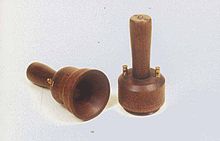

- Early 7th century AD — Chimu culture in Peru invents a string telephone using gourds and stretched hide. The original artifact is in the Smithsonian’s National Museum of the American Indian storage facility in Suitland, Maryland.
- 1667: Robert Hooke invents a string telephone that conveys sounds over an extended wire by mechanical vibrations. It was to be termed an ‘acoustic’ or ‘mechanical’ (non-electrical) telephone.
- 1753: Charles Morrison proposes the idea that electricity can be used to transmit messages, by using different wires for each letter.[22]
- 1844: Innocenzo Manzetti first moots the idea of a «speaking telegraph» (telephone).
- 1854: Charles Bourseul writes a memorandum on the principles of the telephone. (See the article: «Transmission électrique de la parole», L’Illustration, Paris, 26 August 1854.)
- 1854: Antonio Meucci demonstrates an electric voice-operated device in New York; exactly what kind of device he demonstrates is unknown.
- 1861: Philipp Reis constructs the first speech-transmitting telephone
- 28 December 1871: Antonio Meucci files a patent caveat (No. 3353, a notice of intent to invent, but not a formal patent application) at the U.S. Patent Office for a device he names a «Sound Telegraph».[23]
- 1872: Elisha Gray establishes Western Electric Manufacturing Company.
- 1 July 1875: Bell uses a bi-directional «gallows» telephone that is able to transmit «voicelike sounds», but not clear speech. Both the transmitter and the receiver are identical membrane electromagnet instruments.
- 1875: Thomas Edison experiments with acoustic telegraphy and in November builds an electro-dynamic receiver, but does not exploit it.
- 1875: Hungarian Tivadar Puskás (the inventor of the telephone exchange) arrives in the USA.
- 6 April 1875: Bell’s U.S. Patent 161,739 «Transmitters and Receivers for Electric Telegraphs» is granted. This uses multiple vibrating steel reeds in make-break circuits, and the concept of multiplexed frequencies.
- 20 January 1876: Bell signs and notarizes his patent application for the telephone.
- 11 February 1876: Elisha Gray designs a liquid transmitter for use with a telephone, but does not build one.
- 7 March 1876: Bell’s U.S. patent No. 174,465 for the telephone is granted.
- 10 March 1876: Bell transmits the sentence: «Mr. Watson, come here! I want to see you!» using a liquid transmitter and an electromagnetic receiver.
- 10 August 1876: Using the telegraph line between Brantford and Paris, Ontario, eight miles (thirteen kilometres) distant, Bell makes a telephone call, said by some to be the «world’s first long-distance call».[24]
- 30 January 1877: Bell’s U.S. patent No. 186,787 is granted for an electromagnetic telephone using permanent magnets, iron diaphragms, and a call bell.
- 27 April 1877: Edison files for a patent on a carbon (graphite) transmitter. Patent No. 474,230 is granted on 3 May 1892, after a 15-year delay because of litigation. Edison is later granted patent No. 222,390 for a carbon granules transmitter in 1879.
- 6 October 1877: Scientific American publishes the invention from Bell—at that time still without a ringer.
- 25 October 1877: the article in Scientific American is discussed at the Telegraphenamt in Berlin
- 12 November 1877: The first commercial telephone company enters telephone business in Friedrichsberg close to Berlin[25] using the Siemens pipe as ringer and telephone devices built by Siemens.
- 1877: The first experimental Telephone Exchange is established in Boston.
- 1877: First long-distance telephone line
- 1877: Emile Berliner invents the telephone transmitter.
- 14 January 1878: Bell demonstrates the telephone to Queen Victoria and makes the first publicly-witnessed long-distance calls in the UK. The queen tries the device and finds it to be «quite extraordinary».[26]
- 26 January 1878: The first permanent telephone connection in the UK is made between two businesses in Manchester
- 28 January 1878: The first commercial US telephone exchange opens in New Haven, Connecticut.
- 15 June 1878: The first commercial toll line enters operation, connecting Springfield and Holyoke, Massachusetts[27]
- 1887: Tivadar Puskás introduces the multiplex switchboard, that has an epochal significance in the further development of telephone exchanges.[28]
- 1915: The first U.S. coast-to-coast long-distance telephone call, is ceremonially inaugurated by A.G. Bell in New York City and his former assistant Thomas Augustus Watson in San Francisco, California.
- 1927: The first transatlantic phone call is made, from the United States to the United Kingdom.[29]
Early commercial instruments[edit]
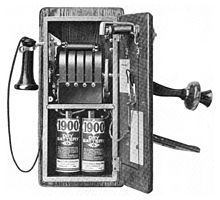
1917 wall telephone, open to show magneto and local battery
Early telephones were technically diverse. Some of them used liquid transmitters which soon went out of use. Others were dynamic: their diaphragms vibrated a coil of wire in the field of a permanent magnet or vice versa. Such sound-powered telephones survived in small numbers through the 20th century in military and maritime applications where the ability to create its own electrical power was crucial. Most, however, used Edison/Berliner carbon transmitters, which were much louder than the other kinds, even though they required induction coils, actually acting as impedance matching transformers to make it compatible to the line impedance. The Edison patents kept the Bell monopoly viable into the 20th century, by which time telephone networks were more important than the instrument.
Early telephones were locally powered by a dynamic transmitter. One of the jobs of outside plant personnel was to visit each telephone periodically to inspect the battery. During the 20th century, the «common battery» operation came to dominate, and was powered by the «talk battery» from the telephone exchange over the same wires that carried the voice signals. Late in the century, wireless handsets brought a revival of local battery power.
The earliest telephones had only one wire for transmitting and receiving of audio, and used a ground return path. The earliest dynamic telephones also had only one opening for sound, and the user listened and spoke into the same hole. Sometimes the instruments were operated in pairs at each end, making conversation more convenient but also more expensive.

Historical marker commemorating the first telephone central office in New York State (1878)
At first, telephones were leased in pairs to the subscriber, for example one for his home and one for his shop, and the subscriber had to arrange with telegraph contractors to construct a line between them. Users who wanted the ability to speak to three or four different shops, suppliers etc. would obtain and set up three or four pairs of telephones. Western Union, already using telegraph exchanges, quickly extended the principle to its telephones in New York City and San Francisco, and Bell was not slow in appreciating the potential.
Signaling began in an appropriately primitive manner. The user alerted the other end, or the exchange operator, by whistling into the transmitter. Exchange operation soon resulted in telephones being equipped with a bell, first operated over a second wire and later with the same wire using a condenser. Telephones connected to the earliest Strowger automatic exchanges had seven wires, one for the knife switch, one for each telegraph key, one for the bell, one for the push button and two for speaking.
Rural and other telephones that were not on a common battery exchange had hand cranked «magneto» generators to produce an alternating current to ring the bells of other telephones on the line and to alert the exchange operator.
In 1877 and 1878, Edison invented and developed the carbon microphone used in all telephones along with the Bell receiver until the 1980s. After protracted patent litigation, a federal court ruled in 1892 that Edison and not Emile Berliner was the inventor of the carbon microphone. The carbon microphone was also used in radio broadcasting and public address work through the 1920s.
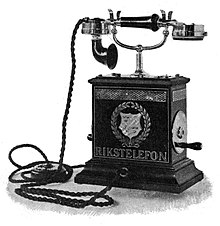
In the 1890s a new smaller style of telephone was introduced, the candlestick telephone, and it was packaged in three parts. The transmitter stood on a stand, known as a «candlestick» for its shape. When not in use, the receiver hung on a hook with a switch in it, known as a «switchhook.» Previous telephones required the user to operate a separate switch to connect either the voice or the bell. With the new kind, the user was less likely to leave the phone «off the hook». In phones connected to magneto exchanges, the bell, induction coil, battery, and magneto were in a separate bell box called a «ringer box.» In phones connected to common battery exchanges, the ringer box was installed under a desk, or other out of the way place, since it did not need a battery or magneto.
Cradle designs were also used at this time, with a handle with the receiver and transmitter attached, separate from the cradle base that housed the magneto crank and other parts. They were larger than the «candlestick» and more popular.
Disadvantages of single-wire operation, such as crosstalk and hum from nearby AC power wires, had already led to the use of twisted pairs and, for long-distance telephones, four-wire circuits. Users at the beginning of the 20th century did not place long-distance calls from their own telephones but made an appointment to use a special sound-proofed long-distance telephone booth furnished with the latest technology.
Around 1893, the country leading the world in telephones per 100 persons—known as teledensity—was Sweden with 0.55 in the whole country but 4 in Stockholm (10,000 out of a total of 27,658 subscribers).[30] This compares with 0.4 in the US for that year.[31] Telephone service in Sweden developed through a variety of institutional forms: the International Bell Telephone Company (a U.S. multinational), town and village co-operatives, the General Telephone Company of Stockholm (a Swedish private company), and the Swedish Telegraph Department (part of the Swedish government). Since Stockholm consists of islands, telephone service offered relatively large advantages, but had to use submarine cables extensively. Competition between Bell Telephone and General Telephone, and later between General Telephone and the Swedish Telegraph Dept., was intense.
In 1893, the U.S. was considerably behind Sweden, New Zealand, Switzerland, and Norway in teledensity. The U.S. became the world leadership in teledensity with the rise of many independent telephone companies after the Bell patents expired in 1893 and 1894.
20th-century developments[edit]
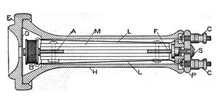
Old Receiver schematic, c.1906


Top of cellular telephone tower
By 1904, over three million phones in the U.S.[32] were connected by manual switchboard exchanges. By 1914, the U.S. was the world leader in telephone density and had more than twice the teledensity of Sweden, New Zealand, Switzerland, and Norway. The relatively good performance of the U.S. occurred despite competing telephone networks not interconnecting.[33] On January 7, 1927, W. S. Gifford, president of the American Telephone & Telegraph Company, called Evelyn P. Murray to test the first commercial telephone line across the Atlantic Ocean.[29]
What turned out to be the most popular and longest-lasting physical style of telephone was introduced in the early 20th century, including Bell’s model 102 telephone. A carbon granule transmitter and electromagnetic receiver were united in a single molded plastic handle, which when not in use were placed in a cradle in the base unit. The circuit diagram[34] of the model 102 shows the direct connection of the receiver to the line, while the transmitter was induction coupled, with energy supplied by a local battery. The coupling transformer, battery, and ringer were in a separate enclosure from the desk set. The rotary dial in the base interrupted the line current by repeatedly but very briefly disconnecting the line 1 to 10 times for each digit, and the hook switch (in the center of the circuit diagram) permanently disconnected the line and the transmitter battery while the handset was on the cradle.
Starting in the 1930s, the base of the telephone also enclosed its bell and induction coil, obviating the need for a separate ringer box. Power was supplied to each subscriber line by central-office batteries instead of the user’s local battery, which required periodic service. For the next half century, the network behind the telephone grew progressively larger and much more efficient, and, after the rotary dial was added, the instrument itself changed little until Touch-Tone signaling started replacing the rotary dial in the 1960s.
The history of mobile phones can be traced back to two-way radios permanently installed in vehicles such as taxicabs, police cruisers, railroad trains, and the like. Later versions such as the so-called transportables or «bag phones» were equipped with a cigarette-lighter plug so that they could also be carried, and thus could be used as either mobile two-way radios or as portable phones by being patched into the telephone network.
In December 1947, Bell Labs engineers Douglas H. Ring and W. Rae Young proposed hexagonal cell transmissions for mobile phones.[35] Philip T. Porter, also of Bell Labs, proposed that the cell towers be at the corners of the hexagons rather than the centers and have directional antennas that would transmit/receive in 3 directions (see picture at right) into 3 adjacent hexagon cells.[36][37] The technology did not exist then and the radio frequencies had not yet been allocated. Cellular technology was undeveloped until the 1960s, when Richard H. Frenkiel and Joel S. Engel of Bell Labs developed the electronics.
Meanwhile, the 1956 inauguration of the TAT-1 cable and later international direct dialing were important steps in putting together the various continental telephone networks into a global network.
On 3 April 1973, Motorola manager Martin Cooper placed a cellular-phone call (in front of reporters) to Dr. Joel S. Engel, head of research at AT&T’s Bell Labs. This began the era of the handheld cellular-mobile phone.
Cable-television companies began to use their fast-developing cable networks with ducting under the streets of the United Kingdom in the late 1980s to provide telephony services in association with major telephone companies. One of the early cable operators in the UK, Cable London, connected its first cable telephone customer in about 1990.
Digital telephone technology[edit]
The rapid development and wide adoption of pulse-code modulation (PCM) digital telephony was enabled by metal–oxide–semiconductor (MOS) technology.[38] The MOS field-effect transistor (MOSFET) was invented by Mohamed M. Atalla and Dawon Kahng at Bell Telephone Laboratories in 1959, and the MOS integrated circuit (MOS IC) chip was proposed soon after, but MOS technology was initially overlooked by Bell because they did not find it practical for analog telephone applications, before it was commercialized by Fairchild and RCA for digital electronics such as computers.[39][38] MOS technology eventually became practical for telephone applications with the MOS mixed-signal integrated circuit, which combines analog and digital signal processing on a single chip, developed by former Bell engineer David A. Hodges with Paul R. Gray at UC Berkeley in the early 1970s.[38] In 1974, Hodges and Gray worked with R.E. Suarez to develop MOS switched capacitor (SC) circuit technology, which they used to develop the digital-to-analog converter (DAC) chip, using MOSFETs and MOS capacitors for data conversion. This was followed by the analog-to-digital converter (ADC) chip, developed by Gray and J. McCreary in 1975.[38]
MOS SC circuits led to the development of PCM codec-filter chips in the late 1970s.[38][40] The silicon-gate CMOS (complementary MOS) PCM codec-filter chip, developed by Hodges and W.C. Black in 1980,[38] has since been the industry standard for digital telephony.[38][40] By the 1990s, telecommunication networks such as the public switched telephone network (PSTN) had been largely digitized with very-large-scale integration (VLSI) CMOS PCM codec-filters, widely used in switching systems for telephone exchanges, private branch exchanges (PBX) and key telephone systems (KTS); user-end modems; data transmission applications such as digital loop carriers, pair gain multiplexers, telephone loop extenders, integrated services digital network (ISDN) terminals, digital cordless telephones and digital cell phones; and applications such as speech recognition equipment, voice data storage, voice mail and digital tapeless answering machines.[40] The bandwidth of digital telecommunication networks has been rapidly increasing at an exponential rate, as observed by Edholm’s law,[41] largely driven by the rapid scaling and miniaturization of MOS technology.[42][38]
The British companies Pye TMC, Marconi-Elliott and GEC developed the digital push-button telephone, based on MOS IC technology, in 1970. It was variously called the «MOS telephone», the «push-button telephone chip», and the «telephone on a chip». It used MOS IC logic, with thousands of MOSFETs on a chip, to convert the keypad input into a pulse signal. This made it possible for push-button telephones to be used with pulse dialing at most telephone exchanges.[43][44] MOS telephone technology introduced a new feature: the use of MOS memory chips to store phone numbers, which could then be used for speed dialing at the push of a button.[43][44][45] This was demonstrated in the United Kingdom by Pye TMC, Marcno-Elliot and GEC in 1970.[43][44] Between 1971 and 1973, Bell combined MOS technology with touch-tone technology to develop a push-button MOS touch-tone phone called the «Touch-O-Matic» telephone, which could store up to 32 phone numbers. This was made possible by the low cost, low power requirements, small size and high reliability of MOSFETs, over 15,000 of which were contained on ten MOS IC chips, including one chip for logic, one for the keypad dial interface, and eight for memory.[46]
Women’s usage in the 20th century[edit]

Private conversation, 1910
The telephone was instrumental to modernization. It aided in the development of suburbs and the separation of homes and businesses, but also became a reason for the separation between women occupying the private sphere and men in the public sphere.[47] Both historically and currently, women are predominantly responsible for the telephone calls that bridge the public and private sphere, such as calls regarding doctor’s appointments and meetings.[48]
21st-century developments[edit]
Internet Protocol (IP) telephony, also known as Internet telephony or Voice over Internet Protocol (VoIP), is a disruptive technology that is rapidly gaining ground against traditional telephone network technologies.

Modern Apple Iphone. This phone is considered a smartphone
IP telephony uses a broadband Internet service to transmit conversations as data packets. In addition to replacing the traditional plain old telephone service (POTS) systems, IP telephony competes with mobile phone networks by offering free or lower cost service via WiFi hotspots. VoIP is also used on private wireless networks which may or may not have a connection to the outside telephone network.
Telecommunication of the 21st century has been dominated by the development of the smartphone. This is a combination of a hand-held computer, a cellular phone, a digital camera, and Internet access. One of its features is the touch screen that facilitates the primary interaction for users for most tasks, such as dialing telephone numbers. Some of its software features also include email communication, as well as audio and video playback and capture.
See also[edit]
- Bell Telephone Memorial, a major monument dedicated to the invention of the telephone
- Carbon microphone
- Charles Bourseul – claimed inventor of the telephone
- Elisha Gray
- Elisha Gray and Alexander Bell telephone controversy
- History of mobile phones
- History of telecommunication
- History of videotelephony
- Innocenzo Manzetti
- Invention of the telephone
- Johann Philipp Reis – claimed inventor of the telephone
- Antonio Meucci – claimed inventor of the telephone
- Private branch exchange
- Push-button telephone
- Telephone exchange
- The Telephone Cases, a series of court decisions in the U.S. on the telephone’s invention
- Thomas Edison’s carbon telephone transmitter – greatly improved the telephone’s sound quality
- Timeline of the telephone
References[edit]
- ^ a b c d McVeigh, Daniel P.
An Early History of the Telephone: 1664-1866: Robert Hooke’s Acoustic Experiments and Silent Inventions Archived 24 May 2014 at the Wayback Machine, Columbia University website. Retrieved 15 January 2013. This work in turn cites:- Richard Waller and edited by R.T. Gunther. «The Postthumous Works of Robert Hooke, M.D., S.R.S. 1705.» Reprinted in R.T. Gunther’s «Early Science In Oxford», Vol. 6, p. 185, 25
- ^ a b Jacobs, Bill. Acoustic Telephones, TelefoonMuseum.com website. Retrieved 15 January 2013. This article in turn cites:
- Kolger, Jon. «Mechanical or String Telephones», ATCA Newsletter, June 1986; and
- «Lancaster, Pennsylvania Agricultural Almanac for the Year 1879: How to Construct a Farmer’s Telephone», John Bater’s Sons.; and
- «Telephone Experiences of Harry J. Curl as told by him to E. T. Mahood, During the summer of 1933 at Kansas City, Missouri: First Telephone Experience.»
- ^ Grigonis, Richard. x +jchdjn$hbdgdveudydcgeenterprise-fixed-communications/articles/47924-telephone-1665.htm A Telephone can 1665?[permanent dead link], TMCNet Technews website, 29 December 2008.
- ^ Giles, Arthur (editor). County Directory of Scotland (for 1901-1904): Twelfth Issue: Telephone (Scottish Post Office Directories), Edinburgh: R. Grant & Son, 1902, p. 28.
- ^ Baldwin, Neil. «There’s a 1,200-year-old Phone in the Smithsonian Collections». smithsonianmag.com. Smithsonian Museum. Retrieved 20 August 2022.
- ^ «Voicepipes and Speaking-Tubes». The Museum of Retro-Technology. 15 March 2010. Retrieved 17 October 2012.
- ^ Jones, R. Victor S Archived 11 October 2012 at the Wayback Machine d» Electrochemical Telegraph (1808-10)], Harvard University website. Attributed to «Semaphore to Satellite», International Telecommunication Union, Geneva 1965. Retrieved 2009-05-01
- ^ Ronalds, B.F. (2016). Sir Francis Ronalds: Father of the Electric Telegraph. London: Imperial College Press. ISBN 978-1-78326-917-4.
- ^ Hentschel, K. (March 1999). «Some Historical Points of Interest in Göttingen». Physics in Perspective. 1 (1): 110–117. Bibcode:1999PhP…..1..110H. doi:10.1007/s000160050009. ISSN 1422-6944. S2CID 119459958.
- ^ Lewis Coe (1995), «The Telephone and Its Several Inventors»
- ^ http://news.bbc.co.uk/2/hi/science/nature/3253174.stm
- ^ Edison, Thomas A. The Edison Papers, Digital Edition Rutgers University, accessed 26 March 2006. LB020312 TAEM 83:170
- ^ «H.Res.269 — Expressing the sense of the House of Representatives to honor the life and achievements of 19th-century Italian-American inventor Antonio Meucci, and his work in the invention of the telephone. 107th Congress (2001-2002)». U.S. House of Representatives. 11 June 2002. Retrieved 7 February 2014.
- ^ Private Telegraphs, The Sydney Morning Herald, credited to The Times, 19 April 1878, p. 6.
- ^ Bo Leuf (2002). Peer to Peer: Collaboration and Sharing Over the Internet. Addison-Wesley. p. 15. ISBN 9780201767322.
- ^ Alvin K. Benson (2010). Inventors and inventions Great lives from history Volume 4 of Great Lives from History: Inventors & Inventions. Salem Press. p. 1298. ISBN 9781587655227.
- ^ Puskás Tivadar (1844 — 1893) (short biography), Hungarian History website. Retrieved from Archive.org, February 2013.
- ^ «Puskás Tivadar (1844 — 1893)». Mszh.hu. Archived from the original on 8 October 2010. Retrieved 1 July 2012.
- ^ «Puskás, Tivadar». Omikk.bme.hu. Retrieved 1 July 2012.
- ^ «Welcome hunreal.com — BlueHost.com». Hunreal.com. Archived from the original on 16 March 2012. Retrieved 1 July 2012.
- ^ a b c d e f g
Withdrawal of National Historic Landmark Designation: Site of the First Telephone Exchange, New Haven, New Haven County, Connecticut, United States National Park Service, United States Department of the Interior, 13 April 2006.Archived 15 August 2012 at the Wayback Machine
- ^ «History Of The Invention Of Telephone». The Reverse Phone. 9 June 2011. Retrieved 22 April 2012.
- ^ «Antonio Meucci — Questions and Answers». Chezbasilio.org. Retrieved 30 August 2012.
- ^ «Alexander Graham Bell 1847-1922 Inventor of the Bell System». Telecommunications Canada. Retrieved 14 January 2020.
- ^ «Cdrtools (Cdrecord) release information».
- ^ «Alexander Graham Bell demonstrates the newly invented telephone». The Telegraph. 13 January 2017. Archived from the original on 12 January 2022. Retrieved 14 January 2020.
- ^ «Southern New England Telephone Company: The First Fifty Years, 1878-1928». Thomas J. Dodd Research Center. University of Connecticut. Archived from the original on 9 June 2008.
- ^ Francis S. Wagner: Hungarian Contributions to World Civilization – Page 68
- ^ a b «First Transatlantic Telephone Call». Retrieved 22 March 2019.
- ^
Bennett, Alfred Roslin (1895). Telephone Systems of the Continent of Europe. p. 337. Retrieved 14 June 2012. - ^
«Early U.S. Telephone Industry Data». Retrieved 15 June 2012. - ^ «AT&T: History: Origins». Corp.att.com. Archived from the original on 20 August 2012. Retrieved 30 August 2012.
- ^ «Leaders in the early spread of telephone service». Purplemotes.net. 21 March 2010.
- ^ «Fig I-102 Type Sidetone Hand Telephone Set Shown with 534Y Subscriber Set». Archived from the original on 16 June 2007. Retrieved 29 May 2007.
- ^ «1947 memo by Douglas H. Ring proposing hexagonal cells» (PDF). Archived from the original (PDF) on 7 February 2012. Retrieved 30 August 2012.
- ^ Farley, Tom; van der Hoek, Mark (1 January 2006). «Cellular Telephone Basics». PrivateLine. Archived from the original on 3 May 2012. Retrieved 22 April 2012.
- ^ interview of Joel S. Engel, page 17 (image 18) Archived 16 June 2007 at the Wayback Machine
- ^ a b c d e f g h Allstot, David J. (2016). «Switched Capacitor Filters». In Maloberti, Franco; Davies, Anthony C. (eds.). A Short History of Circuits and Systems: From Green, Mobile, Pervasive Networking to Big Data Computing (PDF). IEEE Circuits and Systems Society. pp. 105–110. ISBN 9788793609860.
- ^ Maloberti, Franco; Davies, Anthony C. (2016). «History of Electronic Devices». A Short History of Circuits and Systems: From Green, Mobile, Pervasive Networking to Big Data Computing (PDF). IEEE Circuits and Systems Society. pp. 59-70 (65-7). ISBN 9788793609860.
- ^ a b c Floyd, Michael D.; Hillman, Garth D. (8 October 2018) [1st pub. 2000]. «Pulse-Code Modulation Codec-Filters». The Communications Handbook (2nd ed.). CRC Press. pp. 26–1, 26–2, 26–3. ISBN 9781420041163.
- ^ Cherry, Steven (2004). «Edholm’s law of bandwidth». IEEE Spectrum. 41 (7): 58–60. doi:10.1109/MSPEC.2004.1309810. S2CID 27580722.
- ^ Jindal, Renuka P. (2009). «From millibits to terabits per second and beyond — Over 60 years of innovation». 2009 2nd International Workshop on Electron Devices and Semiconductor Technology: 1–6. doi:10.1109/EDST.2009.5166093. ISBN 978-1-4244-3831-0. S2CID 25112828.
- ^ a b c «Push-button telephone chips» (PDF). Wireless World: 383. August 1970.
- ^ a b c Valéry, Nicholas (11 April 1974). «Debut for the telephone on a chip». New Scientist. Reed Business Information. 62 (893): 65–7. ISSN 0262-4079.
- ^ Electronic Components. U.S. Government Printing Office. 1974. p. 23.
- ^ Gust, Victor; Huizinga, Donald; Paas, Terrance (January 1976). «Call anywhere at the touch of a button» (PDF). Bell Laboratories Record. 54: 3–8.
- ^ Kramarae, Cheris; Lana F. Rakow, eds. (1988). Technology and women’s voices : keeping in touch (1. publ. ed.). New York: Routledge & Kegan Paul. p. 209. ISBN 0710206798. Retrieved 9 February 2014.
- ^ Kramarae, Cheris; Lana F. Rakow, eds. (1988). Technology and women’s voices : keeping in touch (1. publ. ed.). New York: Routledge & Kegan Paul. p. 217. ISBN 978-0710206794.
- This article includes text from Withdrawal of National Historic Landmark Designation: Site of the First Telephone Exchange, New Haven, New Haven County, Connecticut, by the United States National Park Service, a work in the public domain.
Further reading[edit]
- Baker, Burton H. (2000), The Gray Matter: The Forgotten Story of the Telephone, Telepress, St. Joseph, MI, 2000. ISBN 0-615-11329-X
- Bruce, Robert V. (1990), Alexander Graham Bell and the Conquest of Solitude, Cornell University Press, Ithaca, 1990.
- Casson, Herbert N. (March 1910). «The Birth Of The Telephone: Its Invention Not An Accident But The Working Out Of A Scientific Theory». The World’s Work: A History of Our Time. XIX: 12669–12683. Retrieved 10 July 2009.
- Casson, Herbert N. (May 1910). «The Future Of The Telephone: The Dawn Of A New Era Of Expansion». The World’s Work: A History of Our Time. XX: 12903–12918. Retrieved 10 July 2009.
- Coe, Lewis (1995), The Telephone and Its Several Inventors: A History, McFarland, North Carolina, 1995. ISBN 0-7864-0138-9
- Evenson, A. Edward (2000), The Telephone Patent Conspiracy of 1876: The Elisha Gray — Alexander Bell Controversy, McFarland, North Carolina, 2000. ISBN 0-7864-0883-9
- Huurdeman, Anton A. (2003), The Worldwide History of Telecommunications, IEEE Press and J. Wiley & Sons, 2003. ISBN 0-471-20505-2
- John, Richard R (2010), Network Nation: Inventing American Telecommunications, Harvard University Press, 2010; traces the evolution of the country’s telegraph and telephone networks.
- Josephson, Matthew (1992), Edison: A Biography, Wiley, 1992. ISBN 0-471-54806-5
- Wheen, Andrew (2011), DOT-DASH TO DOT.COM: How Modern Telecommunications Evolved from the Telegraph to the Internet (Springer, 2011). ISBN 978-1-4419-6759-6
- Martin, Michèle (1988). «Feminisation of the Labour Process in the Communication Industry: The Case of the Telephone Operators, 1876-1904». Labour / Le Travail. 22: 139. doi:10.2307/25143030.
External links[edit]
- Silvanus P. Thompson — Philipp Reis: Inventor of the Telephone A Biographical Sketch, London, 1883
- Kempe, Harry Robert; Garcke, Emile (1911). «Telephone» . Encyclopædia Britannica. Vol. 26 (11th ed.). pp. 547–557.
- «Alexander Graham Bell (1847-1922)». Scottish Science Hall of Fame. National Library of Scotland. Retrieved 31 January 2014.
- History of the Telephone in Washington, DC — Ghosts of DC blog
- Jay L. Zagorsky (14 March 2019). «Rise and fall of the landline: 143 years of telephones becoming more accessible – and smart». The Conversation. Retrieved 3 April 2022.

Actor portraying Alexander Graham Bell in a 1926 silent film. Shows Bell’s first telephone transmitter (microphone), invented 1876 and first displayed at the Centennial Exposition, Philadelphia.
This history of the telephone chronicles the development of the electrical telephone, and includes a brief overview of its predecessors. The first telephone patent was granted to Alexander Graham Bell in 1876.
Mechanical and acoustic devices[edit]

A 19th century acoustic tin can or «lovers’ telephone»
Before the invention of electromagnetic telephones, mechanical acoustic devices existed for transmitting speech and music over a greater distance. This distance was greater than that of normal direct speech. The earliest mechanical telephones were based on sound transmission through pipes or other physical media.[1] The acoustic tin can telephone, or «lovers’ phone», has been known for centuries.[1] It connects two diaphragms with a taut string or wire, which transmits sound by mechanical vibrations from one to the other along the wire (and not by a modulated electric current). The classic example is the children’s toy made by connecting the bottoms of two paper cups, metal cans, or plastic bottles with tautly held string.[1][2]
Some of the earliest known experiments were conducted by the British physicist and polymath, Robert Hooke, from 1664 to 1685.[1][3] An acoustic string phone made in 1667 has been attributed to him.[4] An early version was also found in use by the Chimu in Peru. The gourd and stretched-hide version resides in the Smithsonian Museum collection and dates back to around the 7th century AD.[5]
For a few years in the late 1800s, acoustic telephones were marketed commercially as a competitor to the electrical telephone. When the Bell telephone patents expired and many new telephone manufacturers began competing, acoustic telephone makers quickly went out of business. Their maximum range was very limited.[2] An example of one such company was the Pulsion Telephone Supply Company created by Lemuel Mellett in Massachusetts, which designed its version in 1888 and deployed it on railroad right-of-ways.
Additionally, speaking tubes have long been common, especially within buildings and aboard ships, and they are still in use today.[6]
Electrical devices[edit]
The telephone emerged from the making and successive improvements of the electrical telegraph. In 1804, Spanish polymath and scientist Francisco Salva Campillo constructed an electrochemical telegraph.[7] The first working telegraph was built by the English inventor Francis Ronalds in 1816 and used static electricity.[8] An electromagnetic telegraph was created by Baron Schilling in 1832. Carl Friedrich Gauss and Wilhelm Weber built another electromagnetic telegraph in 1833 in Göttingen. At the University of Gottingen, the two had been working together in the field of magnetism. They built the first telegraph to connect the observatory and the Institute of physics, which was able to send eight words per minute.[9]

Bell prototype telephone stamp
Centennial Issue of 1976
The electrical telegraph was first commercialized by Sir William Fothergill Cooke and entered use on the Great Western Railway in England. It ran for 13 mi (21 km) from Paddington station to West Drayton and came into operation on April 9, 1839.
Another electrical telegraph was independently developed and patented in the United States in 1837 by Samuel Morse. His assistant, Alfred Vail, developed the Morse code signaling alphabet with Morse. America’s first telegraph was sent by Morse on January 6, 1838, across 2 miles (3 km) of wiring.
Invention of the telephone[edit]
Credit for the invention of the electric telephone is frequently disputed, and new controversies over the issue have arisen from time to time. Antonio Meucci, Alexander Graham Bell, and Elisha Gray amongst others, have all been credited with the telephone’s invention. The early history of the telephone became and still remains a confusing morass of claims and counterclaims, which were not clarified by the huge number of lawsuits filed in order to resolve the patent claims of the many individuals and commercial competitors. The Bell and Edison patents, however, were commercially decisive, because they dominated telephone technology and were upheld by court decisions in the United States.
-

Philipp Reis, 1861, constructed the first telephone, today called the Reis telephone.
-


The master telephone patent granted to Bell, 174465, March 10, 1876
The modern telephone is the result of the work of many people.[10] Alexander Graham Bell was, however, the first to patent the telephone, as an «apparatus for transmitting vocal or other sounds telegraphically». Bell has most often been credited as the inventor of the first practical telephone. Johann Philipp Reis coined the term «telephon».[11] Models of it were sent abroad, to London, Dublin, Tiflis, and other places. It became a subject for popular lectures, and an article for scientific cabinets. Edison credited him as the «first inventor of the telephone.»[12]
The Italian-American inventor and businessman Antonio Meucci has been recognized by the U.S. House of Representatives for his contributory work on the telephone.[13] Several other controversies also surround the question of priority of invention for the telephone.
The Elisha Gray and Alexander Bell telephone controversy considers the question of whether Bell and Gray invented the telephone independently and, if not, whether Bell stole the invention from Gray. This controversy is narrower than the broader question of who deserves credit for inventing the telephone, for which there are several claimants.
The Canadian Parliamentary Motion on Alexander Graham Bell article reviews the controversial June 2002 United States House of Representatives resolution recognizing Meucci’s contributions ‘in’ the invention of the telephone (not ‘for’ the invention of the telephone). The same resolution was not passed in the U.S. Senate, thus labeling the House resolution as «political rhetoric». A subsequent counter-motion was unanimously passed in Canada’s Parliament 10 days later which declared Bell its inventor. This webpage examines critical aspects of both the parliamentary motion and the congressional resolution.
Telephone exchange[edit]
The main users of the electrical telegraph were post offices, railway stations, the more important governmental centers (ministries), stock exchanges, very few nationally distributed newspapers, the largest internationally important corporations, and wealthy individuals.[14]
Telegraph exchanges worked mainly on a store and forward basis. Although telephones devices were in use before the invention of the telephone exchange, their success and economical operation would have been impossible with the schema and structure of the contemporary telegraph systems.
Prior to the invention of the telephone switchboard, pairs of telephones were connected directly with each other, which was primarily useful for connecting a home to the owner’s business (They practically functioned as a primitive intercom).[15] A telephone exchange provides telephone service for a small area. Either manually by operators, or automatically by machine switching equipment, it interconnects individual subscriber lines for calls made between them. This made it possible for subscribers to call each other at homes, businesses, or public spaces. These made telephones an available and comfortable communication tool for many purposes, and it gave the impetus for the creation of a new industrial sector.
The telephone exchange was an idea of the Hungarian engineer Tivadar Puskás (1844–1893) in 1876, while he was working for Thomas Edison on a telegraph exchange.[16][17][18][19][20] The first commercial telephone exchange was opened at New Haven, Connecticut, with 21 subscribers on 28 January 1878,[21] in a storefront of the Boardman Building in New Haven, Connecticut. George W. Coy designed and built the world’s first switchboard for commercial use. Coy was inspired by Alexander Graham Bell’s lecture at the Skiff Opera House in New Haven on 27 April 1877.[21]
In Bell’s lecture, during which a three-way telephone connection with Hartford and Middletown, Connecticut, was demonstrated, he first discussed the idea of a telephone exchange for the conduct of business and trade. On 3 November 1877, Coy applied for and received a franchise from the Bell Telephone Company for New Haven and Middlesex Counties. Coy, along with Herrick P. Frost and Walter Lewis, who provided the capital, established the District Telephone Company of New Haven on 15 January 1878.[21]
The switchboard built by Coy was, according to one source, constructed of «carriage bolts, handles from teapot lids and bustle wire.» According to the company records, all the furnishings of the office, including the switchboard, were worth less than forty dollars. While the switchboard could connect as many as sixty-four customers, only two conversations could be handled simultaneously and six connections had to be made for each call.[21]
The District Telephone Company of New Haven went into operation with only twenty-one subscribers, who paid $1.50 per month. By 21 February 1878, however, when the first telephone directory was published by the company, fifty subscribers were listed. Most of these were businesses and listings such as physicians, the police, and the post office; only eleven residences were listed, four of which were for persons associated with the company.[21]
The New Haven District Telephone Company grew quickly and was reorganized several times in its first years. By 1880, the company had the right from the Bell Telephone Company to service all of Connecticut and western Massachusetts. As it expanded, the company was first renamed Connecticut Telephone, and then Southern New England Telephone in 1882.[21] The site of the first telephone exchange was granted a designation as a National Historic Landmark on 23 April 1965. However it was withdrawn in 1973 in order to demolish the building and construct a parking garage.[21]
Early telephone developments[edit]
The following is a brief summary of the history of the development of the telephone:


- Early 7th century AD — Chimu culture in Peru invents a string telephone using gourds and stretched hide. The original artifact is in the Smithsonian’s National Museum of the American Indian storage facility in Suitland, Maryland.
- 1667: Robert Hooke invents a string telephone that conveys sounds over an extended wire by mechanical vibrations. It was to be termed an ‘acoustic’ or ‘mechanical’ (non-electrical) telephone.
- 1753: Charles Morrison proposes the idea that electricity can be used to transmit messages, by using different wires for each letter.[22]
- 1844: Innocenzo Manzetti first moots the idea of a «speaking telegraph» (telephone).
- 1854: Charles Bourseul writes a memorandum on the principles of the telephone. (See the article: «Transmission électrique de la parole», L’Illustration, Paris, 26 August 1854.)
- 1854: Antonio Meucci demonstrates an electric voice-operated device in New York; exactly what kind of device he demonstrates is unknown.
- 1861: Philipp Reis constructs the first speech-transmitting telephone
- 28 December 1871: Antonio Meucci files a patent caveat (No. 3353, a notice of intent to invent, but not a formal patent application) at the U.S. Patent Office for a device he names a «Sound Telegraph».[23]
- 1872: Elisha Gray establishes Western Electric Manufacturing Company.
- 1 July 1875: Bell uses a bi-directional «gallows» telephone that is able to transmit «voicelike sounds», but not clear speech. Both the transmitter and the receiver are identical membrane electromagnet instruments.
- 1875: Thomas Edison experiments with acoustic telegraphy and in November builds an electro-dynamic receiver, but does not exploit it.
- 1875: Hungarian Tivadar Puskás (the inventor of the telephone exchange) arrives in the USA.
- 6 April 1875: Bell’s U.S. Patent 161,739 «Transmitters and Receivers for Electric Telegraphs» is granted. This uses multiple vibrating steel reeds in make-break circuits, and the concept of multiplexed frequencies.
- 20 January 1876: Bell signs and notarizes his patent application for the telephone.
- 11 February 1876: Elisha Gray designs a liquid transmitter for use with a telephone, but does not build one.
- 7 March 1876: Bell’s U.S. patent No. 174,465 for the telephone is granted.
- 10 March 1876: Bell transmits the sentence: «Mr. Watson, come here! I want to see you!» using a liquid transmitter and an electromagnetic receiver.
- 10 August 1876: Using the telegraph line between Brantford and Paris, Ontario, eight miles (thirteen kilometres) distant, Bell makes a telephone call, said by some to be the «world’s first long-distance call».[24]
- 30 January 1877: Bell’s U.S. patent No. 186,787 is granted for an electromagnetic telephone using permanent magnets, iron diaphragms, and a call bell.
- 27 April 1877: Edison files for a patent on a carbon (graphite) transmitter. Patent No. 474,230 is granted on 3 May 1892, after a 15-year delay because of litigation. Edison is later granted patent No. 222,390 for a carbon granules transmitter in 1879.
- 6 October 1877: Scientific American publishes the invention from Bell—at that time still without a ringer.
- 25 October 1877: the article in Scientific American is discussed at the Telegraphenamt in Berlin
- 12 November 1877: The first commercial telephone company enters telephone business in Friedrichsberg close to Berlin[25] using the Siemens pipe as ringer and telephone devices built by Siemens.
- 1877: The first experimental Telephone Exchange is established in Boston.
- 1877: First long-distance telephone line
- 1877: Emile Berliner invents the telephone transmitter.
- 14 January 1878: Bell demonstrates the telephone to Queen Victoria and makes the first publicly-witnessed long-distance calls in the UK. The queen tries the device and finds it to be «quite extraordinary».[26]
- 26 January 1878: The first permanent telephone connection in the UK is made between two businesses in Manchester
- 28 January 1878: The first commercial US telephone exchange opens in New Haven, Connecticut.
- 15 June 1878: The first commercial toll line enters operation, connecting Springfield and Holyoke, Massachusetts[27]
- 1887: Tivadar Puskás introduces the multiplex switchboard, that has an epochal significance in the further development of telephone exchanges.[28]
- 1915: The first U.S. coast-to-coast long-distance telephone call, is ceremonially inaugurated by A.G. Bell in New York City and his former assistant Thomas Augustus Watson in San Francisco, California.
- 1927: The first transatlantic phone call is made, from the United States to the United Kingdom.[29]
Early commercial instruments[edit]

1917 wall telephone, open to show magneto and local battery
Early telephones were technically diverse. Some of them used liquid transmitters which soon went out of use. Others were dynamic: their diaphragms vibrated a coil of wire in the field of a permanent magnet or vice versa. Such sound-powered telephones survived in small numbers through the 20th century in military and maritime applications where the ability to create its own electrical power was crucial. Most, however, used Edison/Berliner carbon transmitters, which were much louder than the other kinds, even though they required induction coils, actually acting as impedance matching transformers to make it compatible to the line impedance. The Edison patents kept the Bell monopoly viable into the 20th century, by which time telephone networks were more important than the instrument.
Early telephones were locally powered by a dynamic transmitter. One of the jobs of outside plant personnel was to visit each telephone periodically to inspect the battery. During the 20th century, the «common battery» operation came to dominate, and was powered by the «talk battery» from the telephone exchange over the same wires that carried the voice signals. Late in the century, wireless handsets brought a revival of local battery power.
The earliest telephones had only one wire for transmitting and receiving of audio, and used a ground return path. The earliest dynamic telephones also had only one opening for sound, and the user listened and spoke into the same hole. Sometimes the instruments were operated in pairs at each end, making conversation more convenient but also more expensive.

Historical marker commemorating the first telephone central office in New York State (1878)
At first, telephones were leased in pairs to the subscriber, for example one for his home and one for his shop, and the subscriber had to arrange with telegraph contractors to construct a line between them. Users who wanted the ability to speak to three or four different shops, suppliers etc. would obtain and set up three or four pairs of telephones. Western Union, already using telegraph exchanges, quickly extended the principle to its telephones in New York City and San Francisco, and Bell was not slow in appreciating the potential.
Signaling began in an appropriately primitive manner. The user alerted the other end, or the exchange operator, by whistling into the transmitter. Exchange operation soon resulted in telephones being equipped with a bell, first operated over a second wire and later with the same wire using a condenser. Telephones connected to the earliest Strowger automatic exchanges had seven wires, one for the knife switch, one for each telegraph key, one for the bell, one for the push button and two for speaking.
Rural and other telephones that were not on a common battery exchange had hand cranked «magneto» generators to produce an alternating current to ring the bells of other telephones on the line and to alert the exchange operator.
In 1877 and 1878, Edison invented and developed the carbon microphone used in all telephones along with the Bell receiver until the 1980s. After protracted patent litigation, a federal court ruled in 1892 that Edison and not Emile Berliner was the inventor of the carbon microphone. The carbon microphone was also used in radio broadcasting and public address work through the 1920s.

In the 1890s a new smaller style of telephone was introduced, the candlestick telephone, and it was packaged in three parts. The transmitter stood on a stand, known as a «candlestick» for its shape. When not in use, the receiver hung on a hook with a switch in it, known as a «switchhook.» Previous telephones required the user to operate a separate switch to connect either the voice or the bell. With the new kind, the user was less likely to leave the phone «off the hook». In phones connected to magneto exchanges, the bell, induction coil, battery, and magneto were in a separate bell box called a «ringer box.» In phones connected to common battery exchanges, the ringer box was installed under a desk, or other out of the way place, since it did not need a battery or magneto.
Cradle designs were also used at this time, with a handle with the receiver and transmitter attached, separate from the cradle base that housed the magneto crank and other parts. They were larger than the «candlestick» and more popular.
Disadvantages of single-wire operation, such as crosstalk and hum from nearby AC power wires, had already led to the use of twisted pairs and, for long-distance telephones, four-wire circuits. Users at the beginning of the 20th century did not place long-distance calls from their own telephones but made an appointment to use a special sound-proofed long-distance telephone booth furnished with the latest technology.
Around 1893, the country leading the world in telephones per 100 persons—known as teledensity—was Sweden with 0.55 in the whole country but 4 in Stockholm (10,000 out of a total of 27,658 subscribers).[30] This compares with 0.4 in the US for that year.[31] Telephone service in Sweden developed through a variety of institutional forms: the International Bell Telephone Company (a U.S. multinational), town and village co-operatives, the General Telephone Company of Stockholm (a Swedish private company), and the Swedish Telegraph Department (part of the Swedish government). Since Stockholm consists of islands, telephone service offered relatively large advantages, but had to use submarine cables extensively. Competition between Bell Telephone and General Telephone, and later between General Telephone and the Swedish Telegraph Dept., was intense.
In 1893, the U.S. was considerably behind Sweden, New Zealand, Switzerland, and Norway in teledensity. The U.S. became the world leadership in teledensity with the rise of many independent telephone companies after the Bell patents expired in 1893 and 1894.
20th-century developments[edit]

Old Receiver schematic, c.1906


Top of cellular telephone tower
By 1904, over three million phones in the U.S.[32] were connected by manual switchboard exchanges. By 1914, the U.S. was the world leader in telephone density and had more than twice the teledensity of Sweden, New Zealand, Switzerland, and Norway. The relatively good performance of the U.S. occurred despite competing telephone networks not interconnecting.[33] On January 7, 1927, W. S. Gifford, president of the American Telephone & Telegraph Company, called Evelyn P. Murray to test the first commercial telephone line across the Atlantic Ocean.[29]
What turned out to be the most popular and longest-lasting physical style of telephone was introduced in the early 20th century, including Bell’s model 102 telephone. A carbon granule transmitter and electromagnetic receiver were united in a single molded plastic handle, which when not in use were placed in a cradle in the base unit. The circuit diagram[34] of the model 102 shows the direct connection of the receiver to the line, while the transmitter was induction coupled, with energy supplied by a local battery. The coupling transformer, battery, and ringer were in a separate enclosure from the desk set. The rotary dial in the base interrupted the line current by repeatedly but very briefly disconnecting the line 1 to 10 times for each digit, and the hook switch (in the center of the circuit diagram) permanently disconnected the line and the transmitter battery while the handset was on the cradle.
Starting in the 1930s, the base of the telephone also enclosed its bell and induction coil, obviating the need for a separate ringer box. Power was supplied to each subscriber line by central-office batteries instead of the user’s local battery, which required periodic service. For the next half century, the network behind the telephone grew progressively larger and much more efficient, and, after the rotary dial was added, the instrument itself changed little until Touch-Tone signaling started replacing the rotary dial in the 1960s.
The history of mobile phones can be traced back to two-way radios permanently installed in vehicles such as taxicabs, police cruisers, railroad trains, and the like. Later versions such as the so-called transportables or «bag phones» were equipped with a cigarette-lighter plug so that they could also be carried, and thus could be used as either mobile two-way radios or as portable phones by being patched into the telephone network.
In December 1947, Bell Labs engineers Douglas H. Ring and W. Rae Young proposed hexagonal cell transmissions for mobile phones.[35] Philip T. Porter, also of Bell Labs, proposed that the cell towers be at the corners of the hexagons rather than the centers and have directional antennas that would transmit/receive in 3 directions (see picture at right) into 3 adjacent hexagon cells.[36][37] The technology did not exist then and the radio frequencies had not yet been allocated. Cellular technology was undeveloped until the 1960s, when Richard H. Frenkiel and Joel S. Engel of Bell Labs developed the electronics.
Meanwhile, the 1956 inauguration of the TAT-1 cable and later international direct dialing were important steps in putting together the various continental telephone networks into a global network.
On 3 April 1973, Motorola manager Martin Cooper placed a cellular-phone call (in front of reporters) to Dr. Joel S. Engel, head of research at AT&T’s Bell Labs. This began the era of the handheld cellular-mobile phone.
Cable-television companies began to use their fast-developing cable networks with ducting under the streets of the United Kingdom in the late 1980s to provide telephony services in association with major telephone companies. One of the early cable operators in the UK, Cable London, connected its first cable telephone customer in about 1990.
Digital telephone technology[edit]
The rapid development and wide adoption of pulse-code modulation (PCM) digital telephony was enabled by metal–oxide–semiconductor (MOS) technology.[38] The MOS field-effect transistor (MOSFET) was invented by Mohamed M. Atalla and Dawon Kahng at Bell Telephone Laboratories in 1959, and the MOS integrated circuit (MOS IC) chip was proposed soon after, but MOS technology was initially overlooked by Bell because they did not find it practical for analog telephone applications, before it was commercialized by Fairchild and RCA for digital electronics such as computers.[39][38] MOS technology eventually became practical for telephone applications with the MOS mixed-signal integrated circuit, which combines analog and digital signal processing on a single chip, developed by former Bell engineer David A. Hodges with Paul R. Gray at UC Berkeley in the early 1970s.[38] In 1974, Hodges and Gray worked with R.E. Suarez to develop MOS switched capacitor (SC) circuit technology, which they used to develop the digital-to-analog converter (DAC) chip, using MOSFETs and MOS capacitors for data conversion. This was followed by the analog-to-digital converter (ADC) chip, developed by Gray and J. McCreary in 1975.[38]
MOS SC circuits led to the development of PCM codec-filter chips in the late 1970s.[38][40] The silicon-gate CMOS (complementary MOS) PCM codec-filter chip, developed by Hodges and W.C. Black in 1980,[38] has since been the industry standard for digital telephony.[38][40] By the 1990s, telecommunication networks such as the public switched telephone network (PSTN) had been largely digitized with very-large-scale integration (VLSI) CMOS PCM codec-filters, widely used in switching systems for telephone exchanges, private branch exchanges (PBX) and key telephone systems (KTS); user-end modems; data transmission applications such as digital loop carriers, pair gain multiplexers, telephone loop extenders, integrated services digital network (ISDN) terminals, digital cordless telephones and digital cell phones; and applications such as speech recognition equipment, voice data storage, voice mail and digital tapeless answering machines.[40] The bandwidth of digital telecommunication networks has been rapidly increasing at an exponential rate, as observed by Edholm’s law,[41] largely driven by the rapid scaling and miniaturization of MOS technology.[42][38]
The British companies Pye TMC, Marconi-Elliott and GEC developed the digital push-button telephone, based on MOS IC technology, in 1970. It was variously called the «MOS telephone», the «push-button telephone chip», and the «telephone on a chip». It used MOS IC logic, with thousands of MOSFETs on a chip, to convert the keypad input into a pulse signal. This made it possible for push-button telephones to be used with pulse dialing at most telephone exchanges.[43][44] MOS telephone technology introduced a new feature: the use of MOS memory chips to store phone numbers, which could then be used for speed dialing at the push of a button.[43][44][45] This was demonstrated in the United Kingdom by Pye TMC, Marcno-Elliot and GEC in 1970.[43][44] Between 1971 and 1973, Bell combined MOS technology with touch-tone technology to develop a push-button MOS touch-tone phone called the «Touch-O-Matic» telephone, which could store up to 32 phone numbers. This was made possible by the low cost, low power requirements, small size and high reliability of MOSFETs, over 15,000 of which were contained on ten MOS IC chips, including one chip for logic, one for the keypad dial interface, and eight for memory.[46]
Women’s usage in the 20th century[edit]

Private conversation, 1910
The telephone was instrumental to modernization. It aided in the development of suburbs and the separation of homes and businesses, but also became a reason for the separation between women occupying the private sphere and men in the public sphere.[47] Both historically and currently, women are predominantly responsible for the telephone calls that bridge the public and private sphere, such as calls regarding doctor’s appointments and meetings.[48]
21st-century developments[edit]
Internet Protocol (IP) telephony, also known as Internet telephony or Voice over Internet Protocol (VoIP), is a disruptive technology that is rapidly gaining ground against traditional telephone network technologies.

Modern Apple Iphone. This phone is considered a smartphone
IP telephony uses a broadband Internet service to transmit conversations as data packets. In addition to replacing the traditional plain old telephone service (POTS) systems, IP telephony competes with mobile phone networks by offering free or lower cost service via WiFi hotspots. VoIP is also used on private wireless networks which may or may not have a connection to the outside telephone network.
Telecommunication of the 21st century has been dominated by the development of the smartphone. This is a combination of a hand-held computer, a cellular phone, a digital camera, and Internet access. One of its features is the touch screen that facilitates the primary interaction for users for most tasks, such as dialing telephone numbers. Some of its software features also include email communication, as well as audio and video playback and capture.
See also[edit]
- Bell Telephone Memorial, a major monument dedicated to the invention of the telephone
- Carbon microphone
- Charles Bourseul – claimed inventor of the telephone
- Elisha Gray
- Elisha Gray and Alexander Bell telephone controversy
- History of mobile phones
- History of telecommunication
- History of videotelephony
- Innocenzo Manzetti
- Invention of the telephone
- Johann Philipp Reis – claimed inventor of the telephone
- Antonio Meucci – claimed inventor of the telephone
- Private branch exchange
- Push-button telephone
- Telephone exchange
- The Telephone Cases, a series of court decisions in the U.S. on the telephone’s invention
- Thomas Edison’s carbon telephone transmitter – greatly improved the telephone’s sound quality
- Timeline of the telephone
References[edit]
- ^ a b c d McVeigh, Daniel P.
An Early History of the Telephone: 1664-1866: Robert Hooke’s Acoustic Experiments and Silent Inventions Archived 24 May 2014 at the Wayback Machine, Columbia University website. Retrieved 15 January 2013. This work in turn cites:- Richard Waller and edited by R.T. Gunther. «The Postthumous Works of Robert Hooke, M.D., S.R.S. 1705.» Reprinted in R.T. Gunther’s «Early Science In Oxford», Vol. 6, p. 185, 25
- ^ a b Jacobs, Bill. Acoustic Telephones, TelefoonMuseum.com website. Retrieved 15 January 2013. This article in turn cites:
- Kolger, Jon. «Mechanical or String Telephones», ATCA Newsletter, June 1986; and
- «Lancaster, Pennsylvania Agricultural Almanac for the Year 1879: How to Construct a Farmer’s Telephone», John Bater’s Sons.; and
- «Telephone Experiences of Harry J. Curl as told by him to E. T. Mahood, During the summer of 1933 at Kansas City, Missouri: First Telephone Experience.»
- ^ Grigonis, Richard. x +jchdjn$hbdgdveudydcgeenterprise-fixed-communications/articles/47924-telephone-1665.htm A Telephone can 1665?[permanent dead link], TMCNet Technews website, 29 December 2008.
- ^ Giles, Arthur (editor). County Directory of Scotland (for 1901-1904): Twelfth Issue: Telephone (Scottish Post Office Directories), Edinburgh: R. Grant & Son, 1902, p. 28.
- ^ Baldwin, Neil. «There’s a 1,200-year-old Phone in the Smithsonian Collections». smithsonianmag.com. Smithsonian Museum. Retrieved 20 August 2022.
- ^ «Voicepipes and Speaking-Tubes». The Museum of Retro-Technology. 15 March 2010. Retrieved 17 October 2012.
- ^ Jones, R. Victor S Archived 11 October 2012 at the Wayback Machine d» Electrochemical Telegraph (1808-10)], Harvard University website. Attributed to «Semaphore to Satellite», International Telecommunication Union, Geneva 1965. Retrieved 2009-05-01
- ^ Ronalds, B.F. (2016). Sir Francis Ronalds: Father of the Electric Telegraph. London: Imperial College Press. ISBN 978-1-78326-917-4.
- ^ Hentschel, K. (March 1999). «Some Historical Points of Interest in Göttingen». Physics in Perspective. 1 (1): 110–117. Bibcode:1999PhP…..1..110H. doi:10.1007/s000160050009. ISSN 1422-6944. S2CID 119459958.
- ^ Lewis Coe (1995), «The Telephone and Its Several Inventors»
- ^ http://news.bbc.co.uk/2/hi/science/nature/3253174.stm
- ^ Edison, Thomas A. The Edison Papers, Digital Edition Rutgers University, accessed 26 March 2006. LB020312 TAEM 83:170
- ^ «H.Res.269 — Expressing the sense of the House of Representatives to honor the life and achievements of 19th-century Italian-American inventor Antonio Meucci, and his work in the invention of the telephone. 107th Congress (2001-2002)». U.S. House of Representatives. 11 June 2002. Retrieved 7 February 2014.
- ^ Private Telegraphs, The Sydney Morning Herald, credited to The Times, 19 April 1878, p. 6.
- ^ Bo Leuf (2002). Peer to Peer: Collaboration and Sharing Over the Internet. Addison-Wesley. p. 15. ISBN 9780201767322.
- ^ Alvin K. Benson (2010). Inventors and inventions Great lives from history Volume 4 of Great Lives from History: Inventors & Inventions. Salem Press. p. 1298. ISBN 9781587655227.
- ^ Puskás Tivadar (1844 — 1893) (short biography), Hungarian History website. Retrieved from Archive.org, February 2013.
- ^ «Puskás Tivadar (1844 — 1893)». Mszh.hu. Archived from the original on 8 October 2010. Retrieved 1 July 2012.
- ^ «Puskás, Tivadar». Omikk.bme.hu. Retrieved 1 July 2012.
- ^ «Welcome hunreal.com — BlueHost.com». Hunreal.com. Archived from the original on 16 March 2012. Retrieved 1 July 2012.
- ^ a b c d e f g
Withdrawal of National Historic Landmark Designation: Site of the First Telephone Exchange, New Haven, New Haven County, Connecticut, United States National Park Service, United States Department of the Interior, 13 April 2006.Archived 15 August 2012 at the Wayback Machine
- ^ «History Of The Invention Of Telephone». The Reverse Phone. 9 June 2011. Retrieved 22 April 2012.
- ^ «Antonio Meucci — Questions and Answers». Chezbasilio.org. Retrieved 30 August 2012.
- ^ «Alexander Graham Bell 1847-1922 Inventor of the Bell System». Telecommunications Canada. Retrieved 14 January 2020.
- ^ «Cdrtools (Cdrecord) release information».
- ^ «Alexander Graham Bell demonstrates the newly invented telephone». The Telegraph. 13 January 2017. Archived from the original on 12 January 2022. Retrieved 14 January 2020.
- ^ «Southern New England Telephone Company: The First Fifty Years, 1878-1928». Thomas J. Dodd Research Center. University of Connecticut. Archived from the original on 9 June 2008.
- ^ Francis S. Wagner: Hungarian Contributions to World Civilization – Page 68
- ^ a b «First Transatlantic Telephone Call». Retrieved 22 March 2019.
- ^
Bennett, Alfred Roslin (1895). Telephone Systems of the Continent of Europe. p. 337. Retrieved 14 June 2012. - ^
«Early U.S. Telephone Industry Data». Retrieved 15 June 2012. - ^ «AT&T: History: Origins». Corp.att.com. Archived from the original on 20 August 2012. Retrieved 30 August 2012.
- ^ «Leaders in the early spread of telephone service». Purplemotes.net. 21 March 2010.
- ^ «Fig I-102 Type Sidetone Hand Telephone Set Shown with 534Y Subscriber Set». Archived from the original on 16 June 2007. Retrieved 29 May 2007.
- ^ «1947 memo by Douglas H. Ring proposing hexagonal cells» (PDF). Archived from the original (PDF) on 7 February 2012. Retrieved 30 August 2012.
- ^ Farley, Tom; van der Hoek, Mark (1 January 2006). «Cellular Telephone Basics». PrivateLine. Archived from the original on 3 May 2012. Retrieved 22 April 2012.
- ^ interview of Joel S. Engel, page 17 (image 18) Archived 16 June 2007 at the Wayback Machine
- ^ a b c d e f g h Allstot, David J. (2016). «Switched Capacitor Filters». In Maloberti, Franco; Davies, Anthony C. (eds.). A Short History of Circuits and Systems: From Green, Mobile, Pervasive Networking to Big Data Computing (PDF). IEEE Circuits and Systems Society. pp. 105–110. ISBN 9788793609860.
- ^ Maloberti, Franco; Davies, Anthony C. (2016). «History of Electronic Devices». A Short History of Circuits and Systems: From Green, Mobile, Pervasive Networking to Big Data Computing (PDF). IEEE Circuits and Systems Society. pp. 59-70 (65-7). ISBN 9788793609860.
- ^ a b c Floyd, Michael D.; Hillman, Garth D. (8 October 2018) [1st pub. 2000]. «Pulse-Code Modulation Codec-Filters». The Communications Handbook (2nd ed.). CRC Press. pp. 26–1, 26–2, 26–3. ISBN 9781420041163.
- ^ Cherry, Steven (2004). «Edholm’s law of bandwidth». IEEE Spectrum. 41 (7): 58–60. doi:10.1109/MSPEC.2004.1309810. S2CID 27580722.
- ^ Jindal, Renuka P. (2009). «From millibits to terabits per second and beyond — Over 60 years of innovation». 2009 2nd International Workshop on Electron Devices and Semiconductor Technology: 1–6. doi:10.1109/EDST.2009.5166093. ISBN 978-1-4244-3831-0. S2CID 25112828.
- ^ a b c «Push-button telephone chips» (PDF). Wireless World: 383. August 1970.
- ^ a b c Valéry, Nicholas (11 April 1974). «Debut for the telephone on a chip». New Scientist. Reed Business Information. 62 (893): 65–7. ISSN 0262-4079.
- ^ Electronic Components. U.S. Government Printing Office. 1974. p. 23.
- ^ Gust, Victor; Huizinga, Donald; Paas, Terrance (January 1976). «Call anywhere at the touch of a button» (PDF). Bell Laboratories Record. 54: 3–8.
- ^ Kramarae, Cheris; Lana F. Rakow, eds. (1988). Technology and women’s voices : keeping in touch (1. publ. ed.). New York: Routledge & Kegan Paul. p. 209. ISBN 0710206798. Retrieved 9 February 2014.
- ^ Kramarae, Cheris; Lana F. Rakow, eds. (1988). Technology and women’s voices : keeping in touch (1. publ. ed.). New York: Routledge & Kegan Paul. p. 217. ISBN 978-0710206794.
- This article includes text from Withdrawal of National Historic Landmark Designation: Site of the First Telephone Exchange, New Haven, New Haven County, Connecticut, by the United States National Park Service, a work in the public domain.
Further reading[edit]
- Baker, Burton H. (2000), The Gray Matter: The Forgotten Story of the Telephone, Telepress, St. Joseph, MI, 2000. ISBN 0-615-11329-X
- Bruce, Robert V. (1990), Alexander Graham Bell and the Conquest of Solitude, Cornell University Press, Ithaca, 1990.
- Casson, Herbert N. (March 1910). «The Birth Of The Telephone: Its Invention Not An Accident But The Working Out Of A Scientific Theory». The World’s Work: A History of Our Time. XIX: 12669–12683. Retrieved 10 July 2009.
- Casson, Herbert N. (May 1910). «The Future Of The Telephone: The Dawn Of A New Era Of Expansion». The World’s Work: A History of Our Time. XX: 12903–12918. Retrieved 10 July 2009.
- Coe, Lewis (1995), The Telephone and Its Several Inventors: A History, McFarland, North Carolina, 1995. ISBN 0-7864-0138-9
- Evenson, A. Edward (2000), The Telephone Patent Conspiracy of 1876: The Elisha Gray — Alexander Bell Controversy, McFarland, North Carolina, 2000. ISBN 0-7864-0883-9
- Huurdeman, Anton A. (2003), The Worldwide History of Telecommunications, IEEE Press and J. Wiley & Sons, 2003. ISBN 0-471-20505-2
- John, Richard R (2010), Network Nation: Inventing American Telecommunications, Harvard University Press, 2010; traces the evolution of the country’s telegraph and telephone networks.
- Josephson, Matthew (1992), Edison: A Biography, Wiley, 1992. ISBN 0-471-54806-5
- Wheen, Andrew (2011), DOT-DASH TO DOT.COM: How Modern Telecommunications Evolved from the Telegraph to the Internet (Springer, 2011). ISBN 978-1-4419-6759-6
- Martin, Michèle (1988). «Feminisation of the Labour Process in the Communication Industry: The Case of the Telephone Operators, 1876-1904». Labour / Le Travail. 22: 139. doi:10.2307/25143030.
External links[edit]
- Silvanus P. Thompson — Philipp Reis: Inventor of the Telephone A Biographical Sketch, London, 1883
- Kempe, Harry Robert; Garcke, Emile (1911). «Telephone» . Encyclopædia Britannica. Vol. 26 (11th ed.). pp. 547–557.
- «Alexander Graham Bell (1847-1922)». Scottish Science Hall of Fame. National Library of Scotland. Retrieved 31 January 2014.
- History of the Telephone in Washington, DC — Ghosts of DC blog
- Jay L. Zagorsky (14 March 2019). «Rise and fall of the landline: 143 years of telephones becoming more accessible – and smart». The Conversation. Retrieved 3 April 2022.
